
Advertising Agency Business Plan Template
Written by Dave Lavinsky
Advertising Agency Business Plan
You’ve come to the right place to create your Advertising Agency business plan.
We have helped over 1,000 entrepreneurs and business owners create business plans and many have used them to start or grow their Advertising Agencies.
Below is a template to help you create each section of your Advertising Agency business plan.
Executive Summary
Business overview.
The Premium Advertising Agency is a startup advertising agency located in Cincinnati, Ohio. The company is founded by Patricia and Danielle Swanson, sisters who have amassed millions of dollars for their clients over the past ten years while working at a national chain advertising agency. Now that they’ve garnered a positive reputation of securing a high rate of visibility and profitability for their clients, they have decided to form their own company and they’ve invited former clients to join them. They plan on recruiting a highly-effective team of associates to help manage their agency at the highest peak of performance and stellar results for their clients.
The Premium Advertising Agency will provide a comprehensive array of advertising services to a wide variety of companies and entities that need assistance in launching or growing their businesses. The Premium Advertising Agency will be a one-stop shop for everything needed to propel any business to the next level of profitability and exposure to new client bases within their local region. Premium Advertising Agency will be the ultimate choice in Cincinnati for advertising campaigns and services, while also being a moderately-priced agency in the city.
Product Offering
The following are the services that Premium Advertising Agency will provide:
- Full-service digital media marketing
- Targeted traffic campaigns
- Market research
- Strategic traditional advertising campaigns
- Innovative and results-driven solutions
- Social media analytics
- Content creation (website, social media)
- Influencer marketing
- Paid advertising campaigns
- Day to day account management
Customer Focus
Premium Advertising Agency will target small-to-large-sized businesses within the greater Cincinnati region. There is no company that is too small or too large that cannot benefit from a comprehensive and effective advertising promotion or ongoing advertising program. Premium Advertising Agency will target executive board members at networking events. Premium advertising Agency will target diverse, women-owned and veteran-owned businesses.
Premium Advertising Agency will target marketing managers via local and national associations.
Management Team
Premium Advertising Agency will be co-owned and operated by Patricia and Danielle Swanson. They have recruited Jay Jameson to be the Accounts Manager and Lawrence Slater to be the Staff Accountant. In addition, they have recruited Janelle Meredith to be the Human Resources Manager.
Patricia Swanson is a graduate of the University of Ohio, where she earned a bachelor’s degree in Digital Marketing. Danielle Swanson is also a graduate of the University of Ohio, where her earned degree was in Business Management. Patricia and Danielle amassed millions of dollars for their clients over the past ten years while working at a national chain advertising agency. Now that they’ve garnered a positive reputation of securing a high rate of visibility and profitability for their clients, they have decided to form their own company and they’ve invited former clients to join them.
Success Factors
Premium Advertising Agency will be able to achieve success by offering the following competitive advantages:
- Friendly, knowledgeable, and highly-qualified team at the Premium Advertising Agency
- Comprehensive menu of services, including social media and digital campaigns
- Traditional advertising campaigns with highly-productive and profitable results
- Innovative techniques that solve the difficult advertising issues of today’s consumer groups
- Select marketing and advertising campaigns for startup companies.
- Premium Advertising Agency offers the best pricing packages for full-service, ongoing account maintenance or one-time marketing campaigns. Their pricing structure is the most cost effective when compared to their competition.
Financial Highlights
Premium Advertising Agency is seeking $200,000 in debt financing to launch its Premium Advertising Agency. The funding will be dedicated toward securing the office space and purchasing office equipment and supplies. Funding will also be dedicated toward three months of overhead costs to include payroll of the staff, rent, and marketing costs for the print ads and marketing costs. The breakout of the funding is below:
- Office space build-out: $20,000
- Office equipment, supplies, and materials: $10,000
- Three months of overhead expenses (payroll, rent, utilities): $150,000
- Marketing costs: $10,000
- Working capital: $10,000
The following graph outlines the financial projections for Premium Advertising Agency.
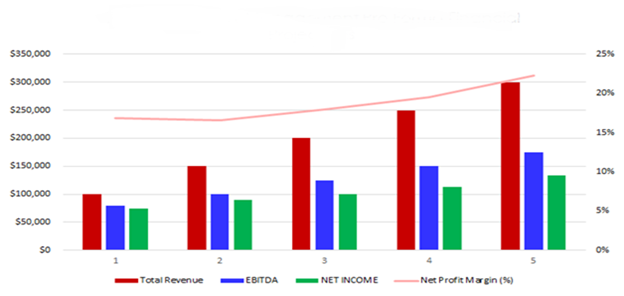
Company Overview
Who is premium advertising agency.
Premium Advertising Agency is a newly established, full-service advertising agency in Cincinnati, Ohio. Premium Advertising Agency will be the most reliable, effective, and results-driven choice for all businesses in Cincinnati and the surrounding communities. Premium Advertising Agency will provide a comprehensive menu of advertising and marketing services for any business, large or small, to utilize. Their full-service approach includes a comprehensive array of customized campaigns.
Premium Advertising Agency will be able to actively manage every client account, with dedication to the unique needs of each client. The team of professionals are highly qualified and experienced in marketing and advertising across all traditional methods and digital platforms, as well. Premium Advertising Agency removes all the typical headaches and issues of advertising and marketing and ensures effective solutions are provided, while delivering the best customer service at the same time.
Premium Advertising Agency History
Since incorporation, Premium Advertising Agency has achieved the following milestones:
- Registered Premium Advertising Agency, LLC to transact business in the state of California.
- Has a contract in place for a 20,000 square foot office in a midtown building.
- Reached out to numerous contacts and former clients to spread the word and follow Premium Advertising Agency to their new location.
- Began recruiting a staff of fifteen account managers and six office personnel to work at Premium Advertising Agency.
Premium Advertising Agency Services
The following will be the services Premium Advertising Agency will provide:
Industry Analysis
The advertising agency industry is expected to grow over the next five years to over $500 billion. The growth will be driven by an increased dependency on social media marketing and various forms of digital campaigns. These will replace some traditional forms of advertising and marketing. The growth will also be driven by an increased number of customers who view the internet for a variety of purposes, where advertisements can be strategically placed to influence buying decisions. The growth will also be driven by the application of technological solutions and invitations to consumers not yet known. The growth will be driven by fewer brick-and-mortar stores and an increase in online purchases and marketing campaigns thus directed. Costs will likely be reduced as digital platforms and consumer invitations will become more plentiful and thus, less expensive to produce.
Customer Analysis
Demographic profile of target market.
Premium Advertising Agency will target the businesses in Cincinnati, Ohio. They will target marketing directors and executive personnel of companies. They will target startup companies that are diverse, woman-owned or veteran-owned. They will target associations and trade show events where personal meetings with executives can take place.
| Total | Percent | |
|---|---|---|
| Total population | 1,680,988 | 100% |
| Male | 838,675 | 49.9% |
| Female | 842,313 | 50.1% |
| 20 to 24 years | 114,872 | 6.8% |
| 25 to 34 years | 273,588 | 16.3% |
| 35 to 44 years | 235,946 | 14.0% |
| 45 to 54 years | 210,256 | 12.5% |
| 55 to 59 years | 105,057 | 6.2% |
| 60 to 64 years | 87,484 | 5.2% |
| 65 to 74 years | 116,878 | 7.0% |
| 75 to 84 years | 52,524 | 3.1% |
Customer Segmentation
Premium Advertising Agency will primarily target the following customer profiles:
- Businesses in the Cincinnati, Ohio region.
- Marketing directors
- C-suite executives and decision-makers
- Startup company executives of diverse, woman-owned, or veteran-owned businesses
- Marketing association executives and thought leaders
Competitive Analysis
Direct and indirect competitors.
Premium Advertising Agency will face competition from other companies with similar business profiles. A description of each competitor company is below.
Boone & Stratton Advertising
Boone & Stratton Advertising provides comprehensive marketing and advertising services within Cincinnati, Ohio and the surrounding communities. The company is over 100 years old and is entrenched with family members of both original partners, Madison Boone and Jeremy Stratton. The company has 100 advertising managers, who primarily focus on traditional advertising methods in print, telephone, and added-value inserts in publications. The company leases a multi-story building in the downtown area of Cincinnati and is known for the “team spirit” of the advertising account managers and rigorous standards of professionalism required of each by the executive board members.
Although Boone & Stratton Advertising is well-entrenched in the Cincinnati business landscape, the company does not engage in digital marketing or social media outreach campaigns. This leaves the opening for newer, innovative companies to enter their space and engage with their customers, particularly if companies are targeting younger demographic audiences.
SportsSupport Ad Agency
The SportsSupport Ad Agency is a company that focuses on the sports industry throughout the U.S. The Cincinnati location is one of 25 within this national chain advertising agency and the focus for this location is on regional sports clients. The advertising agency has highly-segmented sports apparel clients directed toward outdoor winter activities, as well as spring, summer and fall activities that include boats, fishing and accessory clients for those targeted audience segments. SportsSupport Ad Agency uses social media marketing via popular channels and uses certain channels to conduct surveys or to test product ideas. Most of the campaigns are directed toward the executives within the industries related to sports and their ad budgets for the yearly track of traditional advertisements.
XYZ Digital Promotions
XYZ Digital Promotions is a social media marketing agency located in Cincinnati, Ohio. The company targets the brand managers who oversee products that appeal to younger demographic customers. XYZ Digital Promotions claims to effectively enter and invite that target market better than any other advertising agency. XYZ Digital Promotions targets and partners with executives of beer, music festivals, streetwear, and hip hop music labels to bring the message to consumers via structured and direct digital campaigns.
XYZ Digital Promotions was founded in 2020 during the global pandemic. The brand messages offered to consumers were on-point and spoke to their “human condition,” as well as pointing to a variety of products to solve or provide solace for those hard conditions. Campaigns include new music cuts and contain an array of references to popular stars of the year, with memes and graphic art elements to most campaigns. XYZ Digital Promotions is a highly-segmented, successful advertising and marketing company directed to the consumer aged 17-25.
Competitive Advantage
Premium Advertising Agency will be able to offer the following advantages over their competition:
- Innovative techniques that solve the advertising issues of today’s consumer groups
Marketing Plan
Brand & value proposition.
Premium Advertising Agency will offer the unique value proposition to its clientele:
- Highly-qualified team of skilled employees who are able to provide a comprehensive array of social media campaigns and traditional advertising techniques to ensure successful growth for their clients.
Promotions Strategy
The promotions strategy for Premium Advertising Agency is as follows:
Word of Mouth/Referrals
Premium Advertising Agency has built up an extensive list of contacts and clients over the years by providing exceptional service and expertise to their account clients. Premium Advertising Agency invites former and current clients to follow them to the new company and help spread the word of the Premium Advertising Agency.
Professional Associations and Networking
Premium Advertising Agency will embark on a thorough campaign to network extensively through regional association and business groups. They will also target marketing directors and executive personnel within those same business groups. They will target startup companies that are diverse, woman-owned or veteran-owned.
Website/SEO Marketing
Premium Advertising Agency will fully utilize their website. The website will be well organized, informative, and list all the services that Premium Advertising Agency provides. The website will also list their contact information. Agency brand managers, and list their top-tier brand alliances. The Premium Advertising Agency’s website presence will engage SEO marketing tactics so that anytime someone types in the Google or Bing search engine “advertising agency” or “marketing company near me”, Premium Advertising Agency will be listed at the top of the search results.
The pricing of Premium Advertising Agency will be moderate and on par with competitors so customers feel they receive excellent value when purchasing their services.
Operations Plan
The following will be the operations plan for Premium Advertising Agency. Operation Functions:
- Patricia Swanson will be the President and co-owner of the company. Danielle Swanson will be the Vice President and co-owner of the company. They will oversee all staff and manage client relations. Danielle and Patricia have spent the past year recruiting the following staff:
- Jay Jameson, a former associate at their prior employer, will take on the role of the Accounts Manager, directing and assisting Account Representatives.
- Janelle Meredith, a former associate, will be the Administrative Manager, and will manage the office administration, client files, and provide human resources training.
- Lawrence Slater will be the Staff Accountant, providing all client accounting, tax payments, and monthly financial reporting.
Milestones:
Premium Advertising Agency will have the following milestones completed in the next six months.
- 5/1/202X – Finalize contract to lease office space
- 5/15/202X – Finalize personnel and staff employment contracts for Premium Advertising Agency
- 6/1/202X – Finalize contracts for Premium Advertising Agency clients
- 6/15/202X – Begin networking at industry events
- 6/22/202X – Begin moving into Premium Advertising Agency office
- 7/1/202X – Premium Advertising Agency opens its office for business
Jay Jameson, a former associate at their prior employer, will take on the role of the Accounts Manager, directing and assisting Account Representatives. Janelle Meredith, a former associate, will be the Administrative Manager, and will manage the office administration, client files, and provide human resources training. Lawrence Slater will be the Staff Accountant, providing all client accounting, tax payments, and monthly financial reporting.
Financial Plan
Key revenue & costs.
The revenue drivers for Premium Advertising Agency are the fees they will charge to their clients for their advertising and marketing services.
The cost drivers will be the overhead costs required in order to staff Premium Advertising Agency. The expenses will be the payroll cost, rent, utilities, office supplies, and marketing materials.
Funding Requirements and Use of Funds
Premium Advertising Agency is seeking $200,000 in debt financing to launch its advertising agency. The funding will be dedicated toward securing the office space and purchasing office equipment and supplies. Funding will also be dedicated toward three months of overhead costs to include payroll of the staff, rent, and marketing costs for the print ads and association memberships. The breakout of the funding is below:
Key Assumptions
The following outlines the key assumptions required in order to achieve the revenue and cost numbers in the financials and in order to pay off the startup business loan.
- Number of Clients Per Month: 35
- Average Revenue per Month: $175,000
- Office Lease per Year: $100,000
Financial Projections
Income statement.
| FY 1 | FY 2 | FY 3 | FY 4 | FY 5 | ||
|---|---|---|---|---|---|---|
| Revenues | ||||||
| Total Revenues | $360,000 | $793,728 | $875,006 | $964,606 | $1,063,382 | |
| Expenses & Costs | ||||||
| Cost of goods sold | $64,800 | $142,871 | $157,501 | $173,629 | $191,409 | |
| Lease | $50,000 | $51,250 | $52,531 | $53,845 | $55,191 | |
| Marketing | $10,000 | $8,000 | $8,000 | $8,000 | $8,000 | |
| Salaries | $157,015 | $214,030 | $235,968 | $247,766 | $260,155 | |
| Initial expenditure | $10,000 | $0 | $0 | $0 | $0 | |
| Total Expenses & Costs | $291,815 | $416,151 | $454,000 | $483,240 | $514,754 | |
| EBITDA | $68,185 | $377,577 | $421,005 | $481,366 | $548,628 | |
| Depreciation | $27,160 | $27,160 | $27,160 | $27,160 | $27,160 | |
| EBIT | $41,025 | $350,417 | $393,845 | $454,206 | $521,468 | |
| Interest | $23,462 | $20,529 | $17,596 | $14,664 | $11,731 | |
| PRETAX INCOME | $17,563 | $329,888 | $376,249 | $439,543 | $509,737 | |
| Net Operating Loss | $0 | $0 | $0 | $0 | $0 | |
| Use of Net Operating Loss | $0 | $0 | $0 | $0 | $0 | |
| Taxable Income | $17,563 | $329,888 | $376,249 | $439,543 | $509,737 | |
| Income Tax Expense | $6,147 | $115,461 | $131,687 | $153,840 | $178,408 | |
| NET INCOME | $11,416 | $214,427 | $244,562 | $285,703 | $331,329 |
Balance Sheet
| FY 1 | FY 2 | FY 3 | FY 4 | FY 5 | ||
|---|---|---|---|---|---|---|
| ASSETS | ||||||
| Cash | $154,257 | $348,760 | $573,195 | $838,550 | $1,149,286 | |
| Accounts receivable | $0 | $0 | $0 | $0 | $0 | |
| Inventory | $30,000 | $33,072 | $36,459 | $40,192 | $44,308 | |
| Total Current Assets | $184,257 | $381,832 | $609,654 | $878,742 | $1,193,594 | |
| Fixed assets | $180,950 | $180,950 | $180,950 | $180,950 | $180,950 | |
| Depreciation | $27,160 | $54,320 | $81,480 | $108,640 | $135,800 | |
| Net fixed assets | $153,790 | $126,630 | $99,470 | $72,310 | $45,150 | |
| TOTAL ASSETS | $338,047 | $508,462 | $709,124 | $951,052 | $1,238,744 | |
| LIABILITIES & EQUITY | ||||||
| Debt | $315,831 | $270,713 | $225,594 | $180,475 | $135,356 | |
| Accounts payable | $10,800 | $11,906 | $13,125 | $14,469 | $15,951 | |
| Total Liability | $326,631 | $282,618 | $238,719 | $194,944 | $151,307 | |
| Share Capital | $0 | $0 | $0 | $0 | $0 | |
| Retained earnings | $11,416 | $225,843 | $470,405 | $756,108 | $1,087,437 | |
| Total Equity | $11,416 | $225,843 | $470,405 | $756,108 | $1,087,437 | |
| TOTAL LIABILITIES & EQUITY | $338,047 | $508,462 | $709,124 | $951,052 | $1,238,744 |
Cash Flow Statement
| FY 1 | FY 2 | FY 3 | FY 4 | FY 5 | ||
|---|---|---|---|---|---|---|
| CASH FLOW FROM OPERATIONS | ||||||
| Net Income (Loss) | $11,416 | $214,427 | $244,562 | $285,703 | $331,329 | |
| Change in working capital | ($19,200) | ($1,966) | ($2,167) | ($2,389) | ($2,634) | |
| Depreciation | $27,160 | $27,160 | $27,160 | $27,160 | $27,160 | |
| Net Cash Flow from Operations | $19,376 | $239,621 | $269,554 | $310,473 | $355,855 | |
| CASH FLOW FROM INVESTMENTS | ||||||
| Investment | ($180,950) | $0 | $0 | $0 | $0 | |
| Net Cash Flow from Investments | ($180,950) | $0 | $0 | $0 | $0 | |
| CASH FLOW FROM FINANCING | ||||||
| Cash from equity | $0 | $0 | $0 | $0 | $0 | |
| Cash from debt | $315,831 | ($45,119) | ($45,119) | ($45,119) | ($45,119) | |
| Net Cash Flow from Financing | $315,831 | ($45,119) | ($45,119) | ($45,119) | ($45,119) | |
| Net Cash Flow | $154,257 | $194,502 | $224,436 | $265,355 | $310,736 | |
| Cash at Beginning of Period | $0 | $154,257 | $348,760 | $573,195 | $838,550 | |
| Cash at End of Period | $154,257 | $348,760 | $573,195 | $838,550 | $1,149,286 |
Advertising Agency Business Plan FAQs
What is an advertising agency business plan.
An advertising agency business plan is a plan to start and/or grow your advertising agency business. Among other things, it outlines your business concept, identifies your target customers, presents your marketing plan and details your financial projections.
You can easily complete your Advertising Agency business plan using our Advertising Agency Business Plan Template here .
What are the Main Types of Advertising Agency Businesses?
There are a number of different kinds of advertising agency businesses , some examples include: Full-Service Advertising Agency, Digital Advertising Agency, and Traditional Advertising Agency.
How Do You Get Funding for Your Advertising Agency Business Plan?
Advertising Agency businesses are often funded through small business loans. Personal savings, credit card financing and angel investors are also popular forms of funding.
What are the Steps To Start an Advertising Agency Business?
Starting an advertising agency business can be an exciting endeavor. Having a clear roadmap of the steps to start a business will help you stay focused on your goals and get started faster.
1. Develop An Advertising Agency Business Plan - The first step in starting a business is to create a detailed advertising agency business plan that outlines all aspects of the venture. This should include potential market size and target customers, the services or products you will offer, pricing strategies and a detailed financial forecast.
2. Choose Your Legal Structure - It's important to select an appropriate legal entity for your advertising agency business. This could be a limited liability company (LLC), corporation, partnership, or sole proprietorship. Each type has its own benefits and drawbacks so it’s important to do research and choose wisely so that your advertising agency business is in compliance with local laws.
3. Register Your Advertising Agency Business - Once you have chosen a legal structure, the next step is to register your advertising agency business with the government or state where you’re operating from. This includes obtaining licenses and permits as required by federal, state, and local laws.
4. Identify Financing Options - It’s likely that you’ll need some capital to start your advertising agency business, so take some time to identify what financing options are available such as bank loans, investor funding, grants, or crowdfunding platforms.
5. Choose a Location - Whether you plan on operating out of a physical location or not, you should always have an idea of where you’ll be based should it become necessary in the future as well as what kind of space would be suitable for your operations.
6. Hire Employees - There are several ways to find qualified employees including job boards like LinkedIn or Indeed as well as hiring agencies if needed – depending on what type of employees you need it might also be more effective to reach out directly through networking events.
7. Acquire Necessary Advertising Agency Equipment & Supplies - In order to start your advertising agency business, you'll need to purchase all of the necessary equipment and supplies to run a successful operation.
8. Market & Promote Your Business - Once you have all the necessary pieces in place, it’s time to start promoting and marketing your advertising agency business. This includes creating a website, utilizing social media platforms like Facebook or Twitter, and having an effective Search Engine Optimization (SEO) strategy. You should also consider traditional marketing techniques such as radio or print advertising.
Learn more about how to start a successful advertising agency business:
- How to Start an Advertising Agency

How to Create an Advertising Agency Business Plan
Blog > how to create an advertising agency business plan, table of content, introduction, executive summary, company overview, market analysis, target market and customer analysis, competitor analysis, services and offerings, marketing and sales strategies, operational plan, human resources and talent acquisition, financial projections, budgeting and resource allocation, client acquisition and retention, technology and innovation, risk management and legal compliance, expansion and growth strategies, exit strategy, our other categories.
- Company Valuation
- Pitch Deck Essentials
- Raising Capital
- Startup Guide
- Uncategorized
Reading Time : 24 Min
Business plan 101.
Starting an advertising agency is an exciting venture, but success requires careful planning. A comprehensive business plan is the foundation of your agency’s growth and profitability. In this blog post, we will guide you through the process of creating a well-structured advertising agency business plan that aligns with your goals. As an expert startup consultant service provider, Stellar Business Plans is here to support you in crafting a winning strategy that stands out in the competitive advertising industry.
The executive summary is the gateway to your business plan, offering a concise overview of your agency’s key elements. This section is your chance to make a strong first impression and capture the reader’s attention. While providing an elevator pitch, emphasize the unique aspects of your agency that set it apart from the competition. Include your mission and vision statements, key services, target market, and the most significant financial projections. Keep it brief, engaging, and compelling to entice investors, partners, and potential clients to read further.
Stellar Business Tips:
- Keep the executive summary clear and concise, focusing on the unique value your agency brings to the market.
- Highlight your agency’s key differentiators, such as specialized expertise, innovative approaches, or a client-centric approach.
Example: “XYZ Advertising Agency offers data-driven solutions that deliver up to 30% higher conversion rates for our clients, thanks to our cutting-edge AI-powered ad targeting algorithms.”
The company overview provides essential background information about your advertising agency. Detail the founding story, explaining the inspiration behind your agency and the driving force that led to its establishment. Introduce the key stakeholders, founders, and leadership team, highlighting their expertise and experience in the advertising industry. Clearly state your agency’s mission, vision, and values to showcase your commitment to delivering exceptional services. Additionally, provide insights into your agency’s current status, such as the number of employees, locations, and awards or recognitions received.
- Personalize the company overview by sharing anecdotes or personal experiences that motivated you to start the agency.
- Emphasize your team’s collective strengths and past successes to build trust and credibility.
Example: “Our agency, Stellar Ads, was founded by marketing enthusiasts with a shared passion for creative storytelling. Our team members collectively bring over 50 years of experience in successful advertising campaigns for Fortune 500 companies.”
A thorough market analysis is crucial to understanding the advertising industry’s current state and future trends. Conduct extensive research on market growth rates, industry size, and key drivers shaping the advertising landscape. Identify emerging technologies and digital platforms that are disrupting traditional advertising methods. Gather data on consumer behavior, preferences, and engagement with different advertising channels. Use industry reports, market research, and expert insights to back up your analysis and projections.
- Utilize reputable sources and industry reports for market data and statistics.
- Focus on current and future trends that will impact the advertising industry, such as the rise of mobile advertising or the growth of influencer marketing.
Example: “According to the Global Advertising Market report by Grand View Research, the global advertising market is projected to reach $654.55 billion by 2028, with digital advertising accounting for over 50% of total ad spending.”
Defining your target market is critical for tailoring your advertising strategies to meet specific needs. Identify the primary industries or sectors you want to serve and the demographics of your ideal clients. Create buyer personas to better understand the pain points, challenges, and aspirations of your target audience. Conduct surveys or interviews with potential clients to gain valuable insights into their expectations from an advertising agency. Analyze competitors’ clientele to identify gaps and opportunities for your agency.
- Consider conducting focus groups or beta testing campaigns to gather feedback from potential clients before launch.
- Use social listening tools to monitor online conversations and understand customer sentiment regarding advertising trends and campaigns.
Example: “Our target market includes tech startups and e-commerce businesses in the B2C segment, aged 25-35, who seek innovative and visually captivating ad campaigns to stand out in a competitive market.”
A comprehensive competitor analysis helps you position your agency strategically in the market. Identify direct and indirect competitors, evaluating their strengths, weaknesses, and market share. Study their marketing and sales strategies, service offerings, pricing models, and client retention practices. Identify areas where your agency can excel and differentiate itself from competitors. Highlight your competitive advantages and how you plan to capture market share from established players.
- Use a SWOT analysis to identify your agency’s strengths, weaknesses, opportunities, and threats in comparison to competitors.
- Conduct regular competitor monitoring to stay updated on their new offerings and strategies.
Example: “Competitor A excels in social media marketing, but our agency’s strength lies in data-driven audience targeting, providing clients with a higher return on investment (ROI) through efficient ad spend.”
Detail the breadth and depth of your advertising services, showcasing your expertise in various advertising channels. Describe each service in-depth, including the strategies, tools, and technologies used to deliver exceptional results to clients. Provide case studies and success stories of previous campaigns that demonstrate your agency’s capabilities. Present testimonials or feedback from satisfied clients to build trust and credibility with potential clients.
- Highlight case studies where your agency’s creativity and problem-solving skills resulted in successful campaigns.
- Mention your agency’s adaptability to new advertising platforms and technologies to demonstrate your readiness for future challenges.
Example: “Our comprehensive services encompass digital advertising, content marketing, brand storytelling, and influencer partnerships. In a recent campaign for Client B, we increased brand awareness by 50% through a compelling social media storytelling series.”
A well-crafted marketing and sales strategy is essential for attracting clients and driving business growth. Outline your digital marketing efforts, content marketing, social media presence, and thought leadership initiatives. Leverage search engine optimization (SEO) to increase your agency’s visibility and organic reach. Showcase your agency’s past successes to demonstrate your track record of delivering results. Additionally, develop a sales playbook that outlines your sales team’s strategies, tactics, and target metrics for lead generation and conversion.
- Showcase your agency’s expertise through thought leadership content, such as blog posts, webinars, or whitepapers.
- Leverage client testimonials and case studies in your marketing materials to establish credibility and trust.
Example: “Our marketing strategy includes targeted content marketing and thought leadership webinars that showcase our agency’s expertise in the advertising industry. We consistently engage with our audience on social media platforms to build lasting relationships.”
The operational plan outlines how your agency will function on a day-to-day basis to deliver outstanding services. Define the organizational structure and hierarchy, including the roles and responsibilities of each team member. Emphasize collaboration and cross-functional communication to ensure seamless workflow. Detail the workflow for creating and executing advertising campaigns, from initial client briefings to campaign launch and reporting.
- Emphasize the importance of open communication and collaboration between creative and account teams to deliver cohesive campaigns.
- Implement a project management system to streamline workflow and ensure timely delivery of campaigns.
Example: “Our agency follows an agile project management approach, allowing creative teams to collaborate with account managers and clients in real-time, resulting in efficient campaign execution and streamlined processes.”
An advertising agency’s success heavily relies on its team of creative professionals, marketers, and account managers. Detail your talent acquisition and retention strategies, emphasizing a culture that fosters creativity, innovation, and growth. Offer competitive compensation packages, professional development opportunities, and incentives to retain top talent. Outline your recruitment process, employee training programs, and mentoring initiatives to nurture and upskill your team.
- Offer flexible work arrangements and a positive work culture to attract and retain diverse talent.
- Encourage continuous learning and skill development to keep your team updated on the latest advertising trends and technologies.
Example: “Our agency provides ongoing training and development programs to nurture our team’s creative and strategic skills. We foster a culture of open communication and creative freedom, ensuring every team member feels valued and motivated.”
Financial projections are essential for demonstrating the agency’s viability and potential return on investment. Provide detailed revenue projections based on your target market and service offerings. Factor in pricing strategies, growth rates, and market share estimations. Include expense projections, such as salaries, marketing, technology, rent, and overhead costs. Prepare income statements, balance sheets, and cash flow forecasts for multiple years to demonstrate long-term sustainability.
- Use conservative estimates in your financial projections to account for unexpected challenges or market fluctuations.
- Include a sensitivity analysis to understand how changes in key variables may impact your agency’s financial performance.
Example: “Our financial projections indicate a 20% revenue growth in the first year, driven by increased demand for digital advertising services. We anticipate a healthy profit margin of 15%, with prudent cost management.”
A well-managed budget ensures efficient resource allocation and maximizes the return on investments. Develop a detailed budget for various operational and marketing expenses, ensuring they align with your business objectives. Consider potential cost-saving measures and opportunities for strategic investments to fuel growth. Regularly review and adjust your budget based on performance and changing market dynamics.
- Keep a contingency budget for unforeseen circumstances, such as sudden campaign changes or market disruptions.
- Allocate resources based on data and performance metrics to optimize ROI.
Example: “Our budget allocates 30% of total funds for marketing and lead generation efforts, as we aim to expand our client base through targeted campaigns and strategic partnerships.”
Attracting and retaining clients is the lifeblood of an advertising agency. Develop a comprehensive client acquisition plan, including lead generation strategies, outreach initiatives, and networking efforts. Implement a structured client onboarding process to ensure clear communication, expectations, and deliverables. Focus on building long-term relationships and delivering outstanding results to retain clients and encourage referrals.
- Offer attractive referral programs or incentives for clients who refer new business to your agency.
- Establish a client feedback system to continuously improve your services based on client preferences and satisfaction.
Example: “Our agency maintains strong relationships with our clients by providing regular performance reports and conducting satisfaction surveys. We incentivize client referrals with exclusive access to upcoming beta campaigns.”
Advertising is rapidly evolving, driven by technological advancements and digital transformation. Embrace technology to enhance your advertising campaigns and improve data analytics. Adopt advanced tools and platforms for audience targeting, retargeting, and campaign optimization. Stay abreast of emerging technologies and trends to stay competitive and offer innovative solutions to clients.
- Invest in analytics tools to gather data on campaign performance and audience behavior, enabling data-driven decision-making.
- Keep your team updated on the latest advertising technologies through training and workshops.
Example: “Our agency harnesses AI-driven analytics tools to precisely target audiences and optimize campaigns in real-time. Our technology investments allow us to deliver more personalized ad experiences, resulting in higher engagement rates.”
The advertising industry comes with its fair share of risks, from data breaches to campaign performance challenges. Identify potential risks and develop mitigation strategies to minimize their impact on your agency’s operations. Ensure your agency complies with advertising laws, data privacy regulations, and industry standards. Educate your team on ethical advertising practices and transparency in client communications.
- Establish a crisis management plan to address potential reputation-damaging scenarios swiftly and effectively.
- Regularly review and update your agency’s legal compliance policies to stay aligned with changing regulations.
Example: “Our agency employs data encryption protocols and adheres to GDPR guidelines to protect client data and ensure utmost privacy. We have a crisis management team in place to handle any unforeseen challenges.”
To sustain long-term success, consider opportunities for geographic expansion or niche market penetration. Evaluate the feasibility of offering additional services, such as branding, public relations, or content marketing. Explore strategic partnerships or collaborations with complementary agencies to broaden your service offerings and reach new client segments. Assess potential mergers or acquisitions to accelerate growth and expand your agency’s market presence.
- Consider forming partnerships with local businesses or startups to enter new markets and gain regional expertise.
- Leverage industry events and conferences to network and explore potential growth opportunities.
Example: “We plan to expand our agency’s reach by partnering with a boutique PR firm to offer integrated branding and communication solutions for our clients, providing a one-stop-shop experience.”
While it may seem premature, having a well-thought-out exit strategy demonstrates your agency’s long-term planning and vision. Outline your objectives for a potential exit, whether it involves selling the agency, merging with another firm, or transitioning ownership to key team members. Develop a succession plan to ensure a smooth transfer of leadership and continuity for your clients.
- Consult with financial advisors or industry experts to determine the most suitable exit strategy for your agency’s long-term goals.
- Ensure all legal agreements and contracts allow for a seamless transfer of ownership or dissolution.
Example: “Our agency’s exit strategy involves grooming internal talent for future leadership positions and maintaining a strong client-centric focus to ensure client retention in the event of an ownership transition.”
The advertising industry is dynamic and competitive, demanding a well-crafted business plan to navigate its complexities successfully. By following this comprehensive guide and creating a detailed advertising agency business plan, you’ll position your agency for growth, profitability, and long-term success. At Stellar Business Plans, we understand the intricacies of developing effective business strategies. Our team of expert consultants is here to guide you through every step, from market analysis to financial projections, to make your advertising agency thrive. Let’s embark on this exciting journey together, making your mark in the advertising world and achieving extraordinary results for your clients.
Start Your Journey With Us
To know us more.
Updated On : September 1, 2023
Total shares:, average rating :, related posts.
How to Write a Business Plan for a Loan
How to create an airline business plan, how to create an effective amazon fba business plan, how to create an agricultural business plan, how to create an accounting business plan, how to create 3d printing business plan, how to create mcdonalds restaurant business plan, how to create a bbq restaurant business plan, how to create airbnb business plan, how to create a gym business plan: complete guide, how to write a strong executive summary.

13 Reasons why you need a Solid Business Plan
How useful was this post?
Click on a star to rate it!
Average rating 4.3 / 5. Vote count: 16
No votes so far! Be the first to rate this post.
WhatsApp us
Don't bother with copy and paste.
Get this complete sample business plan as a free text document.
Advertising Agency Business Plan
Start your own advertising agency business plan
Promerit Advertising
Executive summary executive summary is a brief introduction to your business plan. it describes your business, the problem that it solves, your target market, and financial highlights.">.
Promerit Advertising will offer marketing services to companies that are looking to employ email marketing techniques as the cornerstone of their marketing program. It is estimated that in Year 1, over 250 billion emails will travel across cyberspace. Email marketing is quickly becoming a cost-effective method to reach a target audience. According to Jupiter Communication research, email ad-response rates currently averages between five to 15 percent. At the same time, the report noted that only 15 percent of Web users read all email messages in their entirety.
The potential is there but so is the risk that the target customer will completely reject the advertising. Email marketing is a science. There are effective strategies that will assure that the company will reach the greatest number of potential customers.
Promerit Advertising specializes in successful email marketing campaigns. Its owners, Robert Humphrey and Cheryl Littlejohn have over eight years of experience in email marketing campaigns between them. Robert was project leader for the successful Buy.com and Verison email marketing campaign. Cheryl was technical lead of 800.com’s successful email campaign before joining Robert as technical lead of the Verison email campaign.
Promerit Advertising will design, build, test and deploy the email campaign. It will also report the progress of the campaign in real-time to provide our customers maximum flexibility. At the end of the campaign, Promerit will analyze its success in order to improve the company’s future campaigns.
1.1 Mission
Promerit Advertising will offer its customers the best methods and tools in planning and implementing a successful email campaign. Our campaigns will cut through the mumbo jumbo of mass marketing, increase sales, and enhance customer satisfaction with the company. Promerit Advertising email campaigns will grab readers immediately and drive home the right message to the right audience. We will exceed our customers’ expectations for campaign returns.

Company Summary company overview ) is an overview of the most important points about your company—your history, management team, location, mission statement and legal structure.">
Promerit Advertising will design, build, test and deploy the email campaign. It will also report the progress of the campaign in real-time to provide our customers maximum flexibility. At the end of the campaign, Promerit will analyze its success in order to improve the company’s future campaigns.
2.1 Company Ownership
Robert Humphrey and Cheryl Littlejohn are the owners of Promerit Advertising.
2.2 Start-up Summary
Robert Humphrey and Cheryl Littlejohn will invest equally in the company. They will also secure a long-term business loan. The following table and chart show projected initial start-up costs of Promerit Advertising.

| Start-up Funding | |
| Start-up Expenses to Fund | $34,500 |
| Start-up Assets to Fund | $165,500 |
| Total Funding Required | $200,000 |
| Assets | |
| Non-cash Assets from Start-up | $10,000 |
| Cash Requirements from Start-up | $155,500 |
| Additional Cash Raised | $0 |
| Cash Balance on Starting Date | $155,500 |
| Total Assets | $165,500 |
| Liabilities and Capital | |
| Liabilities | |
| Current Borrowing | $0 |
| Long-term Liabilities | $100,000 |
| Accounts Payable (Outstanding Bills) | $0 |
| Other Current Liabilities (interest-free) | $0 |
| Total Liabilities | $100,000 |
| Capital | |
| Planned Investment | |
| Robert Humphrey | $50,000 |
| Cheryl Littlejohn | $50,000 |
| Other | $0 |
| Additional Investment Requirement | $0 |
| Total Planned Investment | $100,000 |
| Loss at Start-up (Start-up Expenses) | ($34,500) |
| Total Capital | $65,500 |
| Total Capital and Liabilities | $165,500 |
| Total Funding | $200,000 |
| Start-up | |
| Requirements | |
| Start-up Expenses | |
| Legal | $1,000 |
| Stationery etc. | $1,000 |
| Brochures | $1,000 |
| Advertising | $20,000 |
| Expensed Computer Equipment/Software | $10,000 |
| Insurance | $0 |
| Rent | $1,500 |
| Research and Development | $0 |
| Other | $0 |
| Total Start-up Expenses | $34,500 |
| Start-up Assets | |
| Cash Required | $155,500 |
| Other Current Assets | $10,000 |
| Long-term Assets | $0 |
| Total Assets | $165,500 |
| Total Requirements | $200,000 |
The services offered by Promerit Advertising cover an email marketing project in its entirety, from original concept to post-campaign evaluation. The service includes the following:
- Design the campaign
- Personalization and targeting
- Email list management
- Building deployment system
- Testing the plan
- Implementing the campaign
- Tracking the campaign’s progress in real-time
- Instant measurability for ROI analysis
- Post-campaign analysis
Market Analysis Summary how to do a market analysis for your business plan.">
It was recently reported in an eMarketeer online advertising report that online promotions are very powerful with offline companies, as well as online companies. Though offline companies are offering promotions that necessitate the customer going to one of the company’s stores, consumers feel positive about the online promotions. This opens up a new avenue for these companies to target customer groups that use computers at work and at home.
Consumers said they cared mostly about return policies, customer service, and product selection. A very impressive 94 percent of surveyed users reported they have shopped online before. About 76 percent of those surveyed said promotions were a positive influence on their buying behavior. Some 50 percent said online coupons were especially persuasive while 70 percent found offline coupons equally attractive.
An email campaign can be used to reach target customers no matter how small a company’s Internet presence is, as long as the customer wants the product.
4.1 Market Segmentation
There are two distinct customer groups that Promerit Advertising is focused on:
- Online companies with e-commerce
- Offline companies
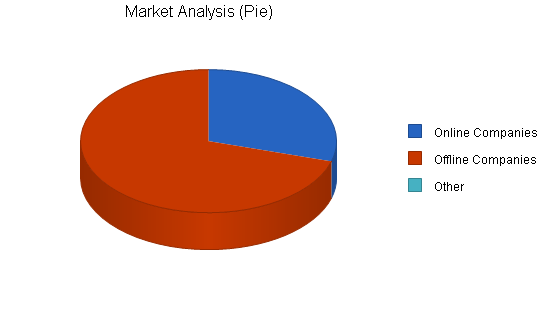
| Market Analysis | |||||||
| Year 1 | Year 2 | Year 3 | Year 4 | Year 5 | |||
| Potential Customers | Growth | CAGR | |||||
| Online Companies | 30% | 630,900 | 820,170 | 1,066,221 | 1,386,087 | 1,801,913 | 30.00% |
| Offline Companies | 0% | 1,500,700 | 1,500,700 | 1,500,700 | 1,500,700 | 1,500,700 | 0.00% |
| Other | 0% | 0 | 0 | 0 | 0 | 0 | 0.00% |
| Total | 11.57% | 2,131,600 | 2,320,870 | 2,566,921 | 2,886,787 | 3,302,613 | 11.57% |
4.2 Service Business Analysis
By any measure, the Internet is one of the fastest-growing commercial phenomena ever witnessed by society. Host computers, or servers, have exploded from 3.2 million in 1994 to roughly 79.2 million as of July 2001. During the same time period, the number of websites roared to more than 6 million from only 3,000.
A key factor in the recent growth of the Internet is the popularity of the sub-$1,000 PC. Rapidly falling component prices have allowed PC manufacturers to pass cost savings on to their customers, resulting in a more attractively priced product. Computers sold at or below the $1,000 level have appealed to first-time PC users and lower income families. Because of the more affordable prices, PC penetration in the United States is now approximately 50%, according to Dataquest, a market research firm based in San Jose, California.
The United States accounts for more than half of the world’s total Internet users. When consumers today are asked why they purchased a personal computer, the most common answer is to connect to the Internet to get their email.
Strategy and Implementation Summary
Promerit Advertising’s strategy is to utilize the extensive network of contacts both Robert and Cheryl have with companies already sold on the value of email marketing. In addition, Promerit will use its internal expertise to launch an email marketing campaign directed at a select group of its target customers.
5.1 Marketing Strategy
With over two million potential customers, Promerit Advertising will focus an email campaign on a select group of 50,000 businesses each fiscal quarter. We estimate a five percent response rate to the campaign which will generate 1,250 leads. These leads will then be used to generate business contacts. Over the year, we will generate 5,000 leads.
5.2 Sales Strategy
Promerit Advertising’s sales strategy is simple. We will use the email marketing campaign directed at our customer base as a model of what we can accomplish for them. We anticipate that online companies will be most accessible to our services. We will be successful with offline companies overtime, but initially sales will be weak with this group.
5.2.1 Sales Forecast

| Sales Forecast | |||
| Year 1 | Year 2 | Year 3 | |
| Sales | |||
| Online Companies | $178,830 | $270,000 | $360,000 |
| Offline Companies | $47,000 | $100,000 | $170,000 |
| Total Sales | $225,830 | $370,000 | $530,000 |
| Direct Cost of Sales | Year 1 | Year 2 | Year 3 |
| Online Companies | $0 | $0 | $0 |
| Offline Companies | $0 | $0 | $0 |
| Subtotal Direct Cost of Sales | $0 | $0 | $0 |
5.3 Competitive Edge
Robert Humphrey has five years of experience in email marketing campaigns and ten years of experience in direct marketing. He is a graduate of Ohio State University with a BA in marketing. Robert worked with several advertising companies before arriving at Kemp and Johnson Advertising in 1997. With Kemp and Johnson, Robert created and grew the Internet marketing group. Robert was project leader for the successful Buy.com and Verison email marketing campaign.
Cheryl Littlejohn graduated with a BS in computer science from UCLA in 1996. She immediately went to work for the Internet start-up Temple Communication as an IT administrator. She left in 1998 to join the start-up 800.com as the technical lead of its email campaign. In 2000, she joined Richard’s Internet group at Kemp and Johnson as technical lead of the Verison email marketing campaign.
Email marketing is an emerging marketing tool with few industry experts. Robert and Cheryl’s accomplishments over the past three years has been singled out by the industry as models for successful email marketing campaigns.
Management Summary management summary will include information about who's on your team and why they're the right people for the job, as well as your future hiring plans.">
Robert Humphrey will be responsible for tactical elements of the marketing campaign and Cheryl Littlejohn will manage the technical aspects of the campaign.
6.1 Personnel Plan
In addition to Robert and Cheryl, there will be three other staff members:
- Secretary/Receptionist
- Salesperson
| Personnel Plan | |||
| Year 1 | Year 2 | Year 3 | |
| Robert Humphrey | $32,000 | $40,000 | $45,000 |
| Cheryl Littlejohn | $32,000 | $40,000 | $45,000 |
| Secretary/Receptionist | $20,000 | $25,000 | $28,000 |
| Salesperson | $38,000 | $50,000 | $55,000 |
| Bookkeeper | $20,000 | $26,000 | $29,000 |
| Other | $0 | $0 | $0 |
| Total People | 5 | 5 | 0 |
| Total Payroll | $142,000 | $181,000 | $202,000 |
Financial Plan investor-ready personnel plan .">
The financial plan is presented in the following topics.
7.1 Break-even Analysis
The monthly sales break-even point is is shown in the table and chart below.

| Break-even Analysis | |
| Monthly Revenue Break-even | $19,308 |
| Assumptions: | |
| Average Percent Variable Cost | 0% |
| Estimated Monthly Fixed Cost | $19,308 |
7.2 Projected Profit and Loss
The following table and charts outline the projected profit and loss for three years. We estimate that the agency will not be profitable until the second year of operation. Promerit Advertising will then grow by about 9% for the second and third year.

| Pro Forma Profit and Loss | |||
| Year 1 | Year 2 | Year 3 | |
| Sales | $225,830 | $370,000 | $530,000 |
| Direct Cost of Sales | $0 | $0 | $0 |
| Other Production Expenses | $0 | $0 | $0 |
| Total Cost of Sales | $0 | $0 | $0 |
| Gross Margin | $225,830 | $370,000 | $530,000 |
| Gross Margin % | 100.00% | 100.00% | 100.00% |
| Expenses | |||
| Payroll | $142,000 | $181,000 | $202,000 |
| Sales and Marketing and Other Expenses | $48,000 | $60,000 | $80,000 |
| Depreciation | $0 | $0 | $0 |
| Leased Equipment | $0 | $0 | $0 |
| Utilities | $2,400 | $2,400 | $2,400 |
| Insurance | $0 | $0 | $0 |
| Rent | $18,000 | $18,000 | $18,000 |
| Payroll Taxes | $21,300 | $27,150 | $30,300 |
| Other | $0 | $0 | $0 |
| Total Operating Expenses | $231,700 | $288,550 | $332,700 |
| Profit Before Interest and Taxes | ($5,870) | $81,450 | $197,300 |
| EBITDA | ($5,870) | $81,450 | $197,300 |
| Interest Expense | $8,916 | $6,999 | $4,999 |
| Taxes Incurred | $0 | $22,335 | $57,690 |
| Net Profit | ($14,786) | $52,115 | $134,611 |
| Net Profit/Sales | -6.55% | 14.09% | 25.40% |
7.3 Projected Cash Flow
The following table and chart highlight the projected cash flow for three years.

| Pro Forma Cash Flow | |||
| Year 1 | Year 2 | Year 3 | |
| Cash Received | |||
| Cash from Operations | |||
| Cash Sales | $56,458 | $92,500 | $132,500 |
| Cash from Receivables | $124,685 | $248,971 | $365,839 |
| Subtotal Cash from Operations | $181,143 | $341,471 | $498,339 |
| Additional Cash Received | |||
| Sales Tax, VAT, HST/GST Received | $0 | $0 | $0 |
| New Current Borrowing | $0 | $0 | $0 |
| New Other Liabilities (interest-free) | $0 | $0 | $0 |
| New Long-term Liabilities | $0 | $0 | $0 |
| Sales of Other Current Assets | $0 | $0 | $0 |
| Sales of Long-term Assets | $0 | $0 | $0 |
| New Investment Received | $0 | $0 | $0 |
| Subtotal Cash Received | $181,143 | $341,471 | $498,339 |
| Expenditures | Year 1 | Year 2 | Year 3 |
| Expenditures from Operations | |||
| Cash Spending | $142,000 | $181,000 | $202,000 |
| Bill Payments | $90,432 | $133,818 | $188,745 |
| Subtotal Spent on Operations | $232,432 | $314,818 | $390,745 |
| Additional Cash Spent | |||
| Sales Tax, VAT, HST/GST Paid Out | $0 | $0 | $0 |
| Principal Repayment of Current Borrowing | $0 | $0 | $0 |
| Other Liabilities Principal Repayment | $0 | $0 | $0 |
| Long-term Liabilities Principal Repayment | $20,004 | $20,004 | $20,004 |
| Purchase Other Current Assets | $0 | $0 | $0 |
| Purchase Long-term Assets | $0 | $0 | $0 |
| Dividends | $0 | $0 | $0 |
| Subtotal Cash Spent | $252,436 | $334,822 | $410,749 |
| Net Cash Flow | ($71,294) | $6,649 | $87,590 |
| Cash Balance | $84,206 | $90,856 | $178,446 |
7.4 Projected Balance Sheet
The table shows projected balance sheet for three years.
| Pro Forma Balance Sheet | |||
| Year 1 | Year 2 | Year 3 | |
| Assets | |||
| Current Assets | |||
| Cash | $84,206 | $90,856 | $178,446 |
| Accounts Receivable | $44,688 | $73,216 | $104,877 |
| Other Current Assets | $10,000 | $10,000 | $10,000 |
| Total Current Assets | $138,894 | $174,072 | $293,323 |
| Long-term Assets | |||
| Long-term Assets | $0 | $0 | $0 |
| Accumulated Depreciation | $0 | $0 | $0 |
| Total Long-term Assets | $0 | $0 | $0 |
| Total Assets | $138,894 | $174,072 | $293,323 |
| Liabilities and Capital | Year 1 | Year 2 | Year 3 |
| Current Liabilities | |||
| Accounts Payable | $8,184 | $11,251 | $15,895 |
| Current Borrowing | $0 | $0 | $0 |
| Other Current Liabilities | $0 | $0 | $0 |
| Subtotal Current Liabilities | $8,184 | $11,251 | $15,895 |
| Long-term Liabilities | $79,996 | $59,992 | $39,988 |
| Total Liabilities | $88,180 | $71,243 | $55,883 |
| Paid-in Capital | $100,000 | $100,000 | $100,000 |
| Retained Earnings | ($34,500) | ($49,286) | $2,829 |
| Earnings | ($14,786) | $52,115 | $134,611 |
| Total Capital | $50,714 | $102,829 | $237,440 |
| Total Liabilities and Capital | $138,894 | $174,072 | $293,323 |
| Net Worth | $50,714 | $102,829 | $237,440 |
7.5 Business Ratios
Business ratios for the years of this plan are shown below. Industry profile ratios based on the Standard Industrial Classification (SIC) code 7311, Advertising Agencies, are shown for comparison.
| Ratio Analysis | ||||
| Year 1 | Year 2 | Year 3 | Industry Profile | |
| Sales Growth | 0.00% | 63.84% | 43.24% | 8.50% |
| Percent of Total Assets | ||||
| Accounts Receivable | 32.17% | 42.06% | 35.75% | 36.20% |
| Other Current Assets | 7.20% | 5.74% | 3.41% | 42.20% |
| Total Current Assets | 100.00% | 100.00% | 100.00% | 80.80% |
| Long-term Assets | 0.00% | 0.00% | 0.00% | 19.20% |
| Total Assets | 100.00% | 100.00% | 100.00% | 100.00% |
| Current Liabilities | 5.89% | 6.46% | 5.42% | 42.90% |
| Long-term Liabilities | 57.60% | 34.46% | 13.63% | 13.00% |
| Total Liabilities | 63.49% | 40.93% | 19.05% | 55.90% |
| Net Worth | 36.51% | 59.07% | 80.95% | 44.10% |
| Percent of Sales | ||||
| Sales | 100.00% | 100.00% | 100.00% | 100.00% |
| Gross Margin | 100.00% | 100.00% | 100.00% | 0.00% |
| Selling, General & Administrative Expenses | 106.55% | 85.91% | 74.60% | 81.60% |
| Advertising Expenses | 21.25% | 16.22% | 15.09% | 3.50% |
| Profit Before Interest and Taxes | -2.60% | 22.01% | 37.23% | 2.50% |
| Main Ratios | ||||
| Current | 16.97 | 15.47 | 18.45 | 1.67 |
| Quick | 16.97 | 15.47 | 18.45 | 1.39 |
| Total Debt to Total Assets | 63.49% | 40.93% | 19.05% | 55.90% |
| Pre-tax Return on Net Worth | -29.16% | 72.40% | 80.99% | 5.70% |
| Pre-tax Return on Assets | -10.65% | 42.77% | 65.56% | 12.80% |
| Additional Ratios | Year 1 | Year 2 | Year 3 | |
| Net Profit Margin | -6.55% | 14.09% | 25.40% | n.a |
| Return on Equity | -29.16% | 50.68% | 56.69% | n.a |
| Activity Ratios | ||||
| Accounts Receivable Turnover | 3.79 | 3.79 | 3.79 | n.a |
| Collection Days | 56 | 78 | 82 | n.a |
| Accounts Payable Turnover | 12.05 | 12.17 | 12.17 | n.a |
| Payment Days | 27 | 26 | 26 | n.a |
| Total Asset Turnover | 1.63 | 2.13 | 1.81 | n.a |
| Debt Ratios | ||||
| Debt to Net Worth | 1.74 | 0.69 | 0.24 | n.a |
| Current Liab. to Liab. | 0.09 | 0.16 | 0.28 | n.a |
| Liquidity Ratios | ||||
| Net Working Capital | $130,710 | $162,821 | $277,428 | n.a |
| Interest Coverage | -0.66 | 11.64 | 39.47 | n.a |
| Additional Ratios | ||||
| Assets to Sales | 0.62 | 0.47 | 0.55 | n.a |
| Current Debt/Total Assets | 6% | 6% | 5% | n.a |
| Acid Test | 11.51 | 8.96 | 11.86 | n.a |
| Sales/Net Worth | 4.45 | 3.60 | 2.23 | n.a |
| Dividend Payout | 0.00 | 0.00 | 0.00 | n.a |
| Sales Forecast | |||||||||||||
| Month 1 | Month 2 | Month 3 | Month 4 | Month 5 | Month 6 | Month 7 | Month 8 | Month 9 | Month 10 | Month 11 | Month 12 | ||
| Sales | |||||||||||||
| Online Companies | 0% | $6,000 | $6,000 | $10,900 | $12,030 | $14,400 | $16,000 | $16,000 | $17,000 | $18,000 | $19,000 | $20,500 | $23,000 |
| Offline Companies | 0% | $0 | $0 | $0 | $0 | $4,000 | $5,000 | $4,000 | $6,000 | $6,000 | $5,000 | $7,000 | $10,000 |
| Total Sales | $6,000 | $6,000 | $10,900 | $12,030 | $18,400 | $21,000 | $20,000 | $23,000 | $24,000 | $24,000 | $27,500 | $33,000 | |
| Direct Cost of Sales | Month 1 | Month 2 | Month 3 | Month 4 | Month 5 | Month 6 | Month 7 | Month 8 | Month 9 | Month 10 | Month 11 | Month 12 | |
| Online Companies | $0 | $0 | $0 | $0 | $0 | $0 | $0 | $0 | $0 | $0 | $0 | $0 | |
| Offline Companies | $0 | $0 | $0 | $0 | $0 | $0 | $0 | $0 | $0 | $0 | $0 | $0 | |
| Subtotal Direct Cost of Sales | $0 | $0 | $0 | $0 | $0 | $0 | $0 | $0 | $0 | $0 | $0 | $0 | |
| Personnel Plan | |||||||||||||
| Month 1 | Month 2 | Month 3 | Month 4 | Month 5 | Month 6 | Month 7 | Month 8 | Month 9 | Month 10 | Month 11 | Month 12 | ||
| Robert Humphrey | 0% | $2,000 | $2,000 | $2,000 | $2,000 | $3,000 | $3,000 | $3,000 | $3,000 | $3,000 | $3,000 | $3,000 | $3,000 |
| Cheryl Littlejohn | 0% | $2,000 | $2,000 | $2,000 | $2,000 | $3,000 | $3,000 | $3,000 | $3,000 | $3,000 | $3,000 | $3,000 | $3,000 |
| Secretary/Receptionist | 0% | $0 | $0 | $2,000 | $2,000 | $2,000 | $2,000 | $2,000 | $2,000 | $2,000 | $2,000 | $2,000 | $2,000 |
| Salesperson | 0% | $0 | $0 | $3,000 | $3,000 | $4,000 | $4,000 | $4,000 | $4,000 | $4,000 | $4,000 | $4,000 | $4,000 |
| Bookkeeper | 0% | $0 | $0 | $2,000 | $2,000 | $2,000 | $2,000 | $2,000 | $2,000 | $2,000 | $2,000 | $2,000 | $2,000 |
| Other | 0% | $0 | $0 | $0 | $0 | $0 | $0 | $0 | $0 | $0 | $0 | $0 | $0 |
| Total People | 5 | 5 | 5 | 5 | 5 | 5 | 5 | 5 | 5 | 5 | 5 | 5 | |
| Total Payroll | $4,000 | $4,000 | $11,000 | $11,000 | $14,000 | $14,000 | $14,000 | $14,000 | $14,000 | $14,000 | $14,000 | $14,000 | |
| General Assumptions | |||||||||||||
| Month 1 | Month 2 | Month 3 | Month 4 | Month 5 | Month 6 | Month 7 | Month 8 | Month 9 | Month 10 | Month 11 | Month 12 | ||
| Plan Month | 1 | 2 | 3 | 4 | 5 | 6 | 7 | 8 | 9 | 10 | 11 | 12 | |
| Current Interest Rate | 10.00% | 10.00% | 10.00% | 10.00% | 10.00% | 10.00% | 10.00% | 10.00% | 10.00% | 10.00% | 10.00% | 10.00% | |
| Long-term Interest Rate | 10.00% | 10.00% | 10.00% | 10.00% | 10.00% | 10.00% | 10.00% | 10.00% | 10.00% | 10.00% | 10.00% | 10.00% | |
| Tax Rate | 30.00% | 30.00% | 30.00% | 30.00% | 30.00% | 30.00% | 30.00% | 30.00% | 30.00% | 30.00% | 30.00% | 30.00% | |
| Other | 0 | 0 | 0 | 0 | 0 | 0 | 0 | 0 | 0 | 0 | 0 | 0 | |
| Pro Forma Profit and Loss | |||||||||||||
| Month 1 | Month 2 | Month 3 | Month 4 | Month 5 | Month 6 | Month 7 | Month 8 | Month 9 | Month 10 | Month 11 | Month 12 | ||
| Sales | $6,000 | $6,000 | $10,900 | $12,030 | $18,400 | $21,000 | $20,000 | $23,000 | $24,000 | $24,000 | $27,500 | $33,000 | |
| Direct Cost of Sales | $0 | $0 | $0 | $0 | $0 | $0 | $0 | $0 | $0 | $0 | $0 | $0 | |
| Other Production Expenses | $0 | $0 | $0 | $0 | $0 | $0 | $0 | $0 | $0 | $0 | $0 | $0 | |
| Total Cost of Sales | $0 | $0 | $0 | $0 | $0 | $0 | $0 | $0 | $0 | $0 | $0 | $0 | |
| Gross Margin | $6,000 | $6,000 | $10,900 | $12,030 | $18,400 | $21,000 | $20,000 | $23,000 | $24,000 | $24,000 | $27,500 | $33,000 | |
| Gross Margin % | 100.00% | 100.00% | 100.00% | 100.00% | 100.00% | 100.00% | 100.00% | 100.00% | 100.00% | 100.00% | 100.00% | 100.00% | |
| Expenses | |||||||||||||
| Payroll | $4,000 | $4,000 | $11,000 | $11,000 | $14,000 | $14,000 | $14,000 | $14,000 | $14,000 | $14,000 | $14,000 | $14,000 | |
| Sales and Marketing and Other Expenses | $4,000 | $4,000 | $4,000 | $4,000 | $4,000 | $4,000 | $4,000 | $4,000 | $4,000 | $4,000 | $4,000 | $4,000 | |
| Depreciation | $0 | $0 | $0 | $0 | $0 | $0 | $0 | $0 | $0 | $0 | $0 | $0 | |
| Leased Equipment | $0 | $0 | $0 | $0 | $0 | $0 | $0 | $0 | $0 | $0 | $0 | $0 | |
| Utilities | $200 | $200 | $200 | $200 | $200 | $200 | $200 | $200 | $200 | $200 | $200 | $200 | |
| Insurance | $0 | $0 | $0 | $0 | $0 | $0 | $0 | $0 | $0 | $0 | $0 | $0 | |
| Rent | $1,500 | $1,500 | $1,500 | $1,500 | $1,500 | $1,500 | $1,500 | $1,500 | $1,500 | $1,500 | $1,500 | $1,500 | |
| Payroll Taxes | 15% | $600 | $600 | $1,650 | $1,650 | $2,100 | $2,100 | $2,100 | $2,100 | $2,100 | $2,100 | $2,100 | $2,100 |
| Other | $0 | $0 | $0 | $0 | $0 | $0 | $0 | $0 | $0 | $0 | $0 | $0 | |
| Total Operating Expenses | $10,300 | $10,300 | $18,350 | $18,350 | $21,800 | $21,800 | $21,800 | $21,800 | $21,800 | $21,800 | $21,800 | $21,800 | |
| Profit Before Interest and Taxes | ($4,300) | ($4,300) | ($7,450) | ($6,320) | ($3,400) | ($800) | ($1,800) | $1,200 | $2,200 | $2,200 | $5,700 | $11,200 | |
| EBITDA | ($4,300) | ($4,300) | ($7,450) | ($6,320) | ($3,400) | ($800) | ($1,800) | $1,200 | $2,200 | $2,200 | $5,700 | $11,200 | |
| Interest Expense | $819 | $806 | $792 | $778 | $764 | $750 | $736 | $722 | $708 | $694 | $681 | $667 | |
| Taxes Incurred | $0 | $0 | $0 | $0 | $0 | $0 | $0 | $0 | $0 | $0 | $0 | $0 | |
| Net Profit | ($5,119) | ($5,106) | ($8,242) | ($7,098) | ($4,164) | ($1,550) | ($2,536) | $478 | $1,492 | $1,506 | $5,019 | $10,533 | |
| Net Profit/Sales | -85.32% | -85.09% | -75.61% | -59.00% | -22.63% | -7.38% | -12.68% | 2.08% | 6.22% | 6.27% | 18.25% | 31.92% | |
| Pro Forma Cash Flow | |||||||||||||
| Month 1 | Month 2 | Month 3 | Month 4 | Month 5 | Month 6 | Month 7 | Month 8 | Month 9 | Month 10 | Month 11 | Month 12 | ||
| Cash Received | |||||||||||||
| Cash from Operations | |||||||||||||
| Cash Sales | $1,500 | $1,500 | $2,725 | $3,008 | $4,600 | $5,250 | $5,000 | $5,750 | $6,000 | $6,000 | $6,875 | $8,250 | |
| Cash from Receivables | $0 | $150 | $4,500 | $4,623 | $8,203 | $9,182 | $13,865 | $15,725 | $15,075 | $17,275 | $18,000 | $18,088 | |
| Subtotal Cash from Operations | $1,500 | $1,650 | $7,225 | $7,630 | $12,803 | $14,432 | $18,865 | $21,475 | $21,075 | $23,275 | $24,875 | $26,338 | |
| Additional Cash Received | |||||||||||||
| Sales Tax, VAT, HST/GST Received | 0.00% | $0 | $0 | $0 | $0 | $0 | $0 | $0 | $0 | $0 | $0 | $0 | $0 |
| New Current Borrowing | $0 | $0 | $0 | $0 | $0 | $0 | $0 | $0 | $0 | $0 | $0 | $0 | |
| New Other Liabilities (interest-free) | $0 | $0 | $0 | $0 | $0 | $0 | $0 | $0 | $0 | $0 | $0 | $0 | |
| New Long-term Liabilities | $0 | $0 | $0 | $0 | $0 | $0 | $0 | $0 | $0 | $0 | $0 | $0 | |
| Sales of Other Current Assets | $0 | $0 | $0 | $0 | $0 | $0 | $0 | $0 | $0 | $0 | $0 | $0 | |
| Sales of Long-term Assets | $0 | $0 | $0 | $0 | $0 | $0 | $0 | $0 | $0 | $0 | $0 | $0 | |
| New Investment Received | $0 | $0 | $0 | $0 | $0 | $0 | $0 | $0 | $0 | $0 | $0 | $0 | |
| Subtotal Cash Received | $1,500 | $1,650 | $7,225 | $7,630 | $12,803 | $14,432 | $18,865 | $21,475 | $21,075 | $23,275 | $24,875 | $26,338 | |
| Expenditures | Month 1 | Month 2 | Month 3 | Month 4 | Month 5 | Month 6 | Month 7 | Month 8 | Month 9 | Month 10 | Month 11 | Month 12 | |
| Expenditures from Operations | |||||||||||||
| Cash Spending | $4,000 | $4,000 | $11,000 | $11,000 | $14,000 | $14,000 | $14,000 | $14,000 | $14,000 | $14,000 | $14,000 | $14,000 | |
| Bill Payments | $237 | $7,119 | $7,140 | $8,141 | $8,142 | $8,563 | $8,550 | $8,536 | $8,522 | $8,508 | $8,494 | $8,480 | |
| Subtotal Spent on Operations | $4,237 | $11,119 | $18,140 | $19,141 | $22,142 | $22,563 | $22,550 | $22,536 | $22,522 | $22,508 | $22,494 | $22,480 | |
| Additional Cash Spent | |||||||||||||
| Sales Tax, VAT, HST/GST Paid Out | $0 | $0 | $0 | $0 | $0 | $0 | $0 | $0 | $0 | $0 | $0 | $0 | |
| Principal Repayment of Current Borrowing | $0 | $0 | $0 | $0 | $0 | $0 | $0 | $0 | $0 | $0 | $0 | $0 | |
| Other Liabilities Principal Repayment | $0 | $0 | $0 | $0 | $0 | $0 | $0 | $0 | $0 | $0 | $0 | $0 | |
| Long-term Liabilities Principal Repayment | $1,667 | $1,667 | $1,667 | $1,667 | $1,667 | $1,667 | $1,667 | $1,667 | $1,667 | $1,667 | $1,667 | $1,667 | |
| Purchase Other Current Assets | $0 | $0 | $0 | $0 | $0 | $0 | $0 | $0 | $0 | $0 | $0 | $0 | |
| Purchase Long-term Assets | $0 | $0 | $0 | $0 | $0 | $0 | $0 | $0 | $0 | $0 | $0 | $0 | |
| Dividends | $0 | $0 | $0 | $0 | $0 | $0 | $0 | $0 | $0 | $0 | $0 | $0 | |
| Subtotal Cash Spent | $5,904 | $12,786 | $19,807 | $20,808 | $23,809 | $24,230 | $24,217 | $24,203 | $24,189 | $24,175 | $24,161 | $24,147 | |
| Net Cash Flow | ($4,404) | ($11,136) | ($12,582) | ($13,178) | ($11,006) | ($9,799) | ($5,352) | ($2,728) | ($3,114) | ($900) | $714 | $2,190 | |
| Cash Balance | $151,096 | $139,960 | $127,378 | $114,199 | $103,193 | $93,395 | $88,043 | $85,316 | $82,202 | $81,302 | $82,016 | $84,206 | |
| Pro Forma Balance Sheet | |||||||||||||
| Month 1 | Month 2 | Month 3 | Month 4 | Month 5 | Month 6 | Month 7 | Month 8 | Month 9 | Month 10 | Month 11 | Month 12 | ||
| Assets | Starting Balances | ||||||||||||
| Current Assets | |||||||||||||
| Cash | $155,500 | $151,096 | $139,960 | $127,378 | $114,199 | $103,193 | $93,395 | $88,043 | $85,316 | $82,202 | $81,302 | $82,016 | $84,206 |
| Accounts Receivable | $0 | $4,500 | $8,850 | $12,525 | $16,925 | $22,522 | $29,090 | $30,225 | $31,750 | $34,675 | $35,400 | $38,025 | $44,688 |
| Other Current Assets | $10,000 | $10,000 | $10,000 | $10,000 | $10,000 | $10,000 | $10,000 | $10,000 | $10,000 | $10,000 | $10,000 | $10,000 | $10,000 |
| Total Current Assets | $165,500 | $165,596 | $158,810 | $149,903 | $141,124 | $135,715 | $132,485 | $128,268 | $127,066 | $126,877 | $126,702 | $130,041 | $138,894 |
| Long-term Assets | |||||||||||||
| Long-term Assets | $0 | $0 | $0 | $0 | $0 | $0 | $0 | $0 | $0 | $0 | $0 | $0 | $0 |
| Accumulated Depreciation | $0 | $0 | $0 | $0 | $0 | $0 | $0 | $0 | $0 | $0 | $0 | $0 | $0 |
| Total Long-term Assets | $0 | $0 | $0 | $0 | $0 | $0 | $0 | $0 | $0 | $0 | $0 | $0 | $0 |
| Total Assets | $165,500 | $165,596 | $158,810 | $149,903 | $141,124 | $135,715 | $132,485 | $128,268 | $127,066 | $126,877 | $126,702 | $130,041 | $138,894 |
| Liabilities and Capital | Month 1 | Month 2 | Month 3 | Month 4 | Month 5 | Month 6 | Month 7 | Month 8 | Month 9 | Month 10 | Month 11 | Month 12 | |
| Current Liabilities | |||||||||||||
| Accounts Payable | $0 | $6,882 | $6,869 | $7,870 | $7,857 | $8,278 | $8,265 | $8,252 | $8,238 | $8,225 | $8,211 | $8,198 | $8,184 |
| Current Borrowing | $0 | $0 | $0 | $0 | $0 | $0 | $0 | $0 | $0 | $0 | $0 | $0 | $0 |
| Other Current Liabilities | $0 | $0 | $0 | $0 | $0 | $0 | $0 | $0 | $0 | $0 | $0 | $0 | $0 |
| Subtotal Current Liabilities | $0 | $6,882 | $6,869 | $7,870 | $7,857 | $8,278 | $8,265 | $8,252 | $8,238 | $8,225 | $8,211 | $8,198 | $8,184 |
| Long-term Liabilities | $100,000 | $98,333 | $96,666 | $94,999 | $93,332 | $91,665 | $89,998 | $88,331 | $86,664 | $84,997 | $83,330 | $81,663 | $79,996 |
| Total Liabilities | $100,000 | $105,215 | $103,535 | $102,869 | $101,189 | $99,943 | $98,263 | $96,583 | $94,902 | $93,222 | $91,541 | $89,861 | $88,180 |
| Paid-in Capital | $100,000 | $100,000 | $100,000 | $100,000 | $100,000 | $100,000 | $100,000 | $100,000 | $100,000 | $100,000 | $100,000 | $100,000 | $100,000 |
| Retained Earnings | ($34,500) | ($34,500) | ($34,500) | ($34,500) | ($34,500) | ($34,500) | ($34,500) | ($34,500) | ($34,500) | ($34,500) | ($34,500) | ($34,500) | ($34,500) |
| Earnings | $0 | ($5,119) | ($10,225) | ($18,467) | ($25,564) | ($29,728) | ($31,278) | ($33,814) | ($33,337) | ($31,845) | ($30,339) | ($25,320) | ($14,786) |
| Total Capital | $65,500 | $60,381 | $55,275 | $47,033 | $39,936 | $35,772 | $34,222 | $31,686 | $32,163 | $33,655 | $35,161 | $40,180 | $50,714 |
| Total Liabilities and Capital | $165,500 | $165,596 | $158,810 | $149,903 | $141,124 | $135,715 | $132,485 | $128,268 | $127,066 | $126,877 | $126,702 | $130,041 | $138,894 |
| Net Worth | $65,500 | $60,381 | $55,275 | $47,033 | $39,936 | $35,772 | $34,222 | $31,686 | $32,163 | $33,655 | $35,161 | $40,180 | $50,714 |

The quickest way to turn a business idea into a business plan
Fill-in-the-blanks and automatic financials make it easy.
No thanks, I prefer writing 40-page documents.

Discover the world’s #1 plan building software
- Starting a Business
Our Top Picks
- Best Small Business Loans
- Best Business Internet Service
- Best Online Payroll Service
- Best Business Phone Systems
Our In-Depth Reviews
- OnPay Payroll Review
- ADP Payroll Review
- Ooma Office Review
- RingCentral Review
Explore More
- Business Solutions
- Entrepreneurship
- Franchising
- Best Accounting Software
- Best Merchant Services Providers
- Best Credit Card Processors
- Best Mobile Credit Card Processors
- Clover Review
- Merchant One Review
- QuickBooks Online Review
- Xero Accounting Review
- Financial Solutions
Human Resources
- Best Human Resources Outsourcing Services
- Best Time and Attendance Software
- Best PEO Services
- Best Business Employee Retirement Plans
- Bambee Review
- Rippling HR Software Review
- TriNet Review
- Gusto Payroll Review
- HR Solutions
Marketing and Sales
- Best Text Message Marketing Services
- Best CRM Software
- Best Email Marketing Services
- Best Website Builders
- Textedly Review
- Salesforce Review
- EZ Texting Review
- Textline Review
- Business Intelligence
- Marketing Solutions
- Marketing Strategy
- Public Relations
- Social Media
- Best GPS Fleet Management Software
- Best POS Systems
- Best Employee Monitoring Software
- Best Document Management Software
- Verizon Connect Fleet GPS Review
- Zoom Review
- Samsara Review
- Zoho CRM Review
- Technology Solutions
Business Basics
- 4 Simple Steps to Valuing Your Small Business
- How to Write a Business Growth Plan
- 12 Business Skills You Need to Master
- How to Start a One-Person Business
- FreshBooks vs. QuickBooks Comparison
- Salesforce CRM vs. Zoho CRM
- RingCentral vs. Zoom Comparison
- 10 Ways to Generate More Sales Leads
Business.com aims to help business owners make informed decisions to support and grow their companies. We research and recommend products and services suitable for various business types, investing thousands of hours each year in this process.
As a business, we need to generate revenue to sustain our content. We have financial relationships with some companies we cover, earning commissions when readers purchase from our partners or share information about their needs. These relationships do not dictate our advice and recommendations. Our editorial team independently evaluates and recommends products and services based on their research and expertise. Learn more about our process and partners here .
Starting an Advertising Agency
Launching an advertising agency is a low-cost way to enter the world of entrepreneurship.

Table of Contents
Every business needs to advertise and spread the word to new customers to keep growing. Some small businesses and startups may need to keep their marketing and advertising needs in-house to start, but external marketing and advertising agencies can bring many benefits to the table, especially for companies looking to expand their reach. Many companies, including small businesses, rely on the expertise of advertising agencies to help them create and execute effective marketing strategies .
In the digital marketing era, ad agencies conduct their business and provide services primarily online, making them both low-cost and COVID-19-friendly. While some agencies prefer to run their operations out of physical locations, traditional Mad Men operations are quickly becoming a thing of the past. This paves the way for more accessible and specialized advertising agencies to cater to a broader range of clients and businesses.
If you’re an aspiring entrepreneur with a background in marketing and communications, here’s what you need to know about starting an advertising agency.
How to start an advertising agency
Once you’ve decided to start your own ad agency, follow these steps.
2. Create a business plan for your advertising agency.
Before you can get up and running, you’ll need to create a detailed business plan to guide your growth and internal strategy.
The three main purposes of a business plan are to establish your business focus, secure funding (if you’re planning to seek investor capital as your agency grows), and attract executive leaders to help you manage your company. Include the following elements in your plan.
- Executive summary: What does your advertising agency do?
- Company description: What defines your company?
- Product/service overview: What services do you offer your clients?
- Market analysis: What kinds of clients does your agency target?
- Financial plan: What are your expected expenses, and how will you make money to sustain operations?
2. Choose your pricing model.
Most advertising agencies make money by brainstorming and developing creative assets for their clients, including traditional advertising campaigns and content marketing pieces, like blogs and social media posts. You can use several pricing models to charge your clients. The best one for you depends on the type of work you do and how you work with your clients. You’ll need to decide if you’ll charge per hour, per project or according to a fixed retainer model, in which a client pays an agreed-upon amount in advance for a certain number of service hours. A flexible or hybrid approach with different payment structures can help you meet clients’ needs while allowing them to stay on budget.
3. Stay on top of the advertising game.
If you subscribe to trade publications, blogs and podcasts geared toward ad agencies, you can keep up with industry events, trends, suppliers and technology. Here are some top advertising blogs to follow, as well as reputable ad industry sources:
- Kissmetrics
4. Join advertising industry trade associations.
Joining a trade association allows you to continue your education, keep up with trends and technology , meet with your peers at trade shows and conventions, and enter awards contests to add to your credentials.
While there are many niche organizations for specific types of advertisers, consider joining one of the following organizations for general advertising and marketing professionals:
- American Advertising Federation
- American Marketing Association
- Association of National Advertisers (ANA)
- Interactive Advertising Bureau (IAB)
5. Find clients for your advertising agency.
Every advertising agency needs clients. Before you start spreading the word about your marketing services, decide what types of businesses you want to work with (in terms of industries, business size, location, services needed and so on). Once you’ve defined your ideal client, research companies that fit your description and study their current advertising efforts.
By going after businesses with a small or lackluster marketing presence, you can offer yourself as a solution for busy entrepreneurs and business leaders who need help taking their advertising to the next level. Highlight the benefits of advertising and demonstrate how good marketing can help your prospects earn new business and grow their revenue.
Once you have a few regular clients, you can politely and professionally request a testimonial or referral to keep expanding your client base through word-of-mouth recommendations.
6. Build your contacts.
If you’re planning to help your clients with ad placements on television, radio shows, podcasts, blogs and news publications, you’ll need to start building a stable of media contacts. From these outlets, collect media kits that list advertising rates, demographics and specs so you know what kinds of campaigns might be appropriate for your clients to place there. Prepare to introduce yourself to sales representatives at the media outlets you plan to use regularly. Create a portfolio of past work, if you have been in the industry, to highlight ad campaigns you’ve worked on in the past and thus make your ad sales meetings go more smoothly.
7. Create an incredible website to sell your services.
Like all modern businesses, your advertising agency needs a robust, informative website that engages potential clients and explains how you can help them with their marketing campaigns. You can go the DIY route and choose one of the many available website-building tools, or hire a professional web designer or digital marketing agency to create a more customized web presence. [Read related article: The Best Website Builders and Design Services of 2024 ]
Either way, you’ll want your small business website to have an appropriate domain name, pages that define who you are and what you offer, a contact form, a payment portal (if you plan to accept client payments through your website), and high-quality, original images to visually communicate your brand.
8. Develop your own marketing plan to advertise your business.
Advertising agencies have a unique advantage over other types of service businesses: Their own marketing and advertising efforts serve as a work sample and let potential clients see upfront what the agency might be able to do for them.
That’s why you need to pull out all the stops for your digital presence and show off your strengths to prospects. For instance, if you offer graphic design services for client ad campaigns, ensure all of the graphic elements of your website and social media are impeccable. If you offer copywriting services, maintain a well-written, SEO-friendly blog on your website so they can see your expertise and writing style.
In other words, let your marketing strategy speak for itself so your agency can keep growing and attracting new clients. [If your target audience is active on Pinterest, learn the do’s and don’ts of advertising on the platform .]
Benefits of starting an advertising agency
There are nearly 14,000 established advertising agencies in the United States, and they generated about $57 billion in 2021, according to U.S. Census Bureau data as reported by Statista . It’s not hard to see why this startup path is so attractive: It’s relatively easy to launch and has the potential for a big payoff.
Here are some benefits of starting an ad agency:
- Low overhead and startup costs. Many agencies operate remotely, so they don’t need to invest in a brick-and-mortar office space. In most cases, your only startup costs will be technology equipment (hardware and software), internet service and any applicable business registration. You don’t need a big team to get started, either. You can run the business and execute a lot of the deliverables yourself, in the beginning, to save money on salaries and wages.
- Large potential client base. Thanks to digital tools, ad agencies can serve clients anywhere in the world. Although the marketing industry is crowded, there are a lot of opportunities to carve out a niche by catering to specific types of businesses, such as restaurants, salons, medical practices or law firms.
- Low barrier to entry. You don’t need years of marketing experience to start a digital advertising agency because the industry is constantly changing. With a baseline knowledge of content marketing and social media, plus a willingness to learn new and emerging platforms, you can make a name for yourself as a professional advertiser.
- Scalability. With a robust team of affordable freelancers and contractors, your agency can scale up quickly and offer full-service marketing campaigns with copywriting, social media, email marketing, graphic design, SEO and more.
Jenni Simcoe contributed to this article.

Get Weekly 5-Minute Business Advice
B. newsletter is your digest of bite-sized news, thought & brand leadership, and entertainment. All in one email.
Our mission is to help you take your team, your business and your career to the next level. Whether you're here for product recommendations, research or career advice, we're happy you're here!
How to write a business plan for an advertising agency?
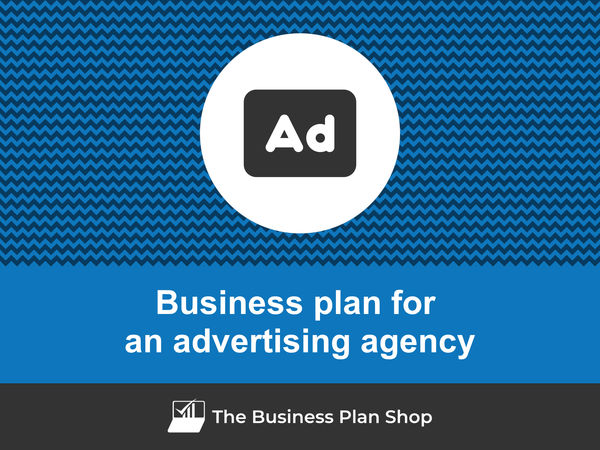
Putting together a business plan for an advertising agency can be daunting - especially if you're creating a business for the first time - but with this comprehensive guide, you'll have the necessary tools to do it confidently.
We will explore why writing one is so important in both starting up and growing an existing advertising agency, as well as what should go into making an effective plan - from its structure to content - and what tools can be used to streamline the process and avoid errors.
Without further ado, let us begin!
In this guide:
Why write a business plan for an advertising agency?
- What information is needed to create a business plan for an advertising agency?
- How do I build a financial forecast for an advertising agency?
The written part of an advertising agency business plan
- What tool should I use to write my advertising agency business plan?
Having a clear understanding of why you want to write a business plan for your advertising agency will make it simpler for you to grasp the rationale behind its structure and content. So before delving into the plan's actual details, let's take a moment to remind ourselves of the primary reasons why you'd want to create an advertising agency business plan.
To have a clear roadmap to grow the business
Running a small business is tough! Economic cycles bring growth and recessions, while the business landscape is ever-changing with new technologies, regulations, competitors, and consumer behaviours emerging constantly.
In such a dynamic context, operating a business without a clear roadmap is akin to driving blindfolded: it's risky, to say the least. That's why crafting a business plan for your advertising agency is vital to establish a successful and sustainable venture.
To create an effective business plan, you'll need to assess your current position (if you're already in business) and define where you want the business to be in the next three to five years.
Once you have a clear destination for your advertising agency, you'll have to:
- Identify the necessary resources (human, equipment, and capital) needed to reach your goals,
- Determine the pace at which the business needs to progress to meet its objectives as scheduled,
- Recognize and address the potential risks you may encounter along the way.
Engaging in this process regularly proves advantageous for both startups and established companies. It empowers you to make informed decisions about resource allocation, ensuring the long-term success of your business.
To get visibility on future cash flows
If your small advertising agency runs out of cash: it's game over. That's why we often say "cash is king", and it's crucial to have a clear view of your advertising agency's future cash flows.
So, how can you achieve this? It's simple - you need to have an up-to-date financial forecast.
The good news is that your advertising agency business plan already includes a financial forecast (which we'll discuss further in this guide). Your task is to ensure it stays current.
To accomplish this, it's essential to regularly compare your actual financial performance with what was planned in your financial forecast. Based on your business's current trajectory, you can make adjustments to the forecast.
By diligently monitoring your advertising agency's financial health, you'll be able to spot potential financial issues, like unexpected cash shortfalls, early on and take corrective actions. Moreover, this practice will enable you to recognize and capitalize on growth opportunities, such as excess cash flow enabling you to expand to new locations.
To secure financing
A detailed business plan becomes a crucial tool when seeking financing from banks or investors for your advertising agency.
Investing and lending to small businesses are very risky activities given how fragile they are. Therefore, financiers have to take extra precautions before putting their capital at risk.
At a minimum, financiers will want to ensure that you have a clear roadmap and a solid understanding of your future cash flows (like we just explained above). But they will also want to ensure that your business plan fits the risk/reward profile they seek.
This will off-course vary from bank to bank and investor to investor, but as a rule of thumb. Banks will want to see a conservative financial management style (low risk), and they will use the information in your business plan to assess your borrowing capacity — the level of debt they think your business can comfortably handle — and your ability to repay the loan. This evaluation will determine whether they'll provide credit to your advertising agency and the terms of the agreement.
Whereas investors will carefully analyze your business plan to gauge the potential return on their investment. Their focus lies on evidence indicating your advertising agency's potential for high growth, profitability, and consistent cash flow generation over time.
Now that you recognize the importance of creating a business plan for your advertising agency, let's explore what information is required to create a compelling plan.
Need a convincing business plan?
The Business Plan Shop makes it easy to create a financial forecast to assess the potential profitability of your projects, and write a business plan that’ll wow investors.
Information needed to create a business plan for an advertising agency
You need the right data in order to project sales, investments and costs accurately in the financial forecast of your advertising agency business plan.
Below, we'll cover three key pieces of information you should gather before drafting your business plan.
Carrying out market research for an advertising agency
Before you begin writing your business plan for an advertising agency, conducting market research is a critical step in ensuring precise and realistic financial projections.
Market research grants you valuable insights into your target customer base, competitors, pricing strategies, and other crucial factors that can impact the success of your business.
In the course of this research, you may stumble upon trends that could impact your advertising agency.
Your market research may reveal that potential clients may be more likely to respond to advertisements featuring modern and relevant design elements, as well as creative, innovative messaging. Additionally, your market research could uncover that potential clients may be more likely to respond to advertisements that focus on personal connections and emotionally engaging content.
Such market trends play a pivotal role in revenue forecasting, as they provide essential data regarding potential customers' spending habits and preferences.
By integrating these findings into your financial projections, you can provide investors with more accurate information, enabling them to make well-informed decisions about investing in your advertising agency.
Developing the sales and marketing plan for an advertising agency
Budgeting sales and marketing expenses is essential before creating an advertising agency business plan.
A comprehensive sales and marketing plan should provide an accurate projection of what actions need to be implemented to acquire and retain customers, how many people are needed to carry out these initiatives, and how much needs to be spent on promotions, advertising, and other aspects.
This helps ensure that the right amount of resources is allocated to these activities in order to hit the sales and growth objectives forecasted in your business plan.
The staffing and capital expenditure requirements of an advertising agency
Whether you are starting or expanding an advertising agency, it is important to have a clear plan for recruitment and capital expenditures (investment in equipment and real estate) in order to ensure the success of the business.
Both the recruitment and investment plans need to be coherent with the timing and level of growth planned in your forecast, and require appropriate funding.
Your advertising agency might incur staffing costs such as hiring creative staff to design advertising campaigns, marketing staff to develop strategies, public relations staff to manage press relations, and administrative staff to manage the day-to-day operations of the agency. In addition, you might incur equipment costs such as computers, software, cameras, video equipment, and other tools used to create and execute your campaigns.
In order to create a realistic financial forecast, you will also need to consider the other operating expenses associated with running the business on a day-to-day basis (insurance, bookkeeping, etc.).
Once you have all the necessary information to create a business plan for your advertising agency, it is time to start creating your financial forecast.
What goes into your advertising agency's financial forecast?
The financial forecast of your advertising agency's business plan will enable you to assess the growth, profitability, funding requirements, and cash generation potential of your business in the coming years.
The four key outputs of a financial forecast for a advertising agency are:
- The profit and loss (P&L) statement ,
- The projected balance sheet ,
- The cash flow forecast ,
- And the sources and uses table .
Let's look at each of these in a bit more detail.
The projected P&L statement
Your advertising agency forecasted P&L statement enables the reader of your business plan to get an idea of how much revenue and profits your business is expected to make in the near future.
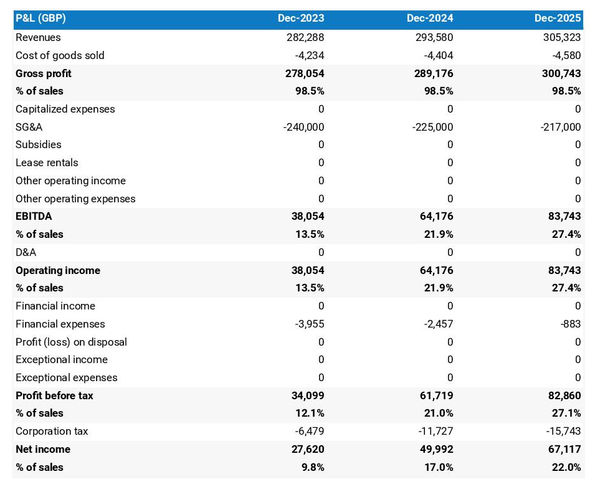
Ideally, your reader will want to see:
- Growth above the inflation level
- Expanding profit margins
- Positive net profit throughout the plan
Expectations for an established advertising agency will of course be different than for a startup. Existing businesses which have reached their cruising altitude might have slower growth and higher margins than ventures just being started.
The forecasted balance sheet of your advertising agency
The projected balance sheet of your advertising agency will enable the reader of your business plan to assess the overall financial health of your business.
It shows three elements: assets, liabilities and equity:
- Assets: are productive resources owned by the business, such as equipment, cash, and accounts receivable (money owed by clients).
- Liabilities: are debts owed to creditors, lenders, and other entities, such as accounts payable (money owed to suppliers).
- Equity: includes the sums invested by the shareholders or business owners and the profits and losses accumulated by the business to date (which are called retained earnings). It is a proxy for the value of the owner's stake in the business.
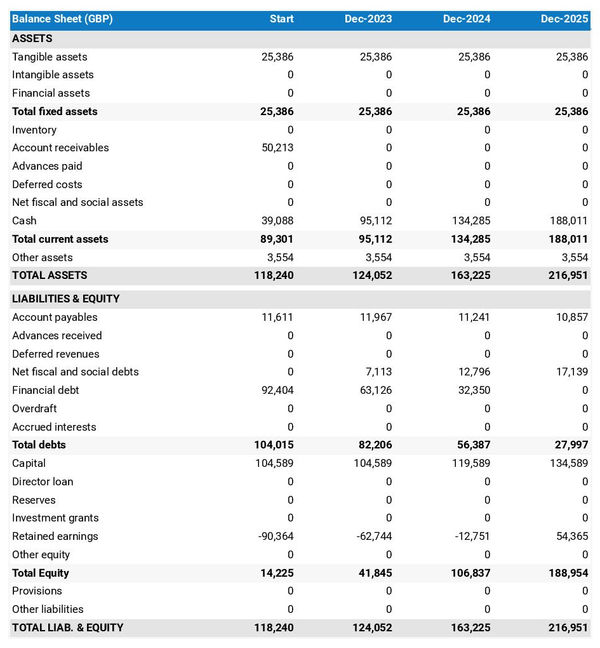
Analysing your advertising agency projected balance sheet provides an understanding of your advertising agency's working capital structure, investment and financing policies.
In particular, the readers of your plan can compare the level of financial debt on the balance sheet to the equity value to measure the level of financial risk (equity doesn't need to be reimbursed, while financial debt must be repaid, making it riskier).
They can also use your balance sheet to assess your advertising agency's liquidity and solvency:
- A liquidity analysis: focuses on whether or not your business has sufficient cash and short-term assets to cover its liabilities due in the next 12 months.
- A solvency analysis: takes and longer view to assess whether or not your business has the capacity to repay its debts over the medium-term.
The projected cash flow statement
A cash flow forecast for an advertising agency shows how much cash the business is projected to generate or consume.
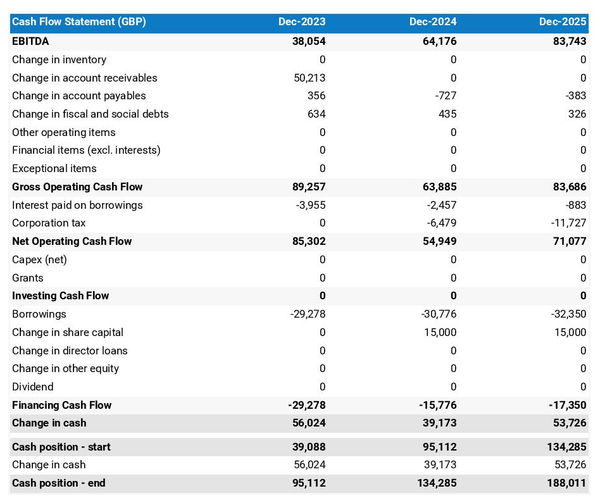
The cash flow statement is divided into 3 main areas:
- The operating cash flow shows how much cash is generated or consumed by the operations (running the business)
- The investing cash flow shows how much cash is being invested in capital expenditure (equipment, real estate, etc.)
- The financing cash flow shows how much cash is raised or distributed to investors and lenders
Looking at the cash flow forecast helps you to ensure that your business has enough cash to keep running, and can help you anticipate potential cash shortfalls.
It is also a best practice to include a monthly cash flow statement in the appendices of your advertising agency business plan so that the readers can view the impact of seasonality on your business cash position and generation.
The initial financing plan
The initial financing plan - also called a sources and uses table - is an important tool when starting an advertising agency.
It shows where the money needed to set up the business will come from (sources) and how it will be allocated (uses).

Having this table helps understand what costs are involved in setting up the advertising agency, how the risks are distributed between the shareholders and the lenders, and what will be the starting cash position (which needs to be sufficient to sustain operations until the business breaks even).
Now that the financial forecast of an advertising agency business plan is understood, let's focus on what goes into the written part of the plan.
The written part of an advertising agency business plan is composed of 7 main sections:
- The executive summary
- The presentation of the company
- The products and services
- The market analysis
- The strategy
- The operations
- The financial plan
Throughout these sections, you will seek to provide the reader with the details and context needed for them to form a view on whether or not your business plan is achievable and your forecast a realistic possibility.
Let's go through the content of each section in more detail!
1. The executive summary
The first section of your advertising agency's business plan is the executive summary which provides, as its name suggests, an enticing summary of your plan which should hook the reader and make them want to know more about your business.
When writing the executive summary, it is important to provide an overview of the business, the market, the key financials, and what you are asking from the reader.
Start with a brief introduction of the business, its name, concept, location, how long it has been in operation, and what makes it unique. Mention any services or products you plan to offer and who you sell to.
Then you should follow with an overview of the addressable market for your advertising agency, current trends, and potential growth opportunities.
You should then include a summary of your key financial figures such as projected revenues, profits, and cash flows.
Finally, you should detail any funding requirements in the ask section.
2. The presentation of the company
The second section in your advertising agency's business plan should focus on the structure and ownership, location, and management team of the company.
The structure and ownership part provides an overview of the legal structure of the business, who the owners are and how much each has invested and owns. If you are seeking financing it is important that the reader gets a clear picture of which legal entity is receiving the funds, and who controls the business.
The location part should give an overview of the premises from which the company is operating, and why that location is of particular interest (catchment area, accessibility, amenities nearby, etc.).
When describing the location of your advertising agency, you could emphasize its proximity to a major metropolitan area, giving it access to a large consumer base.
You may also point out that the area has a diverse population, offering potential clients access to a wide range of potential customers.
Furthermore, you could highlight the area's growing technology sector, and the potential opportunities that come with that. Finally, you might emphasize the affordability of the area, making it a cost effective place to do business.
Finally, you should introduce the management team. Explain each member's role, background, and experience.
It is also important to emphasize any past successes that the members of the management team have achieved, and how long they've been working together, as this will help potential lenders or investors understand why they should trust in their leadership.
3. The products and services section
The products and services section of your advertising agency business plan should include a detailed description of what your company sells to its customers.
For example, your advertising agency might offer services such as creative graphic design, copywriting, and advertising campaign management to its customers.
These services would help customers create strong and attractive visuals for their products and services, craft effective and persuasive ad messages, and coordinate and manage their advertising campaigns to achieve maximum returns.
The reader will want to understand what makes your advertising agency unique from other businesses in this competitive market.
When drafting this section, you should be precise about the categories of products or services you sell, the clients you are targeting and the channels that you are targeting them through.
4. The market analysis
When outlining your market analysis in the advertising agency business plan, it's essential to include comprehensive details about customers' demographics and segmentation, target market, competition, barriers to entry, and relevant regulations.
The primary aim of this section is to give the reader an understanding of the market size and appeal while demonstrating your expertise in the industry.
To begin, delve into the demographics and segmentation subsection, providing an overview of the addressable market for your advertising agency, key marketplace trends, and introducing various customer segments and their preferences in terms of purchasing habits and budgets.
Next, shift your focus to the target market subsection, where you can zoom in on the specific customer segments your advertising agency targets. Explain how your products and services are tailored to meet the unique needs of these customers.
For example, your target market might include startups looking to launch their new products or services, build brand awareness, and establish a strong market presence.
In the competition subsection, introduce your main competitors and explain what sets your advertising agency apart from them.
Finally, round off your market analysis by providing an overview of the main regulations that apply to your advertising agency.
5. The strategy section
When crafting the strategy section of your business plan for your advertising agency, it's important to cover several key aspects, including your competitive edge, pricing strategy, sales & marketing plan, milestones, and risks and mitigants.
In the competitive edge subsection, clearly explain what sets your company apart from competitors. This is particularly critical if you're a startup, as you'll be trying to establish your presence in the marketplace among entrenched players.
The pricing strategy subsection should demonstrate how you aim to maintain profitability while offering competitive prices to your customers.
For the sales & marketing plan, outline how you plan to reach and acquire new customers, as well as retain existing ones through loyalty programs or special offers.
In the milestones subsection, detail what your company has achieved thus far and outline your primary objectives for the coming years by including specific dates for expected progress. This ensures everyone involved has clear expectations.
Lastly, in the risks and mitigants subsection, list the main risks that could potentially impact the execution of your plan. Explain the measures you've taken to minimize these risks. This is vital for investors or lenders to feel confident in supporting your venture - try to proactively address any objection they might have.
Your advertising agency may face the risk of a data breach. Data is a valuable asset for any company, and your business could suffer if it is compromised. It is important to ensure all customer information is protected and that security measures are constantly monitored and updated.
Your advertising agency may also face the risk of losing clients. In order to maintain a healthy business, you must be able to retain customers and attract new ones. Providing quality services and building relationships with clients can help your agency remain competitive and successful.
6. The operations section
The operations of your advertising agency must be presented in detail in your business plan.
The first thing you should cover in this section is your staffing team, the main roles, and the overall recruitment plan to support the growth expected in your business plan. You should also outline the qualifications and experience necessary to fulfil each role, and how you intend to recruit (using job boards, referrals, or headhunters).
You should then state the operating hours of your advertising agency - so that the reader can check the adequacy of your staffing levels - and any plans for varying opening times during peak season. Additionally, the plan should include details on how you will handle customer queries outside of normal operating hours.
The next part of this section should focus on the key assets and IP required to operate your business. If you depend on any licenses or trademarks, physical structures (equipment or property) or lease agreements, these should all go in there.
You may have key assets such as creative talent and branding expertise. These could be valuable IPs for an advertising agency, potentially helping them to differentiate their offering from competitors and create compelling content for clients.
Additionally, your agency could also have proprietary software or processes that might help you to efficiently manage campaigns and track results.
Finally, you should include a list of suppliers that you plan to work with and a breakdown of their services and main commercial terms (price, payment terms, contract duration, etc.). Investors are always keen to know if there is a particular reason why you have chosen to work with a specific supplier (higher-quality products or past relationships for example).
7. The presentation of the financial plan
The financial plan section is where we will include the financial forecast we discussed earlier in this guide.
Now that you have a clear idea of what goes into an advertising agency business plan, let's look at some of the tools you can use to create yours efficiently.
What tool should I use to write my advertising agency's business plan?
There are two main ways of creating your advertising agency business plan:
- Using specialized business planning software,
- Hiring a business plan writer.
Using an online business plan software for your advertising agency's business plan
Using online business planning software is the most efficient and modern way to create an advertising agency business plan.
There are several advantages to using specialized software:
- You can easily create your financial forecast by letting the software take care of the financial calculations for you without errors
- You are guided through the writing process by detailed instructions and examples for each part of the plan
- You can access a library of dozens of complete business plan samples and templates for inspiration
- You get a professional business plan, formatted and ready to be sent to your bank or investors
- You can easily track your actual financial performance against your financial forecast
- You can create scenarios to stress test your forecast's main assumptions
- You can easily update your forecast as time goes by to maintain visibility on future cash flows
- You have a friendly support team on standby to assist you when you are stuck
If you're interested in using this type of solution, you can try The Business Plan Shop for free by signing up here .
Hiring a business plan writer to write your advertising agency's business plan
Outsourcing your advertising agency business plan to a business plan writer can also be a viable option.
Business plan writers are skilled in creating error-free business plans and accurate financial forecasts. Moreover, hiring a consultant can save you valuable time, allowing you to focus on day-to-day business operations.
However, it's essential to be aware that hiring business plan writers will be expensive, as you're not only paying for their time but also the software they use and their profit margin.
Based on experience, you should budget at least £1.5k ($2.0k) excluding tax for a comprehensive business plan, and more if you require changes after initial discussions with lenders or investors.
Also, exercise caution when seeking investment. Investors prefer their funds to be directed towards business growth rather than spent on consulting fees. Therefore, the amount you spend on business plan writing services and other consulting services should be insignificant compared to the amount raised.
Keep in mind that one drawback is that you usually don't own the business plan itself; you only receive the output, while the actual document is saved in the consultant's business planning software. This can make it challenging to update the document without retaining the consultant's services.
For these reasons, carefully consider outsourcing your advertising agency business plan to a business plan writer, weighing the advantages and disadvantages of seeking outside assistance.
Why not create your advertising agency's business plan using Word or Excel?
Using Microsoft Excel and Word (or their Google, Apple, or open-source equivalents) to write an advertising agency business plan is a terrible idea.
For starters, creating an accurate and error-free financial forecast on Excel (or any spreadsheet) is very technical and requires both a strong grasp of accounting principles and solid skills in financial modelling.
As a result, it is unlikely anyone will trust your numbers unless - like us at The Business Plan Shop - you hold a degree in finance and accounting and have significant financial modelling experience in your past.
The second reason is that it is inefficient. Building forecasts on spreadsheets was the only option in the 1990s and early 2000s, nowadays technology has advanced and software can do it much faster and much more accurately.
And with the rise of AI, software is also becoming smarter at helping us detect mistakes in our forecasts and helping us analyse the numbers to make better decisions.
Also, using software makes it easy to compare actuals vs. forecasts and maintain our forecasts up to date to maintain visibility on future cash flows - as we discussed earlier in this guide - whereas this is a pain to do with a spreadsheet.
That's for the forecast, but what about the written part of my advertising agency business plan?
This part is less error-prone, but here also software brings tremendous gains in productivity:
- Word processors don't include instructions and examples for each part of your business plan
- Word processors don't update your numbers automatically when they change in your forecast
- Word processors don't handle the formatting for you
Overall, while Word or Excel may be viable options for creating an advertising agency business plan for some entrepreneurs, it is by far not the best or most efficient solution.
- Using business plan software is a modern and cost-effective way of writing and maintaining business plans.
- A business plan is not a one-shot exercise as maintaining it current is the only way to keep visibility on your future cash flows.
- A business plan has 2 main parts: a financial forecast outlining the funding requirements of your advertising agency and the expected growth, profits and cash flows for the next 3 to 5 years; and a written part which gives the reader the information needed to decide if they believe the forecast is achievable.
We hope that this in-depth guide met your expectations and that you now have a clear understanding of how to write your advertising agency business plan. Do not hesitate to contact our friendly team if you have questions additional questions we haven't addressed here.
Also on The Business Plan Shop
- How to write a business plan to secure a bank loan?
- Business plan vs strategic plan
- How to write a business plan to find a business partner
- One-page business plan guide
- Key steps to write a business plan?
- Top mistakes to avoid in your business plan
Do you know entrepreneurs interested in starting or growing an advertising agency? Share this article with them!

Founder & CEO at The Business Plan Shop Ltd
Guillaume Le Brouster is a seasoned entrepreneur and financier.
Guillaume has been an entrepreneur for more than a decade and has first-hand experience of starting, running, and growing a successful business.
Prior to being a business owner, Guillaume worked in investment banking and private equity, where he spent most of his time creating complex financial forecasts, writing business plans, and analysing financial statements to make financing and investment decisions.
Guillaume holds a Master's Degree in Finance from ESCP Business School and a Bachelor of Science in Business & Management from Paris Dauphine University.
Create a convincing business plan
Assess the profitability of your business idea and create a persuasive business plan to pitch to investors

500,000+ entrepreneurs have already tried our solution - why not join them?
Not ready to try our on-line tool? Learn more about our solution here
Need some inspiration for your business plan?
Subscribe to The Business Plan Shop and gain access to our business plan template library.

Need a professional business plan? Discover our solution
Write your business plan with ease!

It's easy to create a professional business plan with The Business Plan Shop
Want to find out more before you try? Learn more about our solution here

Business Plan For A Marketing Agency Templates: How To Write & Examples

Frequently Asked Questions
Related templates.

Follow Up Email After Networking Templates: How To Write & Examples

Executive Summary Templates: How To Write & Examples

Abandoned Cart Email Templates: How To Write & Examples

Shopify Abandoned Cart Email Templates: How To Write & Examples

Pr Outreach Email Templates: How To Write & Examples

Airbnb Landlord Outreach Email Templates: How To Write & Examples

Webinar Email Templates: How To Write & Examples

Client Offboarding Email Templates: How To Write & Examples

Ebay Product Description Templates: How To Write & Examples

Loan Officer Email Templates: How To Write & Examples
How it works.
.png)
Ready to level-up?
Write 10x faster, engage your audience, & never struggle with the blank page again.
How to Write Advertising Agency Business Plan? Guide & Template
In the dynamic landscape of marketing and promotion, advertising agencies play a pivotal role in helping businesses shine amidst competition. However, behind every successful advertising agency lies a well-structured business plan. This article dives deep into the essence of a compelling advertising agency business plan, its significance, and the steps to craft one that paves the path to success.
What is an Advertising Agency Business Plan?
An advertising agency business plan serves as a roadmap, outlining the objectives, strategies, and operational details necessary for the establishment and growth of an advertising agency. It encapsulates the agency’s vision, target market analysis, service offerings, financial projections, and marketing strategies.
Why do you need a business plan for an Advertising Agency?
- Clarity and Direction
Provides a clear roadmap for achieving business goals. Defines target market segments and unique selling propositions.
2. Attracting Investors and Partners
Demonstrates the viability and potential profitability of the agency. Instills confidence in potential investors and partners.
3. Risk Mitigation
Identifies potential challenges and outlines strategies to overcome them. Offers contingency plans for unforeseen circumstances.
Source of Funding for Advertising Agency Business
Securing funding is a critical aspect of launching and sustaining an advertising agency. Potential sources of funding include:
Personal Savings: Investing personal savings into the business demonstrates commitment and confidence. Bank Loans: Traditional bank loans provide a source of capital for initial setup costs and operational expenses. Venture Capital: Venture capitalists may invest in promising advertising agency startups in exchange for equity. Angel Investors: Individual investors, or “angel investors,” provide financial backing to startups in exchange for ownership equity. Crowdfunding: Platforms like Kickstarter and Indiegogo enable entrepreneurs to raise funds from a large pool of individuals. Government Grants and Programs: Various government grants and programs support small business development and innovation.
How to Write an Advertising Agency Business Plan?
Crafting a comprehensive advertising agency business plan involves several key steps:
- Executive Summary
Concisely summarizes the entire business plan. Highlights key objectives, strategies, and financial projections.
2. Company Description
Provides an overview of the advertising agency, its mission, and vision. Details the agency’s history, location, and legal structure.
3. Market Analysis
Conducts thorough market research to identify target demographics, industry trends, and competitor analysis. Determines the agency’s niche and competitive advantage.
4. Services Offered
Describes the range of services offered by the agency, such as branding, digital marketing, social media management, etc. Emphasizes the agency’s unique value proposition and expertise.
5. Marketing and Sales Strategies
Outlines marketing strategies to attract and retain clients. Defines sales channels and tactics for business development.
6. Operational Plan
Details day-to-day operations, staffing requirements, and workflow processes. Addresses logistical considerations such as office space, equipment, and technology needs.
7. Financial Projections
Projects revenue, expenses, and cash flow for the first few years of operation. Includes profit and loss statements, balance sheets, and break-even analysis.
8. Risk Management
Identifies potential risks and challenges and outlines strategies to mitigate them. Establishes contingency plans for unexpected events.
Advantages of Starting an Advertising Agency Business
Starting an advertising agency offers several advantages:
Creativity and Innovation: Allows for creative expression and innovation in marketing strategies and campaigns. Flexibility and Autonomy: Provides the flexibility to work with diverse clients and industries while maintaining autonomy over business decisions. Lucrative Income Potential: Successful advertising agencies can generate substantial revenue through client contracts and project-based fees. Industry Influence: Establishing a reputable agency can lead to industry recognition and influence.
Crafting a comprehensive advertising agency business plan is indispensable for aspiring entrepreneurs looking to venture into the dynamic realm of advertising and marketing. By delineating objectives, strategies, and financial projections, a well-crafted business plan sets the foundation for success and ensures a clear path towards achieving business goals.
Advertising Agency Business Plan FAQs
How do you write an advertising business plan?
To write an advertising business plan, include an industry overview, competitor analysis, your agency’s positioning and specialties, biographies of owners and key creative staff, proposed services, target markets, fee structures, a marketing strategy for winning clients, and financial projections.
How profitable is an advertising agency?
An advertising agency can be a highly profitable business through recurring account fees, markups on vendor services, and expanding into related marketing services, but profit margins depend significantly on winning and retaining key clients.
How do you structure an advertising agency?
An advertising agency is typically structured with creative departments like art direction, copywriting, and content production, account services to coordinate projects with clients, media planning teams to manage ad placements, and leadership setting business strategy and growth plans.
What is the business model of an advertising agency?
The core business model of an ad agency involves taking on client contracts encompassing some ad creation and media planning services then charging markups when outsourcing those project elements, essentially buying wholesale and selling retail.

Written by Ivan Smith
Hello, I'm Ivan Smith, a graduate with a Bachelor of Business Administration in Marketing. Currently, I'm actively engaged in practicing business plan writing.
Text to speech
We earn commissions if you shop through the links below. Read more
Advertising Agency
Back to All Business Ideas
How to Start an Advertising Agency: Learn From Pros
Written by: Carolyn Young
Carolyn Young is a business writer who focuses on entrepreneurial concepts and the business formation. She has over 25 years of experience in business roles, and has authored several entrepreneurship textbooks.
Edited by: David Lepeska
David has been writing and learning about business, finance and globalization for a quarter-century, starting with a small New York consulting firm in the 1990s.
Published on May 25, 2022 Updated on July 3, 2024

Investment range
$2,550 - $5,800
Revenue potential
$60,000 - $250,000 p.a.
Time to build
0 – 3 months
Profit potential
$54,000 - $100,000 p.a.
Industry trend
Advertising is a part of our daily lives — on TV, social media, and just driving down the road. The global ad industry is massive, projected to expand 30% by 2025 to reach $455 billion. If you have experience in marketing or advertising, now is a great time to start your own agency and grab a piece of that pie. You could even run your agency from home.
But before you start pounding out good copy, you’ll need to learn how to launch a business. Fortunately, this step-by-step guide has all the information you need to put you on the road to advertising success.
Step by Step Business values real-life experience above all. Through our Entrepreneur Spotlight Series , we interview business leaders from diverse industries, providing readers with firsthand insights.
If you’re starting an advertising agency, dive into this interview with Jeremy Heilpern to gain invaluable insights into navigating the industry with success.
Looking to register your business? A limited liability company (LLC) is the best legal structure for new businesses because it is fast and simple.
Form your business immediately using ZenBusiness LLC formation service or hire one of the Best LLC Services .
Step 1: Decide if the Business Is Right for You
Pros and cons.
Starting an advertising agency has pros and cons to consider before deciding if it’s right for you.
- Provide Value – Help businesses grow, driving economic growth
- Low Startup Costs – Little investment required
- Flexibility – Run the business from home, set your own hours
- Get Creative – Put your creative skills to work
- Crowded Market – Advertising is a highly competitive industry
- High Stress – Coming with strong ad campaigns isn’t easy
Advertising industry trends
Industry size and growth.
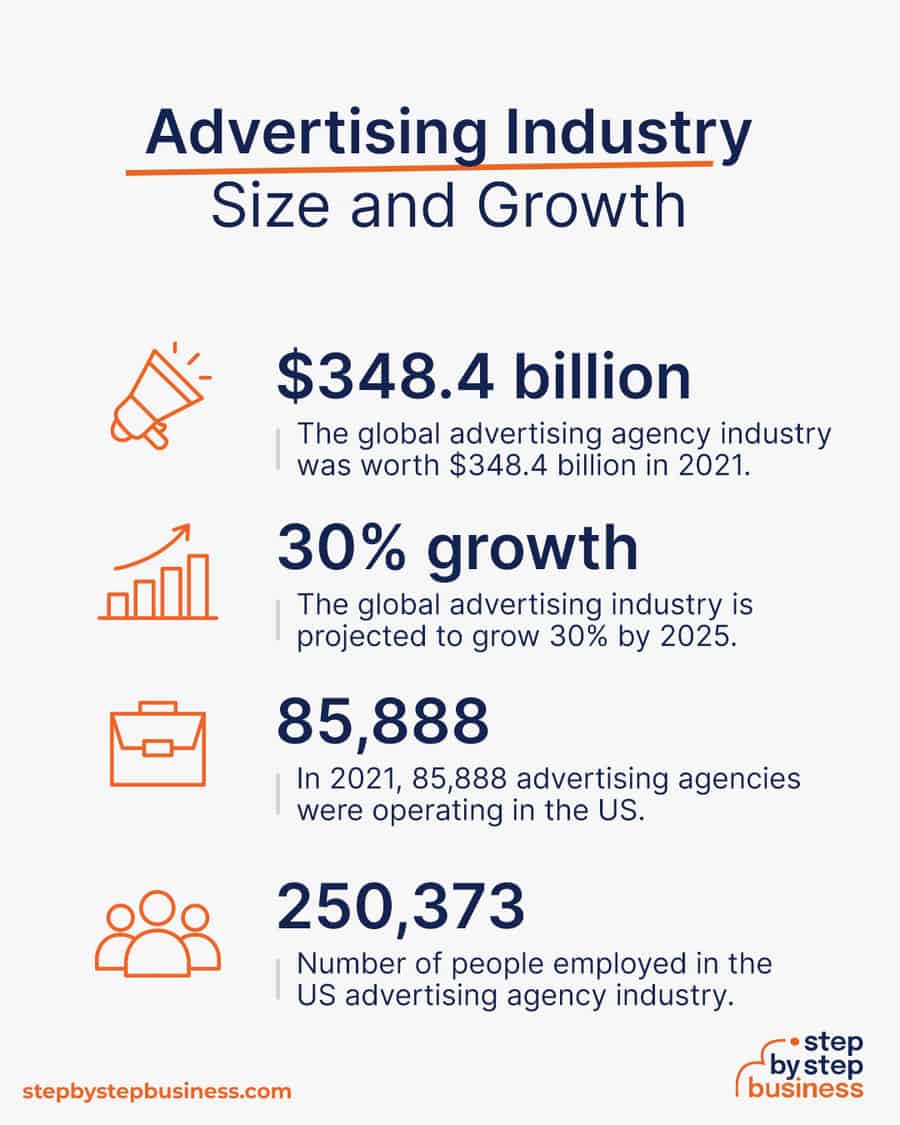
- Industry size and past growth – The global advertising agency industry was worth $348.4 billion in 2021 after expanding nearly 10% the previous year.(( https://www.researchandmarkets.com/reports/5323063/advertising-agencies-global-market-report-2021 ))
- Growth forecast – The global advertising industry is projected to grow 30% by 2025.
- Number of businesses – In 2021, 85,888 advertising agencies were operating in the US.(( https://www.researchandmarkets.com/reports/5323063/advertising-agencies-global-market-report-2021 ))
- Number of people employed – In 2021, the US advertising agency industry employed 250,373 people.(( https://www.ibisworld.com/united-states/market-research-reports/advertising-agencies-industry/ ))
Trends and challenges
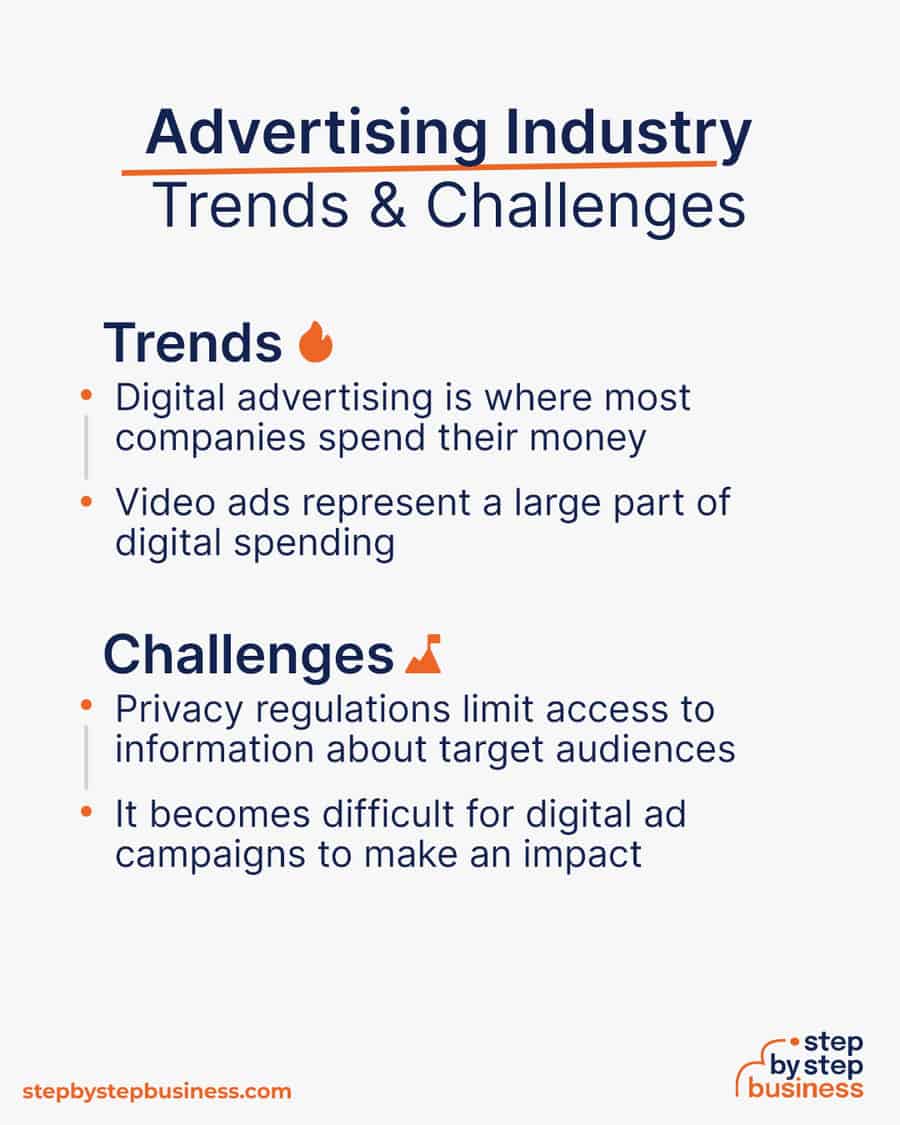
Trends in advertising include:
- Digital advertising is where most companies spend their money, with over 64% of advertising budgets allocated to online channels.
- Video ads represent a large part of digital spending, with the trend moving to shorter and shorter videos.
Challenges in the advertising agency industry include:
- Tightening privacy regulations limit advertisers’ access to information about target audiences, making it more challenging for ad agencies to create targeted campaigns.
- As the digital world grows, it becomes more and more difficult for digital ad campaigns to make an impact.
Demand hotspots
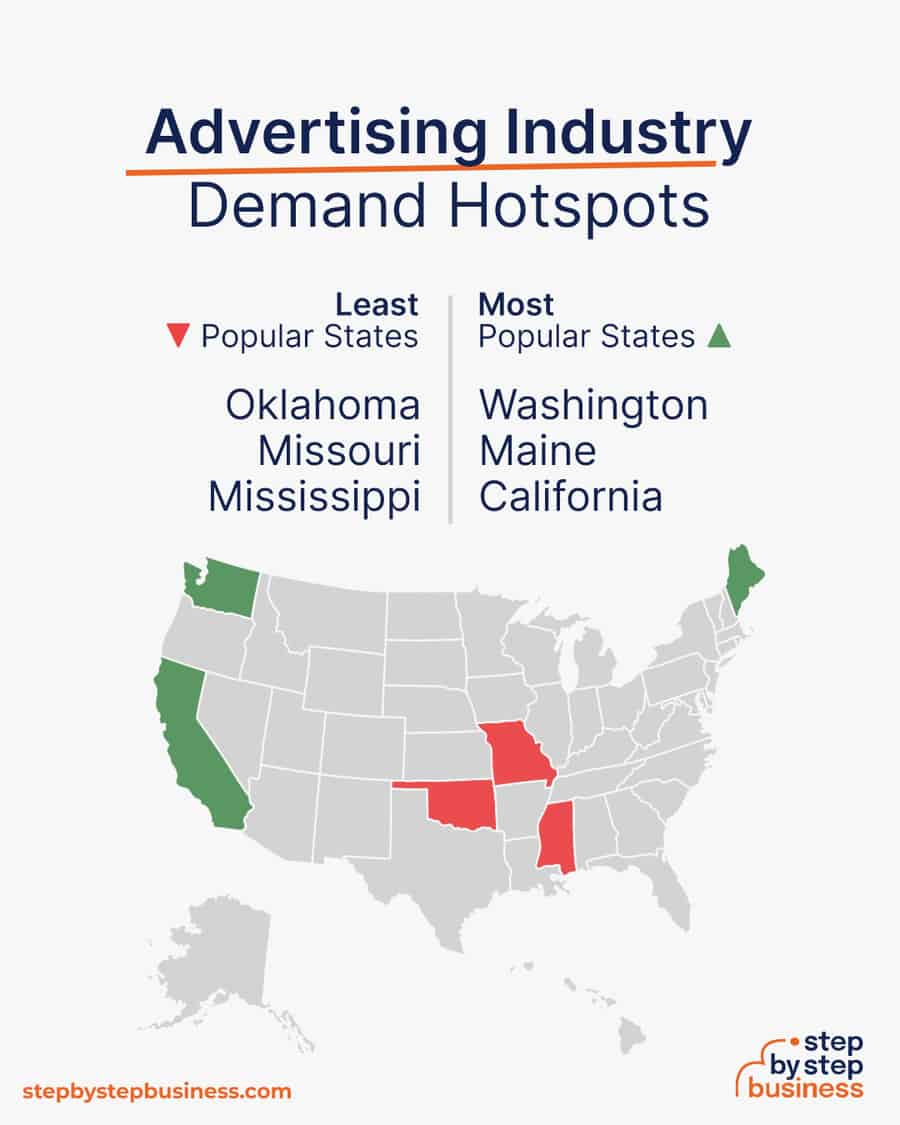
- Most popular states – The most popular states for advertising managers are Washington, Maine, and California . (( https://www.zippia.com/marketing-advertising-manager-jobs/best-states/#missouri ))
- Least popular states – The least popular states for advertising managers are Oklahoma, Missouri, and Mississippi.
What kind of people work in advertising agencies?
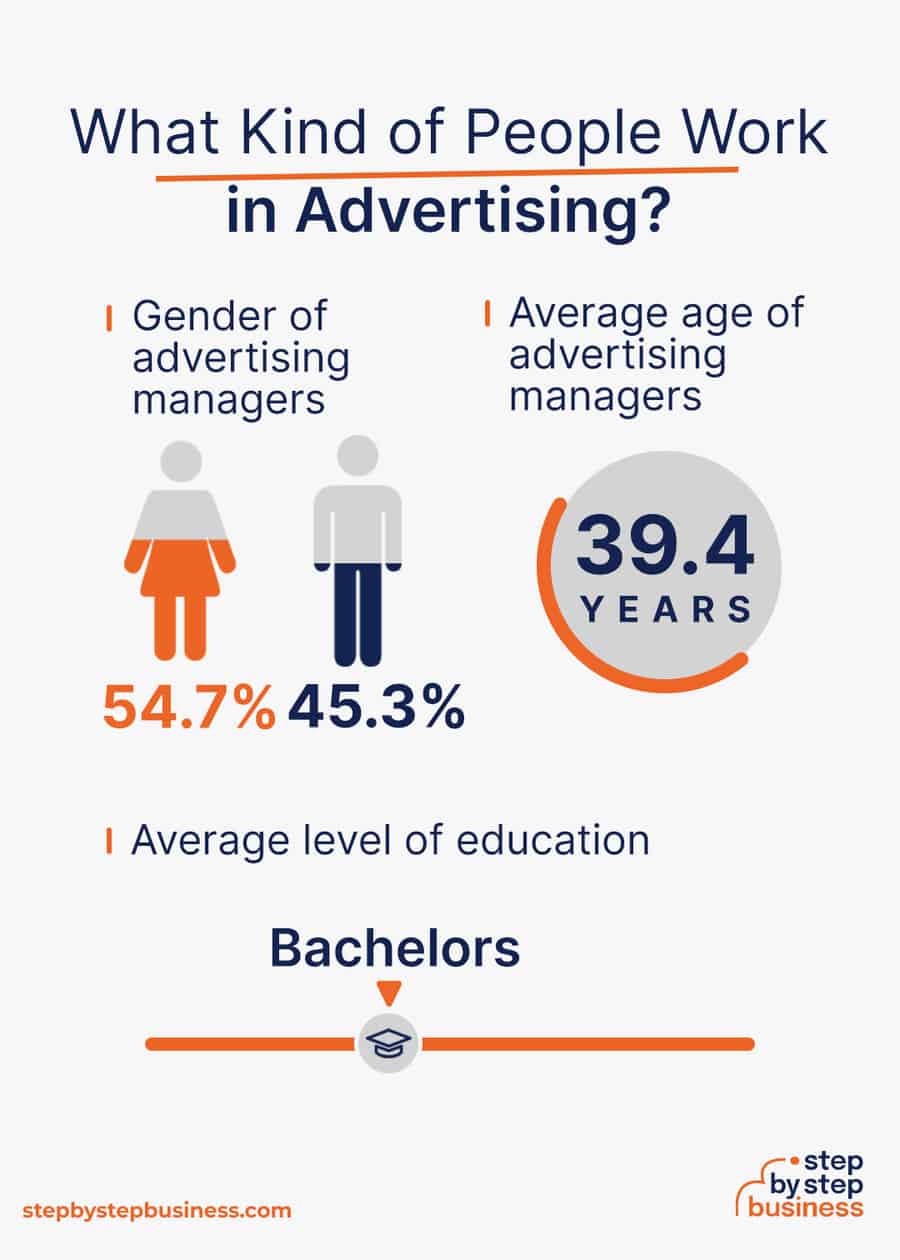
- Gender – 54.7% of advertising managers are female, while 45.3% are male.(( https://www.zippia.com/marketing-advertising-manager-jobs/demographics/ ))
- Average level of education – The average advertising manager has a bachelor’s degree.
- Average age -The average advertising manager in the US is 39.4 years old.
How much does it cost to start an advertising agency business?
Startup costs for an advertising agency range from $2,500 to $5,800. Costs include a computer, a website, and design software for presentations. If you do not have an advertising background, you can get an online advertising degree from any number of colleges and universities.
| Start-up Costs | Ballpark Range | Average |
|---|---|---|
| Setting up a business name and corporation | $150 - $200 | $175 |
| Business licenses and permits | $100 - $300 | $200 |
| Insurance | $100-$300 | $200 |
| Business cards and brochures | $200 - $300 | $250 |
| Website setup | $1,000 - $3,000 | $2,000 |
| Computer | $800 - $1,400 | $1,100 |
| Design software for presentations | $200 - $300 | $250 |
| Total | $2,550 - $5,800 | $4,175 |
How much can you earn from an advertising agency business?
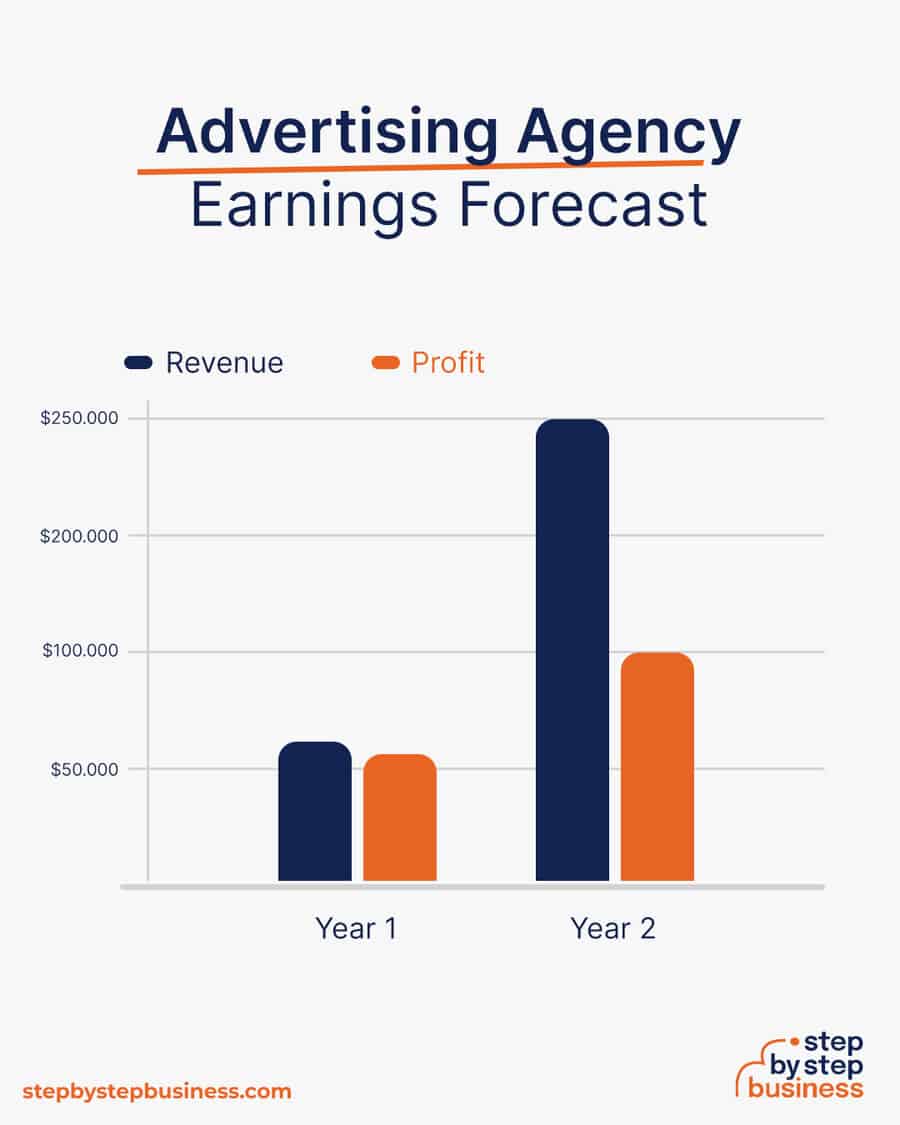
Advertising agencies charge between $150 to $250 per hour of work on a campaign. Usually, the agency will estimate the hours required for a project and give a flat price. When you’re working by yourself, your profit margin will be high, around 90%.
In your first year or two, you could work from home and do twelve $5,000 campaigns a year, bringing in $60,000 in annual revenue. This would mean $54,000 in profit, assuming that 90% margin. As your business grows, sales could climb to 50 campaigns a year. At this stage, you’d rent a commercial space and hire staff, reducing your profit margin to around 40%. With annual revenue of $250,000, you’d make a handsome profit of $100,000.
What barriers to entry are there?
There are a few barriers to entry for an advertising agency. Your biggest challenges will be:
- The required advertising background or education
- Breaking into a highly competitive advertising market.
Related Business Ideas
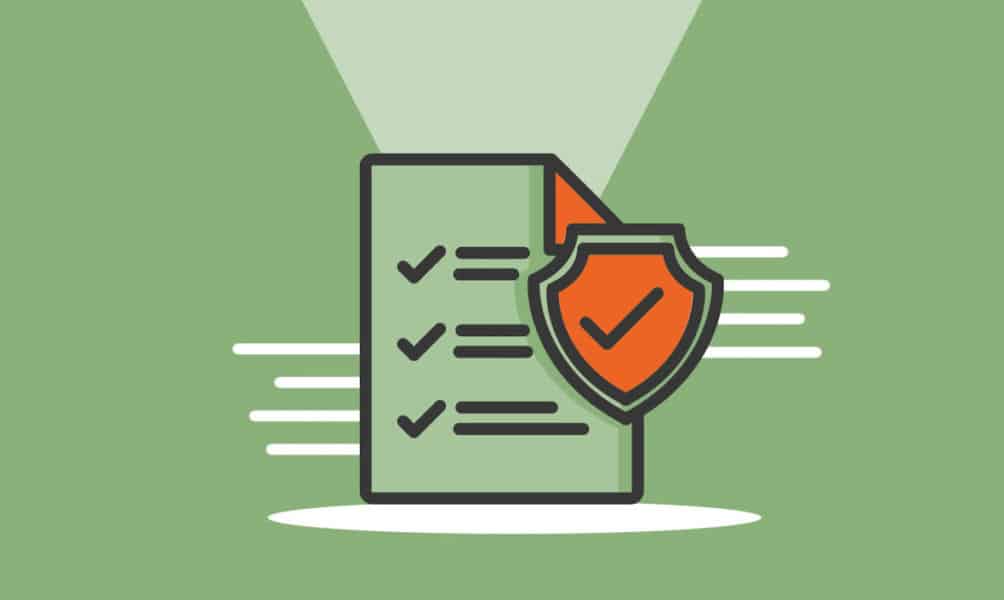
How to Start an Insurance Agency in 13 Easy Steps
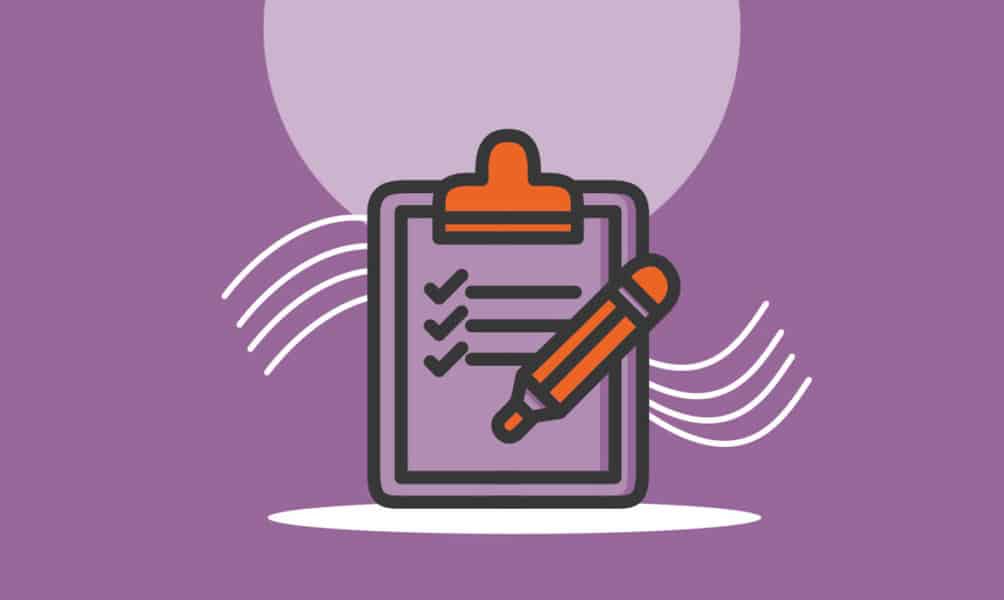
How to Start a Project Management Consulting Business

13 Essential Steps to Start a Staffing Agency
Step 2: hone your idea.
Now that you know what’s involved in starting an advertising agency, it’s a good idea to hone your concept in preparation to enter a competitive market.
Market research will give you the upper hand, even if you’re already positive that you have a perfect product or service. Conducting market research is important, because it can help you understand your customers better, who your competitors are, and your business landscape.
What? Determine your services
Your services will be to design, present, and implement advertising campaigns for companies. Here are the most common services:
- Market Research: This involves gathering and analyzing data to understand the target audience, market trends, and consumer preferences, which is crucial for crafting effective campaigns.
- Brand Strategy: Developing a comprehensive plan that defines brand identity , positioning, messaging, and voice, helping businesses establish a strong and consistent brand presence.
- Creative Development: This service encompasses the creation of visual and textual content for advertising campaigns, including graphics, videos, and written content that aligns with the brand’s message.
- Media Planning and Buying: Determining the most effective media channels to distribute the advertising content (such as television, radio, online platforms) and negotiating and purchasing advertisement space or time.
- Digital Marketing : Involves online marketing efforts, including SEO (Search Engine Optimization), PPC (Pay-Per-Click advertising), email marketing, and content marketing to boost online presence and engagement.
- Social Media Management : Managing a brand’s presence on social media platforms, including content creation, community engagement, and monitoring social media trends and analytics.
- Public Relations : Enhancing and maintaining the public image of a client through media releases, public statements, and event organization, as well as managing crisis communication.
- Event Marketing and Sponsorships: Organizing and promoting events to engage with the target audience or securing sponsorship opportunities to increase brand visibility.
- Analytics and Reporting: Tracking and analyzing the performance of advertising campaigns using various metrics, providing clients with insights on ROI and helping them make data-driven decisions.
- Interactive and Emerging Technologies: Utilizing new technologies like AR (Augmented Reality), VR (Virtual Reality), and AI (Artificial Intelligence) for more engaging and innovative advertising experiences.
Research advertising agencies in your area and online to examine their services, price points, and customer reviews. You’re looking for a market gap to fill. For instance, maybe the market is missing a creative agency that provides digital marketing services or that monitors Google analytics and focuses on search engine optimization (SEO) .
How much should you charge for advertising services?
Ad agencies charge $150 to $250 per hour of work on a campaign. Usually, the agency will estimate the hours required for a project and give a flat price. When you’re working by yourself, you should aim for a profit margin of about 90%
Once you know your costs, you can use this Step By Step profit margin calculator to determine your mark-up and final price points. Remember, the prices you use at launch should be subject to change if warranted by the market.
Who? Identify your target market
Your target market will be businesses and organizations. You can connect with business owners on LinkedIn or find them on Google and Yelp and call them directly.
Where? Choose your business premises
In the early stages, you may want to run your business from home to keep costs low. But as your business grows, you’ll likely need to hire workers for various roles and may need to rent out an office. You can find commercial space to rent in your area on sites such as Craigslist , Crexi , and Instant Offices .
When choosing a commercial space, you may want to follow these rules of thumb:
- Central location accessible via public transport
- Ventilated and spacious, with good natural light
- Flexible lease that can be extended as your business grows
- Ready-to-use space with no major renovations or repairs needed
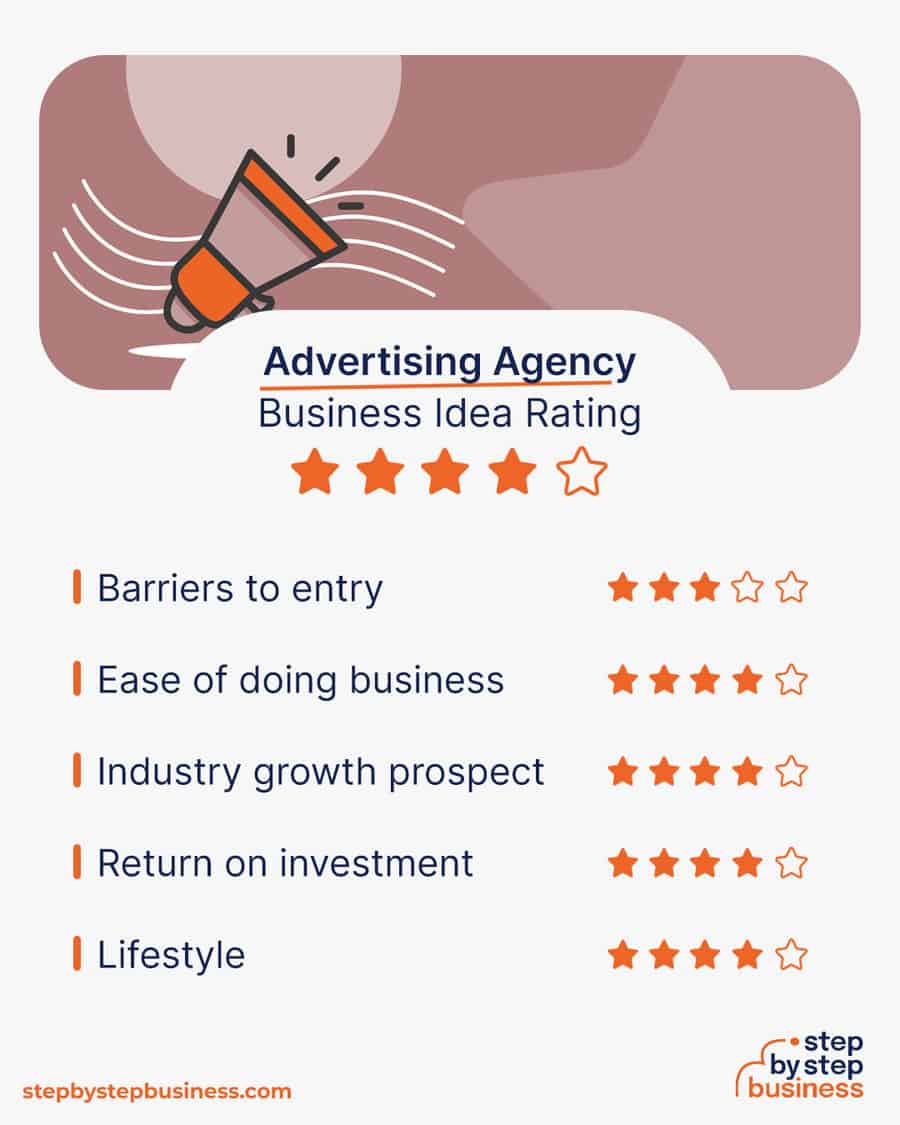
Step 3: Brainstorm an Advertising Agency Name
Here are some ideas for brainstorming your business name:
- Short, unique, and catchy names tend to stand out
- Names that are easy to say and spell tend to do better
- Name should be relevant to your product or service offerings
- Ask around — family, friends, colleagues, social media — for suggestions
- Including keywords, such as “ad agency” or “digital advertising”, boosts SEO
- Name should allow for expansion, for ex: “Momentum Marketing Agency” over “Brand Builders Agency”
- A location-based name can help establish a strong connection with your local community and help with the SEO but might hinder future expansion
Once you’ve got a list of potential names, visit the website of the US Patent and Trademark Office to make sure they are available for registration and check the availability of related domain names using our Domain Name Search tool. Using “.com” or “.org” sharply increases credibility, so it’s best to focus on these.
Find a Domain
Powered by GoDaddy.com
Finally, make your choice among the names that pass this screening and go ahead with domain registration and social media account creation. Your business name is one of the key differentiators that sets your business apart. Once you pick your company name, and start with the branding, it is hard to change the business name. Therefore, it’s important to carefully consider your choice before you start a business entity.
Step 4: Create an Advertising Agency Business Plan
Here are the key components of a business plan:

- Executive Summary: Highlight the vision and objectives of your advertising agency, focusing on delivering creative and strategic advertising solutions for various media platforms.
- Business Overview: Describe your agency’s services in creating and managing advertising campaigns, including concept development, media buying, and digital marketing.
- Product and Services: Detail the range of advertising services offered, such as print, digital, social media advertising, brand strategy, and market research.
- Market Analysis: Evaluate the demand for advertising services, identifying potential clients like small businesses, corporations, or non-profits.
- Competitive Analysis: Compare your agency to others, focusing on your unique offerings, such as niche market expertise, creative approach, or digital innovation.
- Sales and Marketing: Outline your strategy for attracting clients, using methods like networking, showcasing a portfolio, or digital marketing.
- Management Team: Highlight the experience and skills of your team, particularly in advertising, creative design, and business development.
- Operations Plan: Describe the process of campaign development, from client consultation to execution and performance analysis.
- Financial Plan: Provide an overview of financial aspects, including startup costs, pricing strategy, and projected revenue.
- Appendix: Include supplementary documents like case studies, client testimonials, or detailed market research to support your business plan.
If you’ve never created a business plan, it can be an intimidating task. You might consider hiring a business plan specialist to create a top-notch business plan for you.
Step 5: Register Your Business
Registering your business is an absolutely crucial step — it’s the prerequisite to paying taxes, raising capital, opening a bank account, and other guideposts on the road to getting a business up and running.
Plus, registration is exciting because it makes the entire process official. Once it’s complete, you’ll have your own business!
Choose where to register your company
Your business location is important because it can affect taxes, legal requirements, and revenue. Most people will register their business in the state where they live, but if you’re planning to expand, you might consider looking elsewhere, as some states could offer real advantages when it comes to advertising agencies.
If you’re willing to move, you could really maximize your business! Keep in mind, it’s relatively easy to transfer your business to another state.
Choose your business structure
Business entities come in several varieties, each with its pros and cons. The legal structure you choose for your advertising agencies will shape your taxes, personal liability, and business registration requirements, so choose wisely.
Here are the main options:

- Sole Proprietorship – The most common structure for small businesses makes no legal distinction between company and owner. All income goes to the owner, who’s also liable for any debts, losses, or liabilities incurred by the business. The owner pays taxes on business income on his or her personal tax return.
- General Partnership – Similar to a sole proprietorship, but for two or more people. Again, owners keep the profits and are liable for losses. The partners pay taxes on their share of business income on their personal tax returns.
- Limited Liability Company (LLC) – Combines the characteristics of corporations with those of sole proprietorships or partnerships. Again, the owners are not personally liable for debts.
- C Corp – Under this structure, the business is a distinct legal entity and the owner or owners are not personally liable for its debts. Owners take profits through shareholder dividends, rather than directly. The corporation pays taxes, and owners pay taxes on their dividends, which is sometimes referred to as double taxation.
- S Corp – An S-Corporation refers to the tax classification of the business but is not a business entity. An S-Corp can be either a corporation or an LLC , which just need to elect to be an S-Corp for tax status. In an S-Corp, income is passed through directly to shareholders, who pay taxes on their share of business income on their personal tax returns.
We recommend that new business owners choose LLC as it offers liability protection and pass-through taxation while being simpler to form than a corporation. You can form an LLC in as little as five minutes using an online LLC formation service. They will check that your business name is available before filing, submit your articles of organization , and answer any questions you might have.
Form Your LLC
Choose Your State
We recommend ZenBusiness as the Best LLC Service for 2024

Step 6: Register for Taxes
The final step before you’re able to pay taxes is getting an Employer Identification Number , or EIN. You can file for your EIN online or by mail or fax: visit the IRS website to learn more. Keep in mind, if you’ve chosen to be a sole proprietorship you can simply use your social security number as your EIN.
Once you have your EIN, you’ll need to choose your tax year. Financially speaking, your business will operate in a calendar year (January–December) or a fiscal year, a 12-month period that can start in any month. This will determine your tax cycle, while your business structure will determine which taxes you’ll pay.
The IRS website also offers a tax-payers checklist , and taxes can be filed online.
It is important to consult an accountant or other professional to help you with your taxes to ensure you’re completing them correctly.

Step 7: Fund your Business
Securing financing is your next step and there are plenty of ways to raise capital:

- Bank loans: This is the most common method but getting approved requires a rock-solid business plan and strong credit history.
- SBA-guaranteed loans: The Small Business Administration can act as guarantor, helping gain that elusive bank approval via an SBA-guaranteed loan .
- Government grants: A handful of financial assistance programs help fund entrepreneurs. Visit Grants.gov to learn which might work for you.
- Friends and Family: Reach out to friends and family to provide a business loan or investment in your concept. It’s a good idea to have legal advice when doing so because SEC regulations apply.
- Crowdfunding: Websites like Kickstarter and Indiegogo offer an increasingly popular low-risk option, in which donors fund your vision. Entrepreneurial crowdfunding sites like Fundable and WeFunder enable multiple investors to fund your business.
- Personal: Self-fund your business via your savings or the sale of property or other assets.
Bank and SBA loans are probably the best option, other than friends and family, for funding an advertising agency business. You might also try crowdfunding if you have an innovative concept.
Step 8: Apply for Licenses/Permits
Starting an advertising agency business requires obtaining a number of licenses and permits from local, state, and federal governments.
Federal regulations, licenses, and permits associated with starting your business include doing business as (DBA), health licenses and permits from the Occupational Safety and Health Administration ( OSHA ), trademarks, copyrights, patents, and other intellectual properties, as well as industry-specific licenses and permits.
You may also need state-level and local county or city-based licenses and permits. The license requirements and how to obtain them vary, so check the websites of your state, city, and county governments or contact the appropriate person to learn more.
You could also check this SBA guide for your state’s requirements, but we recommend using MyCorporation’s Business License Compliance Package . They will research the exact forms you need for your business and state and provide them to ensure you’re fully compliant.
This is not a step to be taken lightly, as failing to comply with legal requirements can result in hefty penalties.
If you feel overwhelmed by this step or don’t know how to begin, it might be a good idea to hire a professional to help you check all the legal boxes.
Step 9: Open a Business Bank Account
Before you start making money, you’ll need a place to keep it, and that requires opening a bank account .
Keeping your business finances separate from your personal account makes it easy to file taxes and track your company’s income, so it’s worth doing even if you’re running your advertising agency business as a sole proprietorship. Opening a business bank account is quite simple, and similar to opening a personal one. Most major banks offer accounts tailored for businesses — just inquire at your preferred bank to learn about their rates and features.
Banks vary in terms of offerings, so it’s a good idea to examine your options and select the best plan for you. Once you choose your bank, bring in your EIN (or Social Security Number if you decide on a sole proprietorship), articles of incorporation, and other legal documents and open your new account.
Step 10: Get Business Insurance
Business insurance is an area that often gets overlooked yet it can be vital to your success as an entrepreneur. Insurance protects you from unexpected events that can have a devastating impact on your business.
Here are some types of insurance to consider:

- General liability: The most comprehensive type of insurance, acting as a catch-all for many business elements that require coverage. If you get just one kind of insurance, this is it. It even protects against bodily injury and property damage.
- Business Property: Provides coverage for your equipment and supplies.
- Equipment Breakdown Insurance: Covers the cost of replacing or repairing equipment that has broken due to mechanical issues.
- Worker’s compensation: Provides compensation to employees injured on the job.
- Property: Covers your physical space, whether it is a cart, storefront, or office.
- Commercial auto: Protection for your company-owned vehicle.
- Professional liability: Protects against claims from a client who says they suffered a loss due to an error or omission in your work.
- Business owner’s policy (BOP): This is an insurance plan that acts as an all-in-one insurance policy, a combination of the above insurance types.
Step 11: Prepare to Launch
As opening day nears, prepare for launch by reviewing and improving some key elements of your business.
Essential software and tools
Being an entrepreneur often means wearing many hats, from marketing to sales to accounting, which can be overwhelming. Fortunately, many websites and digital tools are available to help simplify many business tasks.
You may want to use industry-specific software, such as MavenLink , HighLevel , or Function Point , to manage your sales pipeline, campaigns, scheduling, and invoicing.
- Popular web-based accounting programs for smaller businesses include Quickbooks , Freshbooks , and Xero .
- If you’re unfamiliar with basic accounting, you may want to hire a professional, especially as you begin. The consequences for filing incorrect tax documents can be harsh, so accuracy is crucial.
Develop your website
Website development is crucial because your site is your online presence and needs to convince prospective clients of your expertise and professionalism.
You can create your own website using services like WordPress, Wix, or Squarespace . This route is very affordable, but figuring out how to build a website can be time-consuming. If you lack tech-savvy, you can hire a web designer or developer to create a custom website for your business.
They are unlikely to find your website, however, unless you follow Search Engine Optimization ( SEO ) practices. These are steps that help pages rank higher in the results of top search engines like Google.
Here are some powerful marketing strategies for your future business:
- Specialize and Showcase Expertise: Focus on a niche or specific industry, positioning your agency as experts in that area. Develop case studies and portfolio pieces to showcase your successful campaigns within that niche, demonstrating your deep understanding and capability.
- Content Marketing and Thought Leadership: Create valuable content that educates and engages your target audience. Start a blog, produce insightful whitepapers, or host webinars to establish your agency as a thought leader in the advertising field, building trust and credibility.
- Collaborate with Influencers: Partner with influencers in the marketing and business space to increase your agency’s visibility. This collaboration can extend your reach to a broader audience and lend credibility to your services.
- Run Targeted Social Media Campaigns: Leverage social media platforms to run targeted advertising campaigns. Utilize platforms like LinkedIn for B2B marketing and Instagram or Facebook for a B2C focus. Tailor your content to resonate with your audience on each platform.
- Client Testimonials and Referral Programs: Encourage satisfied clients to provide testimonials and reviews. Word-of-mouth is powerful in the advertising industry, and positive feedback can significantly influence potential clients. Implement a referral program to incentivize existing clients to refer new business.
- Attend Industry Events and Conferences: Participate in relevant industry events and conferences to network with potential clients and partners. Sponsorship or speaking engagements can further establish your agency’s presence and credibility within the advertising community.
- Implement Guerrilla Marketing Tactics: Get creative with unconventional, attention-grabbing marketing tactics that generate buzz. Guerrilla marketing can help your agency stand out and create memorable impressions, fostering brand recall.
- Offer Free Workshops or Training Sessions: Host workshops or training sessions on relevant advertising topics. This not only positions your agency as an authority but also provides a platform to interact with potential clients and showcase your expertise.
- Strategic Alliances with Complementary Businesses: Form partnerships with businesses that offer complementary services, such as graphic design, public relations, or digital marketing. These alliances can lead to collaborative projects and mutual referrals.
- Optimize Your Google My Business Profile: Ensure your Google My Business profile is complete and optimized. Positive reviews, accurate information, and engaging photos can enhance your local search visibility and attract clients in your area.
Focus on USPs

Unique selling propositions, or USPs, are the characteristics of a product or service that sets it apart from the competition. Customers today are inundated with buying options, so you’ll have a real advantage if they are able to quickly grasp how your advertising agency meets their needs or wishes. It’s wise to do all you can to ensure your USPs stand out on your website and in your marketing and promotional materials, stimulating buyer desire.
Global pizza chain Domino’s is renowned for its USP: “Hot pizza in 30 minutes or less, guaranteed.” Signature USPs for your advertising agency business could be:
- Creative ad campaigns to grow your business
- Build brand awareness with better advertising
- Take your business to the next level with stronger ads & marketing
You may not like to network or use personal connections for business gain. But your personal and professional networks likely offer considerable untapped business potential. Maybe that Facebook friend you met in college is now running an advertising agency business, or a LinkedIn contact of yours is connected to dozens of potential clients. Maybe your cousin or neighbor has been working in advertising agencies for years and can offer invaluable insight and industry connections.
The possibilities are endless, so it’s a good idea to review your personal and professional networks and reach out to those with possible links to or interest in advertising agencies. You’ll probably generate new customers or find companies with which you could establish a partnership.
Step 12: Build Your Team
If you’re starting out small from a home office, you may not need any employees. But as your business grows, you will likely need workers to fill various roles. Potential positions for an advertising agency business include:
- Advertising Specialists – assist with advertising campaigns
- Receptionist – greet customers, make appointments
- General Manager – scheduling, accounting
- Marketing Lead – SEO strategies, social media
At some point, you may need to hire all of these positions or simply a few, depending on the size and needs of your business. You might also hire multiple workers for a single role or a single worker for multiple roles, again depending on need.
Free-of-charge methods to recruit employees include posting ads on popular platforms such as LinkedIn, Facebook, or Jobs.com. You might also consider a premium recruitment option, such as advertising on Indeed , Glassdoor , or ZipRecruiter . Further, if you have the resources, you could consider hiring a recruitment agency to help you find talent.
Step 13: Run an Advertising Agency – Start Making Money!
Advertising helps make the business world go round, boosting brand awareness and educating consumers. The ad agency industry is huge and growing, so if you have relevant experience, a desire to help businesses grow, and creative skills, you could grab a share of the market and build a thriving advertising operation.
This article has taught you how to launch a business, so now it’s time to start thinking up great ad campaigns and make your entrepreneurial dreams come true!
- Advertising Agency Business FAQs
Advertising agencies can be very profitable, with rates between $150 and $250. You’ll just need to come up with creative advertising campaigns to stand out in a competitive market.
Starting an advertising agency can be challenging, as it requires a wide range of skills, knowledge, and experience. Some of the key challenges include identifying a target market, developing a unique value proposition, building a team of talented professionals, establishing a strong brand identity, and attracting clients in a highly competitive industry.
To start a marketing agency, you will need a combination of creative, technical, and business skills. These may include expertise in areas such as branding, graphic design, copywriting, digital marketing, social media, analytics, project management, and business development.
To start an advertising agency with no experience, you may need to start small and focus on building your skills and expertise over time. You can gain experience by working for an established agency, freelancing, or taking on small projects for friends and family. You can also invest in training, education, and networking opportunities to build your knowledge and connections in the industry.
As an advertising agency, you can offer a wide range of services to clients, including branding, creative design, copywriting, media planning and buying, digital marketing, social media management, analytics, and market research. You can also offer strategic consulting and project management services to help clients develop and execute effective marketing campaigns.
When developing and presenting advertising proposals to clients, it is important to follow best practices to ensure that your proposals are effective and persuasive. Some key tips include:
- Conduct thorough research and analysis to understand the client’s needs, target audience, and competition
- Develop a clear and compelling value proposition that highlights the benefits of your proposed strategy or campaign
- Use data and metrics to support your recommendations and demonstrate the potential ROI
- Present your proposal in a clear, concise, and visually appealing format that is easy to understand
- Be prepared to answer questions and address objections from the client
Leave a Reply Cancel reply
Your email address will not be published. Required fields are marked *
Save my name, email, and website in this browser for the next time I comment.
- Decide if the Business Is Right for You
- Hone Your Idea
- Brainstorm an Advertising Agency Name
- Create an Advertising Agency Business Plan
- Register Your Business
- Register for Taxes
- Fund your Business
- Apply for Licenses/Permits
- Open a Business Bank Account
- Get Business Insurance
- Prepare to Launch
- Build Your Team
- Run an Advertising Agency - Start Making Money!
Subscribe to Our Newsletter
Featured resources.

57 In-Demand Service Business Ideas You Can Launch Today
David Lepeska
Published on December 1, 2022
The services sector is undoubtedly the biggest economic sector in the US as it accounts for nearly 70% of the country’s gross domestic product. It ...
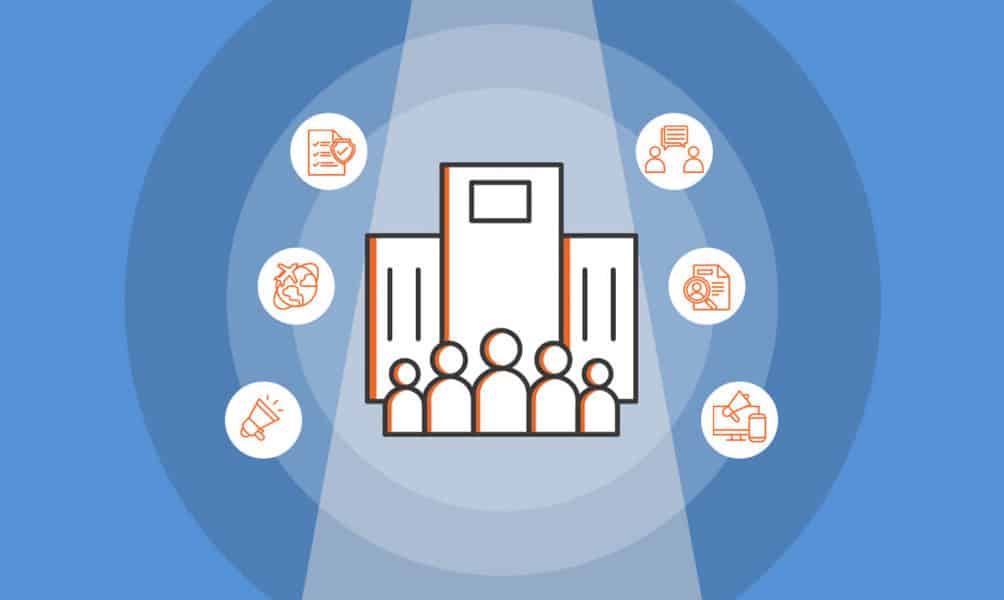
Top 21 Profitable Agency Business Ideas for Entrepreneurs
Published on August 11, 2022
Dreaming of running your own agency? There are a lot of possibilities out there, from travel to advertising and marketing, to recruiting, SEOconsult ...

38 Creative Small Business Ideas to Inspire You
Carolyn Young
Published on June 30, 2022
Want to express your creativity and be your own boss? There are many creative business ideas out there that can help you check both boxes, and makeg ...
No thanks, I don't want to stay up to date on industry trends and news.
- Starting a Business
- Growing a Business
- Small Business Guide
- Business News
- Science & Technology
- Money & Finance
- For Subscribers
- Write for Entrepreneur
- Tips White Papers
- Entrepreneur Store
- United States
- Asia Pacific
- Middle East
- South Africa
Copyright © 2024 Entrepreneur Media, LLC All rights reserved. Entrepreneur® and its related marks are registered trademarks of Entrepreneur Media LLC
How to Start a Successful Marketing Agency from Scratch Opening a marketing agency is tough, but with the right strategy your business can take off.
By Timothy Carter Mar 17, 2021
Opinions expressed by Entrepreneur contributors are their own.
If you have experience in the marketing world or want to start a business that allows you to think creatively and recommend solutions for a diverse array of clients, launching a marketing agency could be a great option. The global market for digital marketing and advertising alone is estimated to be $322.5 billion and is projected to grow to $640.2 billion by the end of 2027 . And within this industry, you can capitalize on any number of subfields, including niche areas of expertise that don't have much competition and fast-growing areas with high potential for profitability.
Of course, starting a marketing agency from scratch isn't easy. To succeed you'll need to follow a few important principles and strategies.
Get experience (one way or another)
First, you'll want to gain experience. As a marketing agency CEO with virtually no marketing experience, you'd be hard-pressed to make insightful recommendations to your clients.
The most common path is to earn this experience for yourself. Start as a freelancer , providing small-scale marketing services to a limited number of clients. Or develop your abilities by working for an already established marketing agency.
Related: 10 Marketing Strategies to Fuel Your Business Growth
If you don't have much experience of your own and you want to get started sooner, you can leverage the experience of other professionals instead.
For example, you can:
Partner up. If you have a mind for business but limited marketing experience, consider partnering with a bona fide marketing expert who has limited business know-how. Complementary partnerships often work well.
Hire someone. You can also substitute your lack of experience with a roster of highly experienced employees. With the right team, your minimal experience is a nonissue.
Work with investors. If you have at least some experience, you can lean on the help of investors to guide you through the earliest stages of agency development.
Work with vendors. You can also work with vendors as the primary source of your recommendations. In this model your agency works more as a conduit than a direct source of marketing strategies or tactics.
Find a way to distinguish yourself
There are more than 40,000 advertising and related agencies in the United States. That's a lot of competition. To find clients and establish a reputation for your brand, you'll need a way to distinguish yourself.
Fortunately there are many options to do this. For example, you could focus on a specific type of client, based on their company size, industry or stage of growth. You could also focus on a specific area, appealing only to people in your city or state. Additionally, you could distinguish your brand by offering a unique voice or perspective on marketing in general.
Don't shy away from white labeling
One option for new agencies and inexperienced entrepreneurs is white labeling. Through white labeling you'll work with another agency, offering their services to your end clients as if they were your own. Depending on the nature of this relationship, you'll likely be able to devise strategies, execute tactics, and even produce reports through your partnered agency; and all these assets will be presented by your brand.
You'll pay upfront for these services, usually marking up the price slightly for your end client. Profit margins are reasonable, your client still gets a great price and you can rest assured that your clients are getting the best quality work.
Practice what you preach
As a marketing agency, it's important to practice what you preach. For example, let's say your agency formally recommends search engine optimization (SEO) to its clients. If your clients conduct a few basic searches for your agency's website and are unable to find it, this is a sign of your agency's incompetence, hypocrisy or both.
To make a good first impression and land more clients, you need to master all the strategies you're recommending.
Serve your first clients well
Your earliest clients are going to be some of the most important. This is your opportunity to prove what your agency can do, and oftentimes, early clients serve as a gateway to a potentially endless chain of referrals. Do whatever it takes to make these first clients happy, even if it means taking small losses or making additional sacrifices.
Related: Why I Spent Hours Conducting Research for My First Clients — All Before I Was Paid a Dime
Have a plan to scale
Marketing agency margins aren't amazing, especially if you're outsourcing most of your work. If you want to make money long-term, you'll need a plan to scale and attract more clients. There are many ways to do this, each with advantages and disadvantages. For example, you could dump more money into marketing and advertising, establish a referral program, or open up new locations in different cities.
Related: The 5 Stages Startups Must Go Through to Make that First $1 Million
Starting a marketing agency is tough, especially if you have little experience in the marketing industry. But with the right strategy and accommodation for these important points, your business has the potential to take off.
Chief Revenue Officer of SEO.co
Want to be an Entrepreneur Leadership Network contributor? Apply now to join.
Editor's Pick Red Arrow
- You Might Unknowingly Rely on This 100-Year-Old Business . Its Third-Generation Leader Reveals the 'Secret Sauce' for Lasting Success — and $850 Million in Annual Revenue .
- Lock This Flexible, AI-Powered Side Hustle Lets a Dad of Four Make $32 an Hour , Plus Tips: 'You Can Make a Substantial Amount of Money'
- Tennis Champion Coco Gauff Reveals the Daily Habits That Help Her Win On and Off the Court — Plus a 'No Brainer' Business Move
- Lock 3 Essential Skills I Learned By Growing My Business From the Ground Up
- 50 Cent Once Sued Taco Bell for $4 Million. Here's How the Fast-Food Giant Got on the Rapper's Bad Side .
Most Popular Red Arrow
Find out what's different about sonic's new $1.99 value menu. hint — it's not just the lower price..
As fast-food consumers continue to prioritize value, Sonic has joined competitors in introducing a new value menu — with one big difference.
Is It Too Late to Buy Nvidia? Former Morgan Stanley Strategist Says 'Buy High, Sell Higher.'
Nvidia is responsible for one-third of S&P 500 gains this year.
Costco Settled a $2 Million Class Action Lawsuit — Here's Who's Eligible to Make a Claim for Cash
The settlement involves customers who purchased a Kirkland Signature product.
The Case for 14-Hour Workdays — Why New Entrepreneurs Should Embrace the Hustle Before Seeking Work-Life Balance
Wondering how to balance your time as a new entrepreneur? Here's when long workdays can make sense — and when to scale back.
A D.C. Hotspot Is Now Offering 'Quiet Hours' to Combat the City's Party Brunch Scene
Ceibo is a South American restaurant in Washington, D.C.'s Adams Morgan neighborhood.
How Investing in a Multi-Unit Franchise Can Positively Diversify Your Portfolio
Investing in a multi-unit franchise can diversify your portfolio and build a substantial business, but it is critical to understand your financial and operational capabilities clearly.
Successfully copied link
How to Write a Digital Marketing Agency Business Plan (with PDF Template)

SEOptimer now serves over 2,000 digital agencies around the world and through the years we've had the chance to connect with many of our agency customers to understand their early days in starting their agency. This is incredibly interesting to us because it helps us understand where and how they plan to grow so we can help build the features they need in SEOptimer.
This article is the 3rd in our series focused on starting a new digital agency. For some useful prior reading be sure to check out our previous articles:
- How to Start a Digital Marketing Agency : a comprehensive guide covering typical agency business models, services, hiring, training, new business, day to day management and more!
- Digital Agency Lean Canvas : a digital agency business model on a single page! The lean canvas is a popular documentation methodology borrowed from the tech startup world.
Don't be dismayed if it feels like there's a lot of other competing digital agencies in your city. This is perfectly normal. Digital marketing services like local SEO, for example, are dominated by small agencies. Search Engine Land reported that over 50% of local SEO agencies have 10 or fewer clients. Forbes Council Member Jon Hall says, this keeps the industry "weird" - aka diverse as its not dominated by a small handful of big agencies.
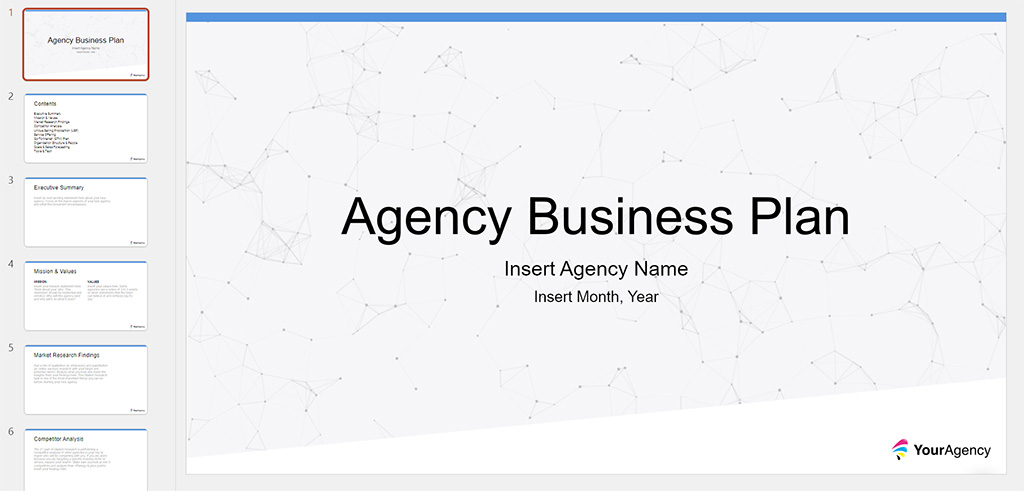
The first step in launching a new digital marketing agency is to write a plan. In this guide, we'll cover two of the more traditional ways to define a business plan document with handy downloadable templates:
- Digital Marketing Agency Business Plan Document (DOCX & PDF) Template
- Creative Agency Business Plan Deck (PPTX) Template
Why do you need a Digital Marketing Agency Business Plan?
The days of mandatory 50+ page business plans are long gone. The choice is now yours as to whether you define your digital agency business plan in an in-depth strategic document or not. Some agency founders find it useful to brainstorm this way and document their thought process in a long-form fashion across many pages. Other founders prefer creating shorter slide decks, others opt for a 1-page lean canvas version or some even write their plan in a wiki or business planning tool.
There is no right or wrong way to document your plan. You need to find the documentation method that suits you best. If you're unsure what suits you best, the following factors may help you decide:
Consideration #1: Who is the audience?
Think about who this document is for. Who will read it? In some cases it will just be you and the founding team. If you are raising money, obviously your investors will be a key audience.
You might also have business partners or board members who may be an audience too. When thnking through all these different groups, work backwards from the most optimal presentation format.
Consideration #2: Seek an unbiased third-party opinion
Devin Schumacher is the Founder of SEO agency SERP and says it's easy to get swept up in your own overly optimistic projections.
"Ask an experienced agency founder you trust or admire to sanity-check your plan. Seeking an objective opinion from a third-party detached from your new business is vital."

Devin makes a great point. This type of peer review methodology is commonplace in other industries but sometimes lacking amongst agency founders. Make sure you get at least 1 other unbiased opinion from someone who has already achieved success in your niche.
Don't fall into the trap of asking a friend or your accountant or someone you know personally to review your plan. Doing so will give you a biased opinion. You need an unbiased opinion from someone willing to give you objective feedback.
Consideration #3: Stand your ground
The whole point of a business plan is to take the time and effort to research the market, your competitors and potential clients. This document will distill all your insights into a strategic plan you can operationalize. As is always the case, unexpected distractions masquerading as opportunities (rightly or wrongly) will pop up in your field of view demanding your attention.
Perhaps it's a new client opportunity with a project slightly adjacent to your niche. Perhpas a hiring opportunity for a role you didn't plan to hire yet. Sometimes the hardest thing is to say no, when you're in the mindset of taking every opportunity for growth.
During these situations, revisit your agency business plan and remind yourself of your focus area niche and how you planned to grow within that niche.
Consideration #4: But, be ok with change
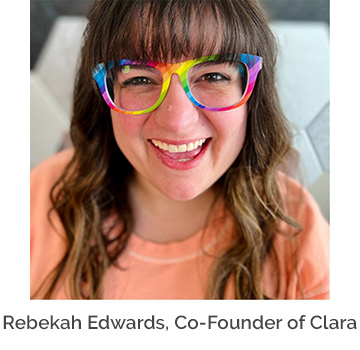
In fact this balance between sticking to the plan and pivoting the plan needs to be navigated by every digital agency founder. It's not easy and often you will be second-guessing yourself.
"Every agency owner I know has had to massively adjust their target audience, pricing structure, competitor analysis, and service offerings based on the way they grow over the first 2-5 years."
Rebekah says that founders need to be prepared for change, afterall, digital marketing is in constant flux and evolution, so change is the norm and we need to write business plans with flexibility in mind.
Trust your performance metrics and continue to do the things that have the biggest quantifiable business impact.
Typical Business Plan structures
We mentioned previously that there's no right or wrong way to document your business plan. So with that said, let's look at some typical marketing agency business plan templates that you can use. After considering all the factors above, choose the structure that works for you and your stakeholders best. We've outlined six of the more common options below:
Option #1: Written business document
This is the more traditional (and still valid) way to describe your business. A written business plan document in MS Word or Google Docs is still the most common way to document your digital marketing agency business plan.
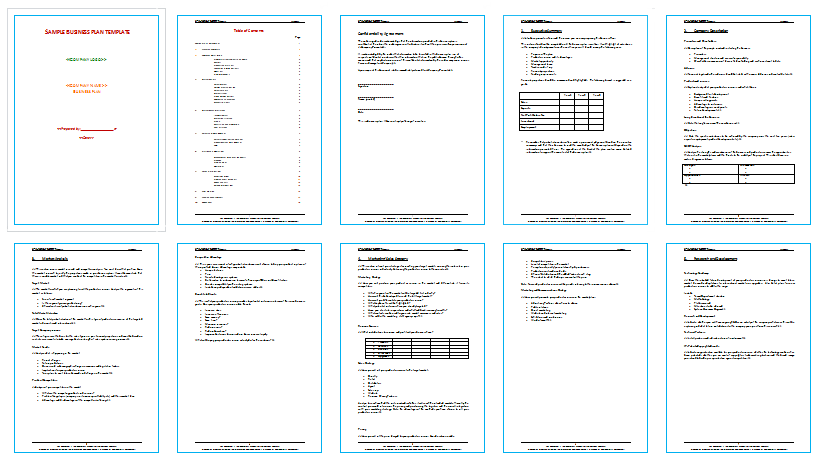
This type of business plan is considered "long-form", ie: longer in length and suited to more descriptive language. Expect to write longer rationales, longer explanations with plenty of space for evidence, research, insights and strategy. This type of plan will likely be 30+ pages and feel comprehensive. This comprehensiveness is especially needed if external investors or business partners are involved who need to be convinced of the robustness of your plan.
Option #2: Slide deck
The PowerPoint Presentation (or Google Slides or Keynote) has become the go-to corporate communication format. Digital agency founders spend most of their time communicating to staff, clients and stakeholders in PowerPoint so it makes sense to use this format for the purposes of communicating the agency's overall business plan.
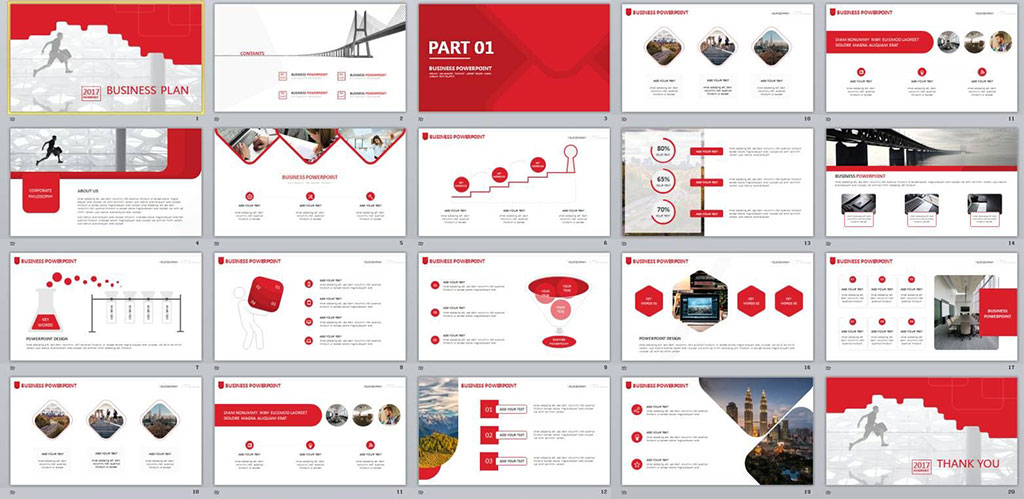
The fundamental difference between this option and the written document, is that a slide deck is a presentable format. So typically you might be in the room with your business partners, walking through the presentation on the screen. Whereas in option #1, a written document is not a compelling way to present an idea. It's much more suited as a sent document to be consumed in isolation. That's not to say that a slide deck can't be utilized this way, it's just more common that you would be presenting and talking through your plan with the slides serving as a visual backup to what you say.
There's also a good argument for doing both (ie written document AND slide deck). It comes down to who all the stakeholders are (eg investors, business partners or just you) and whether you intend to present your plan or just document your plan.
Option #3: Lean canvas
The Lean Canvas developed by leanstack.com is a business plan on a page split into 10 boxes. This planning document has become very popular in the tech/startup world and has since been adopted in many other industries, including digital agencies. Be sure to check out our previous article explaining how to use a Lean Canvas for your agency .
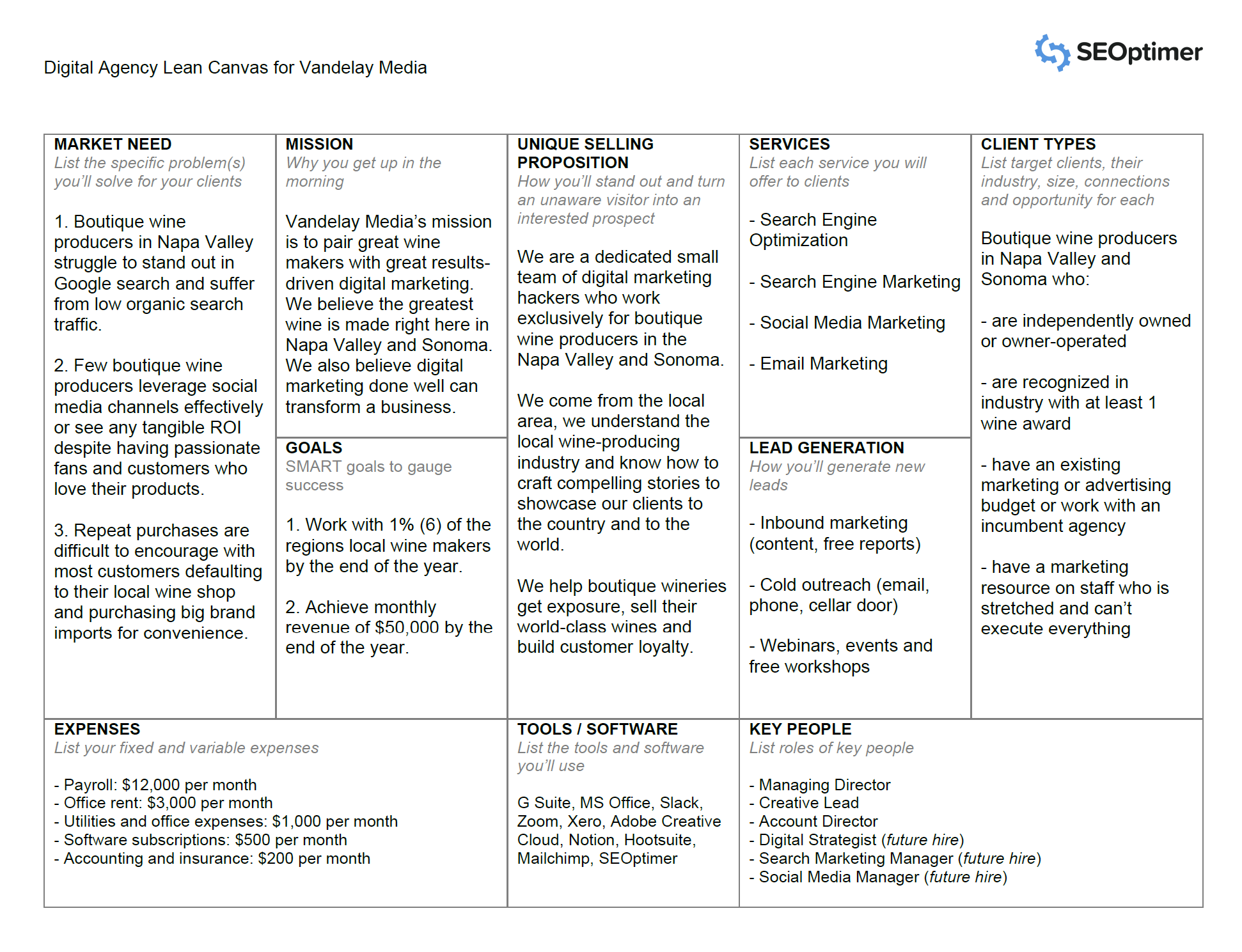
The entire business plan fits on a single page which means you obviously need to sweat on every single world and ensure only the most important details are included. We are big supporters of this format because this helps you prioritize and focus your efforts down to the fundamental aspects of your new business.
Option #4: Wiki
In the context of a business, a Wiki is usually an internal website with multiple interlinking articles. The biggest Wiki in the world is Wikipedia and if you want to get really meta, check out Wikipedia's wiki about wikis :
"A wiki (/wɪki/ WIK-ee) is a hypertext publication collaboratively edited and managed by its own audience directly using a web browser. A typical wiki contains multiple pages for the subjects or scope of the project."
Wiki's are generally perceived as internal knowledge bases so if your business plan has executional detail, this might be a good format for documenting processes and methodologies for staff.
Option #5: General Planning tool
Tools like Notion and Trello have grown massively in recent years as more people are working remotely and more work in general is being done collaboratively online.
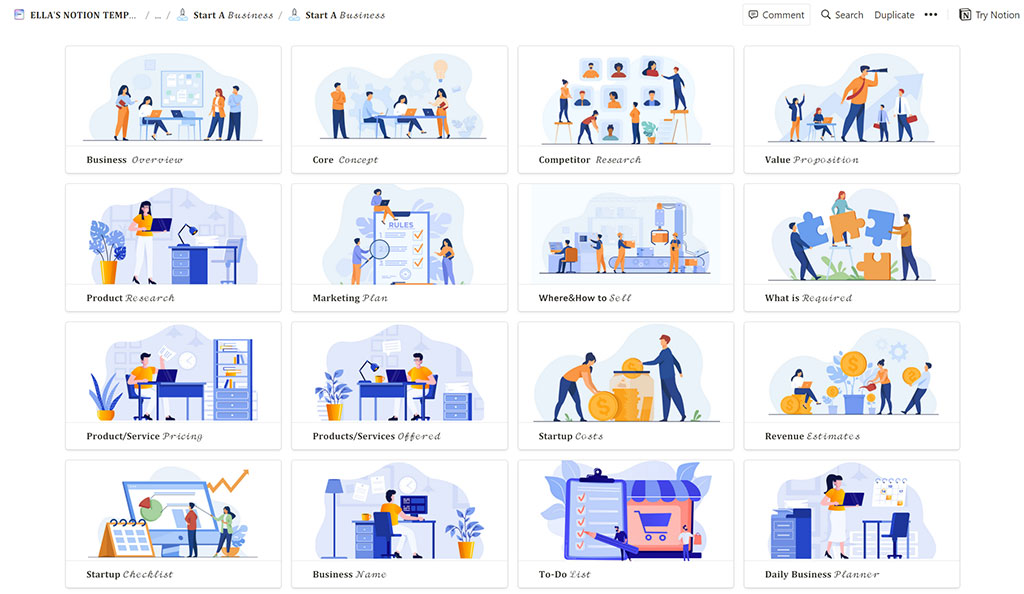
These types of planning tools are designed to be multi-purpose and fall somewhere between a wiki and a specialized business planning tool.
How to construct the business plan
Now that we've covered the typical business plan structures let's look at the specifics of how you actually go about constructing the business plan and each of the main tasks you need to perform and sections of the business plan.
Market research data gathering
Customer/client research.
Rebekah Edwards, who we spoke to previously stresses the importance of market research with as many potential clients as you can. She interviewed several businesses in their target market when developing their service offerings and pricing. Some of the questions she thought were most helpful included:
- With no other information, what do you think X would cost from an agency? (X being the service in question.)
- What is the biggest roadblock for you to accomplish X in-house? (X being basic content/SEO projects, such as article creation/editing/uploading or strategizing new keywords.)
- How would you typically search for a digital marketing agency? (Referrals, social media, Google search, etc. — this helped us understand how to best market our services)
- If you already work with a digital marketing agency of any kind, what stood out? Why did you sign on the dotted line?
- Have there been digital marketing agencies you've specifically decided not to work with for any particular reason? What were the red flags or the issues with a fit that led you to say no?
- What matters most to you when working with a digital marketing agency? (Examples: data/analytics, frequent communication, hitting deadlines every time, price, niche of expertise, etc.)
Answers to these questions are invaluable as they help you position and market your new digital agency based on customer insight.
Competitor research
The importance of competitor research goes without saying. It's vital you have a good understanding of how your competitors are going to market, how they sell, who they target and what their rough price points are. If you have a friend who owns a small business, ask them to mystery shop at a competitor so they can report back to you what the sales process was like.
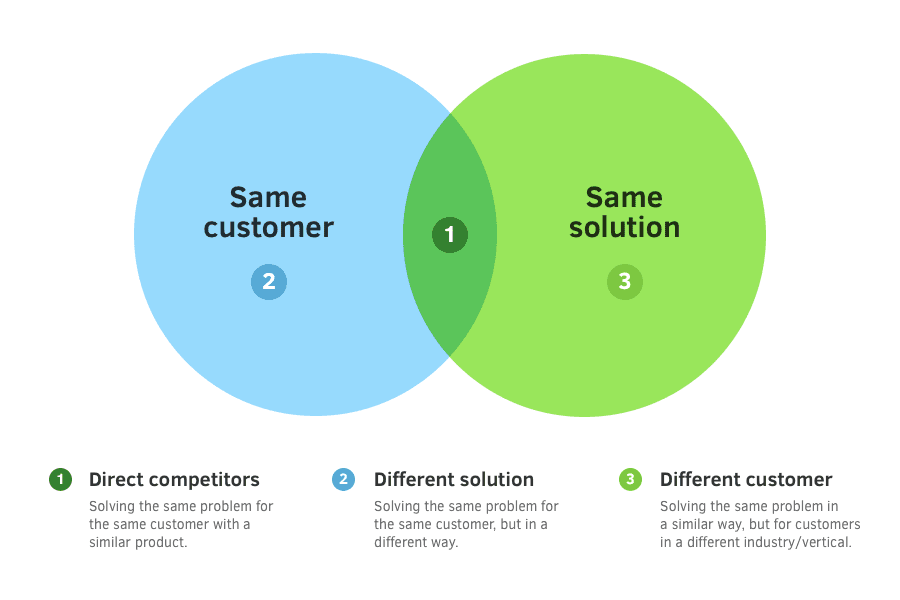
The way you position and sell your services should be informed by a combination of both customer insights and competitor insights. Addressing client needs whilst maintaining a unique selling proposition will set your new digital agency up for success!
Building out the business plan
Download our template: digital marketing agency business plan document.
To make edits to the document make sure to download our DOCX template which you can edit directly in Microsoft Word. However if you would prefer a printable PDF, we also provide this option too. Use these templates as a starting point to help you draft your digital marketing business plan:
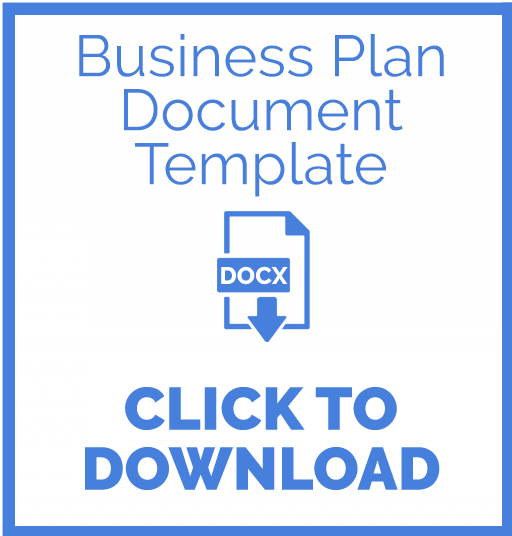
Below are some of the highlight areas of the plan:
Market Research Findings
We suggest conducting three types of research to inform your marketing agency business plan:
- Qualitative research like one-on-one interviews, focus groups and meetings with prospective clients
- Quantitative reserach like online surveys, mass emails and multivariate testing
- Competitor analysis to determine their strengths and weaknesses
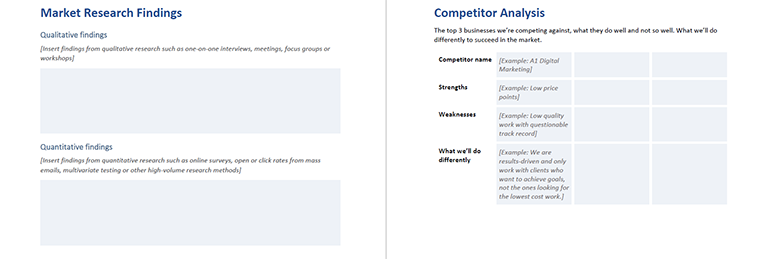
Unique Selling Proposition (USP) and Service Offering
Nailing your USP will be tough especially if you are in a competitive industry / city. Use the previous market research tasks to discover where the gaps are in the market and leverage these insights to position your new agency to be competitive AND different. Perform a SWOT analysis based on your new USP. Then you can determine your actual service offerings and pricing strategy.
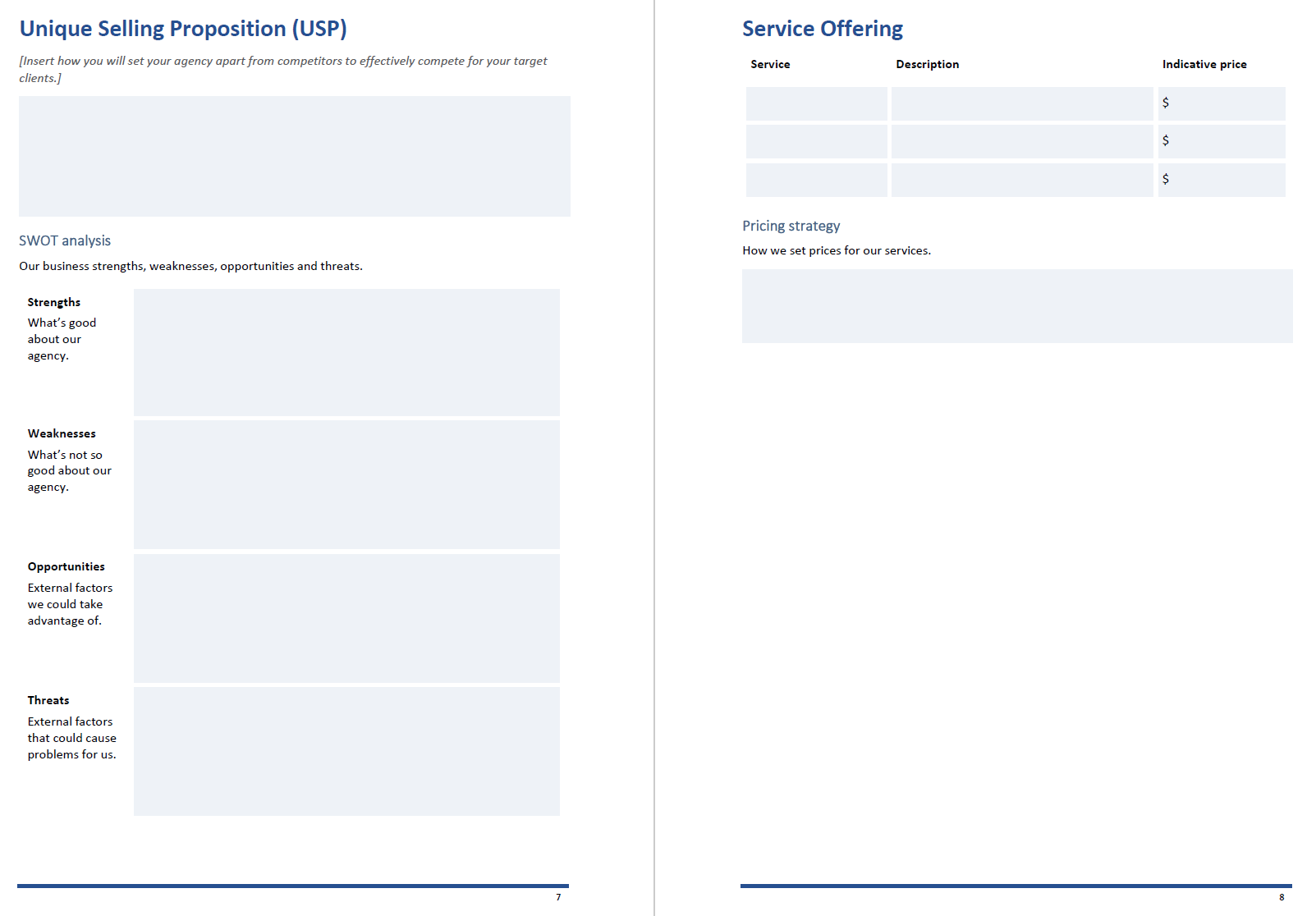
Go-To-Market (GTM) Plan and Org Structure
Define your target market - the exact client types who you want to sell to and list the marketing and advertising activities that you will perform that would be most effective in reaching these types of people.
Also list your people (this might not be many on day 1!), sources of advice and support as well as the strategies you'll use to retain your staff and build their skills and knowledge.
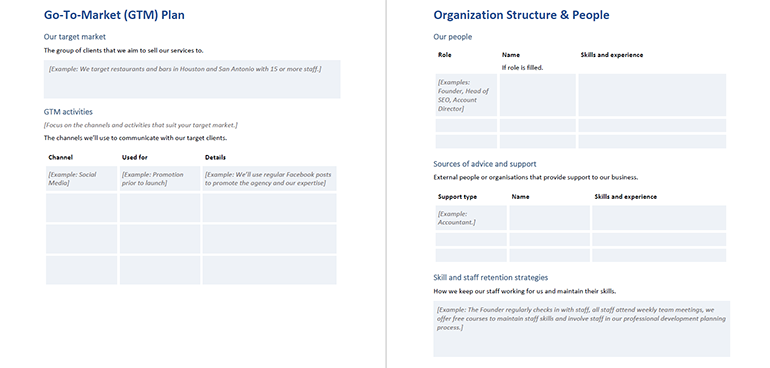
Goals Sales Forecasting
This marketing agency business plan template includes goal setting for the next year and goal setting for the next 3 years. This page is structured to help you set SMART goals.
SMART goals are:
- Specific : In the '[Enter a goal]' section describe your goal clearly and ensure you attach a person responsible in the 'Who's responsible' section.
- Measureable : Ensure the actions you list in the 'Actions to achieve goal' have an objective outcome
- Achievable : Ensure you sense-check your goals with your team and all agree that they are attainable
- Relevant : Ensure this is a priority goal and will help your new agency grow
- Time-bound : Enter a due date to ensure the goal doesn't get forgotten
Use the Cash flow forecast table as a simple way to visualize cash-on-hand in your first 12 months. Add rows to estimate your monthly expenses like payroll, rent, utilities, subscriptions, insurance, fees and other ongoing costs.
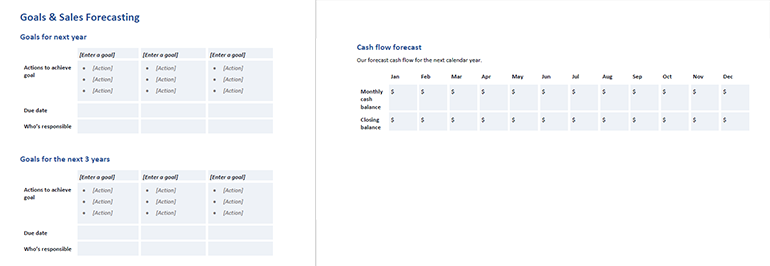
Tools and Tech
Finally, list out all the tools and technology your new agency will likely need to run an efficient operation. We've listed SEOptimer for you already because it's one of the best, low-cost lead generation tools for your agency. Over 2,000 digital agencies use SEOptimer to generate white label site audits and embed an audit form on their agency website to capture new lead details.

Creative Agency Business Plan Slide Deck PPTX Template
If you prefer a slide deck template, use this creative agency business plan example in PowerPoint format:
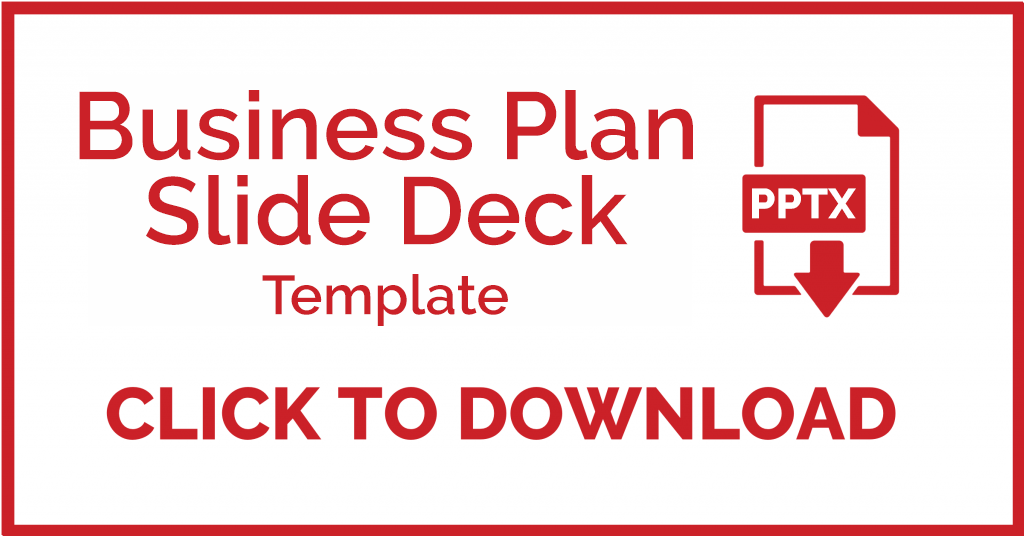
Tim's background is in digital marketing working for both large and small digital agencies and diverse client types. He has a passion for tech, software and staying up to date on the latest search engine news.

SEO Audit & Reporting Tool. Improve Your Website. Win More Customers. Get a Free Website Audit Instantly
Featured Articles
Recent articles, related articles.

SEOptimer - SEO Audit & Reporting Tool. Improve Your Website. Win More Customers. Get a Free Website Audit Instantly

How To Write a Marketing Agency Business Plan + Template
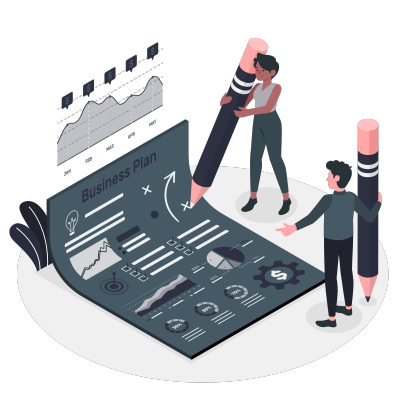
Creating a business plan is essential for any business, but it can be especially helpful for marketing agency businesses that want to improve their strategy and/or raise funding.
A well-crafted business plan not only outlines the vision for your company, but also documents a step-by-step roadmap of how you are going to accomplish it. In order to create an effective business plan, you must first understand the components that are essential to its success.
This article provides an overview of the key elements that every marketing agency owner should include in their business plan.
Download the Digital Marketing Agency Business Plan Template
What is a Marketing Agency Business Plan?
A marketing agency business plan is a formal written document that describes your company’s business strategy and its feasibility. It documents the reasons you will be successful, your areas of competitive advantage, and it includes information about your team members. Your business plan is a key document that will convince investors and lenders (if needed) that you are positioned to become a successful venture.
Why Write a Marketing Agency Business Plan?
A marketing agency business plan is required for banks and investors. The document is a clear and concise guide of your business idea and the steps you will take to make it profitable.
Entrepreneurs can also use this as a roadmap when starting their new company or venture, especially if they are inexperienced in starting a business.
Writing an Effective Marketing Agency Business Plan
The following are the key components of a successful marketing agency business plan:
Executive Summary
The executive summary of a marketing agency business plan is a one to two page overview of your entire business plan. It should summarize the main points, which will be presented in full in the rest of your business plan.
- Start with a one-line description of your marketing agency
- Provide a short summary of the key points in each section of your business plan, which includes information about your company’s management team, industry analysis, competitive analysis, and financial forecast among others.
Company Description
This section should include a brief history of your company. Include a short description of how your company started, and provide a timeline of milestones your company has achieved.
If you are just starting your marketing agency , you may not have a long company history. Instead, you can include information about your professional experience in this industry and how and why you conceived your new venture. If you have worked for a similar company before or have been involved in an entrepreneurial venture before starting your marketing agency, mention this.
You will also include information about your chosen marketing agency business model and how, if applicable, it is different from other companies in your industry.
Industry Analysis
The industry or market analysis is an important component of a marketing agency business plan. Conduct thorough market research to determine industry trends and document the size of your market.
Questions to answer include:
- What part of the marketing agency industry are you targeting?
- How big is the market?
- What trends are happening in the industry right now (and if applicable, how do these trends support the success of your company)?
You should also include sources for the information you provide, such as published research reports and expert opinions.
Customer Analysis
This section should include a list of your target audience(s) with demographic and psychographic profiles (e.g., age, gender, income level, profession, job titles, interests). You will need to provide a profile of each customer segment separately, including their needs and wants.
For example, the customers of a marketing agency may include small businesses, non-profit organizations, or even individuals.
You can include information about how your customers make the decision to buy from you as well as what keeps them buying from you.
Develop a strategy for targeting those customers who are most likely to buy from you, as well as those that might be influenced to buy your products or marketing agency services with the right marketing.
Competitive Analysis
The competitive analysis helps you determine how your product or service will be different from competitors, and what your unique selling proposition (USP) might be that will set you apart in this industry.
For each competitor, list their strengths and weaknesses. Next, determine your areas of competitive differentiation and/or advantage; that is, in what ways are you different from and ideally better than your competitors.
Below are sample competitive advantages your marketing agency may have:
- Proven track record of success
- Strong client base
- Robust marketing strategy and execution
- Highly qualified and experienced team
- State-of-the-art technology and tools
Marketing Plan
This part of the business plan is where you determine and document your marketing plan. . Your plan should be clearly laid out, including the following 4 Ps.
- Product/Service : Detail your product/service offerings here. Document their features and benefits.
- Price : Document your pricing strategy here. In addition to stating the prices for your products/services, mention how your pricing compares to your competition.
- Place : Where will your customers find you? What channels of distribution (e.g., partnerships) will you use to reach them if applicable?
- Promotion : How will you reach your target customers? For example, you may use social media, write blog posts, create an email marketing campaign, use pay-per-click advertising, launch a direct mail campaign. Or, you may promote your marketing agency via public relations or word-of-mouth.
Operations Plan
This part of your marketing agency business plan should include the following information:
- How will you deliver your product/service to customers? For example, will you do it in person or over the phone only?
- What infrastructure, equipment, and resources are needed to operate successfully? How can you meet those requirements within budget constraints?
The operations plan is where you also need to include your company’s business policies. You will want to establish policies related to everything from customer service to pricing, to the overall brand image you are trying to present.
Finally, and most importantly, in your Operations Plan, you will lay out the milestones your company hopes to achieve within the next five years. Create a chart that shows the key milestone(s) you hope to achieve each quarter for the next four quarters, and then each year for the following four years. Examples of milestones for a marketing agency include reaching $X in sales. Other examples include adding X new clients or launching a new website.
Management Team
List your team members here including their names and titles, as well as their expertise and experience relevant to your specific marketing agency industry. Include brief biography sketches for each team member.
Particularly if you are seeking funding, the goal of this section is to convince investors and lenders that your team has the expertise and experience to execute on your plan. If you are missing key team members, document the roles and responsibilities you plan to hire for in the future.
Financial Plan
Here you will include a summary of your complete and detailed financial plan (your full financial projections go in the Appendix).
This includes the following three financial statements:
Income Statement
Your income statement should include:
- Revenue : how much revenue you generate.
- Cost of Goods Sold : These are your direct costs associated with generating revenue. This includes labor costs, as well as the cost of any equipment and supplies used to deliver the product/service offering.
- Net Income (or loss) : Once expenses and revenue are totaled and deducted from each other, this is the net income or loss.
Sample Income Statement for a Startup Marketing Agency
| Revenues | $ 336,090 | $ 450,940 | $ 605,000 | $ 811,730 | $ 1,089,100 |
| $ 336,090 | $ 450,940 | $ 605,000 | $ 811,730 | $ 1,089,100 | |
| Direct Cost | |||||
| Direct Costs | $ 67,210 | $ 90,190 | $ 121,000 | $ 162,340 | $ 217,820 |
| $ 67,210 | $ 90,190 | $ 121,000 | $ 162,340 | $ 217,820 | |
| $ 268,880 | $ 360,750 | $ 484,000 | $ 649,390 | $ 871,280 | |
| Salaries | $ 96,000 | $ 99,840 | $ 105,371 | $ 110,639 | $ 116,171 |
| Marketing Expenses | $ 61,200 | $ 64,400 | $ 67,600 | $ 71,000 | $ 74,600 |
| Rent/Utility Expenses | $ 36,400 | $ 37,500 | $ 38,700 | $ 39,800 | $ 41,000 |
| Other Expenses | $ 9,200 | $ 9,200 | $ 9,200 | $ 9,400 | $ 9,500 |
| $ 202,800 | $ 210,940 | $ 220,871 | $ 230,839 | $ 241,271 | |
| EBITDA | $ 66,080 | $ 149,810 | $ 263,129 | $ 418,551 | $ 630,009 |
| Depreciation | $ 5,200 | $ 5,200 | $ 5,200 | $ 5,200 | $ 4,200 |
| EBIT | $ 60,880 | $ 144,610 | $ 257,929 | $ 413,351 | $ 625,809 |
| Interest Expense | $ 7,600 | $ 7,600 | $ 7,600 | $ 7,600 | $ 7,600 |
| $ 53,280 | $ 137,010 | $ 250,329 | $ 405,751 | $ 618,209 | |
| Taxable Income | $ 53,280 | $ 137,010 | $ 250,329 | $ 405,751 | $ 618,209 |
| Income Tax Expense | $ 18,700 | $ 47,900 | $ 87,600 | $ 142,000 | $ 216,400 |
| $ 34,580 | $ 89,110 | $ 162,729 | $ 263,751 | $ 401,809 | |
| 10% | 20% | 27% | 32% | 37% | |
Balance Sheet
Include a balance sheet that shows your assets, liabilities, and equity. Your balance sheet should include:
- Assets : All of the things you own (including cash).
- Liabilities : This is what you owe against your company’s assets, such as accounts payable or loans.
- Equity : The worth of your business after all liabilities and assets are totaled and deducted from each other.
Sample Balance Sheet for a Startup Marketing Agency
| Cash | $ 105,342 | $ 188,252 | $ 340,881 | $ 597,431 | $ 869,278 |
| Other Current Assets | $ 41,600 | $ 55,800 | $ 74,800 | $ 90,200 | $ 121,000 |
| Total Current Assets | $ 146,942 | $ 244,052 | $ 415,681 | $ 687,631 | $ 990,278 |
| Fixed Assets | $ 25,000 | $ 25,000 | $ 25,000 | $ 25,000 | $ 25,000 |
| Accum Depreciation | $ 5,200 | $ 10,400 | $ 15,600 | $ 20,800 | $ 25,000 |
| Net fixed assets | $ 19,800 | $ 14,600 | $ 9,400 | $ 4,200 | $ 0 |
| $ 166,742 | $ 258,652 | $ 425,081 | $ 691,831 | $ 990,278 | |
| Current Liabilities | $ 23,300 | $ 26,100 | $ 29,800 | $ 32,800 | $ 38,300 |
| Debt outstanding | $ 108,862 | $ 108,862 | $ 108,862 | $ 108,862 | $ 0 |
| $ 132,162 | $ 134,962 | $ 138,662 | $ 141,662 | $ 38,300 | |
| Share Capital | $ 0 | $ 0 | $ 0 | $ 0 | $ 0 |
| Retained earnings | $ 34,580 | $ 123,690 | $ 286,419 | $ 550,170 | $ 951,978 |
| $ 34,580 | $ 123,690 | $ 286,419 | $ 550,170 | $ 951,978 | |
| $ 166,742 | $ 258,652 | $ 425,081 | $ 691,831 | $ 990,278 | |
Cash Flow Statement
Include a cash flow statement showing how much cash comes in, how much cash goes out and a net cash flow for each year. The cash flow statement should include:
- Cash Flow From Operations
- Cash Flow From Investments
- Cash Flow From Financing
Below is a sample of a projected cash flow statement for a startup marketing agency .
Sample Cash Flow Statement for a Startup Marketing Agency
| Net Income (Loss) | $ 34,580 | $ 89,110 | $ 162,729 | $ 263,751 | $ 401,809 |
| Change in Working Capital | $ (18,300) | $ (11,400) | $ (15,300) | $ (12,400) | $ (25,300) |
| Plus Depreciation | $ 5,200 | $ 5,200 | $ 5,200 | $ 5,200 | $ 4,200 |
| Net Cash Flow from Operations | $ 21,480 | $ 82,910 | $ 152,629 | $ 256,551 | $ 380,709 |
| Fixed Assets | $ (25,000) | $ 0 | $ 0 | $ 0 | $ 0 |
| Net Cash Flow from Investments | $ (25,000) | $ 0 | $ 0 | $ 0 | $ 0 |
| Cash from Equity | $ 0 | $ 0 | $ 0 | $ 0 | $ 0 |
| Cash from Debt financing | $ 108,862 | $ 0 | $ 0 | $ 0 | $ (108,862) |
| Net Cash Flow from Financing | $ 108,862 | $ 0 | $ 0 | $ 0 | $ (108,862) |
| Net Cash Flow | $ 105,342 | $ 82,910 | $ 152,629 | $ 256,551 | $ 271,847 |
| Cash at Beginning of Period | $ 0 | $ 105,342 | $ 188,252 | $ 340,881 | $ 597,431 |
| Cash at End of Period | $ 105,342 | $ 188,252 | $ 340,881 | $ 597,431 | $ 869,278 |
You will also want to include an appendix section which will include:
- Your complete financial projections
- A complete list of your company’s business policies and procedures related to the rest of the business plan (marketing, operations, etc.)
- Any other documentation which supports what you included in the body of your business plan.
Writing a good business plan gives you the advantage of being fully prepared to launch and/or grow your marketing agency . It not only outlines your business vision but also provides a step-by-step process of how you are going to accomplish it.
If you are seeking funding from investors or lenders, it is especially important to have a well-written business plan that demonstrates the expertise and experience of your management team, as well as your company’s potential for financial success. By taking the time to write a detailed and comprehensive business plan, you will give your marketing agency the best chance for success.
Finish Your Marketing Agency Business Plan in 1 Day!
Wish there was a faster, easier way to finish your marketing agency business plan?
With our Ultimate Digital Marketing Agency Business Plan Template you can finish your plan in just 8 hours or less!
Other Helpful Articles
How To Write an Advertising Agency Business Plan + Template
How To Write a Creative Agency Business Plan + Template
How To Write a Digital Marketing Agency Business Plan + Template
How To Write a Digital Media Business Plan + Template
How To Write a Public Relations (PR) Agency Business Plan + Template
How To Write a Social Media Marketing Agency Business Plan + Template

Digital Advertising Agency Business Plan [Sample Template]
By: Author Tony Martins Ajaero
Home » Business ideas » Internet Based Industry » Digital Marketing Agency
Are you about starting a starting a digital advertising agency ? If YES, here’s a complete sample digital advertising agency business plan template & feasibility report you can use for FREE to raise money .
If you have a penchant for advertising, then you may want to start a business that revolves around it. In many countries of the world like America, you are required to be a member of a body, as well as get some certifications in some advertising fields. These hurdles stated, helps you to operate at a much deeper level that stands you out in business.
A Sample Digital Advertising Agency Business Plan Template
1. industry overview.
A standard Advertising agency create advertising campaigns for periodicals, newspapers, radio, TV and other media platforms such as social media. Through internal capabilities or delegating, ad agencies provide advice, creative services, account management, production of advertising campaign material and of course media planning and buying like ad placement et al.
Establishments in the Advertising Agencies industry are responsible for creating advertising campaigns and place the advertisements in periodicals, newspapers, radio, TV and other media outlets such as social media and digital media platforms.
The arrival of new media and, in particular, the trend moving away from traditional media and toward digital and online services, has stimulated a drastic change in advertising strategies. As a matter of fact, loads of traditional advertising agencies have started to specialize in online advertising cum digital marketing so as to stay competitive in the industry.
As a result of this trend, the revenue generated in the industry has grown tremendously over the years. Going forward, the Advertising Agencies industry will continue to experience sustained growth, as the proliferation of digital devices, such as tablets and smartphones, provide new streams of income.
No doubt, the Advertising Agencies industry is in the mature phase of its life cycle and luckily for the industry, the advent of digital media has provided an opportunity for the industry to explore and experience vibrant growth. Of course, the industry is becoming more concentrated, as seen by a few large global firms dominating the market and gaining huge market share of the available market.
The Advertising Agencies Industry is indeed a very large industry and pretty much thriving in all parts of the world especially in developed countries such as united states of America, Canada, United Kingdom, Germany, Australia, France and Italy et al.
Statistics has it that in the United States of America alone, there are about 65,454 licensed and registered advertising agencies responsible for employing about 251,296 employees and the industry rakes in a whooping sum of $43billion annually with an annual growth rate projected at 3.5 percent. It is important to state that the establishments with lion shares of the available market in this industry are The Omnicom Group Inc., WPP and IPG.
Over and above, advertising agencies cannot be phased out despite the change in advertising approaches and the emergence of new media. It is easier for advertising agencies to leverage on modern technology to reach – out to their target market. As a matter of fact, it is cost effective and far reaching for them to make use of social media platforms to carry out some of their advertising campaigns.
2. Executive Summary
Lemon & Lilac™ Advertising Agency, Inc. is a U.S based and world class advertising agency that will be located in Los Angeles – California. We have been able to secure a standard and well – positioned office facility in a central business district in Inglewood.
We are an advertising agency that is set to compete in the highly competitive advertising agencies industry not only in the United States market, but also in the global market because our clientele base will not be restricted to just businesses and organizations in the United States but in the internal market.
Lemon & Lilac™ Advertising Agency, Inc. will offer robust advertising services to both corporate organization and individuals. Our core services will revolve around creating advertising campaigns and place the advertisements in periodicals, newspapers, radio, TV and other media outlets such as social media and digital media platforms and other related advertising and media consulting and advisory services.
Our business goal is to become one of the leading advertising agencies in the United States of America with high profile corporate and individual clients scattered all around the globe. Our workers are going to be selected from a pool of talented and highly creative advertising and media experts in and around Los Angeles – California and also from any part of the world as the business grows.
We will make sure that we take all the members of our workforce through the required trainings that will position them to meet the expectation of the company and to compete with leading advertising agencies such as The Omnicom Group Inc., WPP and IPG in the United States and of course throughout the globe.
At Lemon & Lilac™ Advertising Agency, Inc., our client’s best interest will always come first, and everything we do will be guided by our values and professional ethics. We will ensure that we hold ourselves accountable to the highest standards by meeting our client’s business needs precisely and completely. We will cultivate a working environment that provides a human, sustainable approach to earning a living, and living in our world, for our partners, employees and for our clients.
Lemon & Lilac™ Advertising Agency, Inc. is founded by Lilian Goldberg and her friend and business partner for many years Lesly Henderson. They both graduated from University of California, Beckley with BA in Mass Communications and they have a combine experience that revolves around corporate branding and advertising, market researching, sales, web designing, graphic designing, and business management et al.
3. Our Products and Services
Lemon & Lilac™ Advertising Agency, Inc. was established with the aim of maximizing profits in the Advertising Agencies industry. We want to compete favorably with leading advertising agencies such as The Omnicom Group Inc., WPP and IPG in the United States and of course throughout the globe which is why we have but in place a competent team that will ensure that we meet and even surpass our customers’ expectations.
We will work hard to ensure that Lemon & Lilac™ Advertising Agency, Inc. do not just work for clients in the United States of America, but also for clients in other parts of the world. Our products and services are listed below;
- Advertising services
- Creative services
- Public relations services
- Media planning, buying & representation
- Creating advertising campaigns
- Disseminating advertising campaigns through available mediums, such as TV and periodicals
- Other related media and advertising advisory and consulting services
4. Our Mission and Vision Statement
- Our vision is to establish a standard and world class advertising agency whose services and brand will not only be accepted in the United States of America, but also in other parts of the world.
- Our mission is to provide professional and highly creative result oriented advertising services and other related advisory and consulting services that will assist businesses, individuals and non-profit organizations in promoting their brands and reaching out to a wide range of potential customers all over the globe.
- We want to build an advertising agency that can favorably compete with other leading brands in the advertising agencies industry.
Our Business Structure
Lemon & Lilac™ Advertising Agency, Inc. is a world class advertising agency that intend starting small in Los Angeles – California, but hope to grow big in order to compete favorably with leading advertising agencies such as The Omnicom Group Inc., WPP and IPG in the United States and of course throughout the globe.
We are aware of the importance of building a solid business structure that can support the picture of the kind of world class business we want to own. This is why we are committed to only hiring the best hands within our area of operations.
At Lemon & Lilac™ Advertising Agency, Inc. we will ensure that we hire people that are qualified, hardworking, and creative, result driven, customer centric and are ready to work to help us build a prosperous business that will benefit all the stake holders (the owners, workforce, and customers).
As a matter of fact, profit-sharing arrangement will be made available to all our senior management staff and it will be based on their performance for a period of five years or more as agreed by the board of trustees of the company. In view of the above, Lemon & Lilac™ Advertising Agency, Inc. have decided to hire qualified and competent hands to occupy the following positions;
- Chief Executive Officer
- Creative Director
Advertising cum Digital Marketing Specialist
Human Resources and Admin Manager
- Sales and Marketing Executive
- Web Designer cum Graphic Artist
- Content Creator / Online Traffic Generator
Client Service Executive
5. Job Roles and Responsibilities
Chief Executive Officer – CEO:
- Increases management’s effectiveness by recruiting, selecting, orienting, training, coaching, counseling, and disciplining managers; communicating values, strategies, and objectives; assigning accountabilities; planning, monitoring, and appraising job results; developing incentives; developing a climate for offering information and opinions; providing educational opportunities.
- Responsible for providing direction for the business
- Creating, communicating, and implementing the organization’s vision, mission, and overall direction – i.e. leading the development and implementation of the overall organization’s strategy.
- Responsible for signing checks and documents on behalf of the company
- Evaluates the success of the organization
Creative Director:
- Serve as project manager of the organization; works directly with employees
- Responsible for designing advertising concepts and winning business proposals for the organization
- In charge of copy writing and laying out chronological advertisement plans
- Develops strategic plan by studying technological and financial opportunities; presenting assumptions; recommending objectives.
- Accomplishes subsidiary objectives by establishing plans, budgets, and results measurements; allocating resources; reviewing progress; making mid-course corrections.
- Coordinates efforts by establishing procurement, production, marketing, field, and technical services policies and practices; coordinating actions with corporate staff.
- Builds company image by collaborating with customers, government, community organizations, and employees; enforcing ethical business practices.
- Maintains quality service by establishing and enforcing organization standards.
- Maintains professional and technical knowledge by attending educational workshops; reviewing professional publications; establishing personal networks; benchmarking state-of-the-art practices; participating in professional societies.
- Make certain that operations and marketing department perform efficiently, coordinate employee efforts, and facilitate communications between management and employees
- Ensures that the organization work in line with international best practices.
- Responsible for handling media planning, buying & representation
- Responsible for creating advertising campaigns
- Responsible for disseminating advertising campaigns through available mediums, such as TV, Radio and periodicals et al
- Responsible for handling core digital services such as banner advertising, video advertising, rich media advertising, sponsorship advertising, classifieds/directories, lead generation, mobile messaging/email, digital display advertising, mobile advertising, social media management
- Handle other related media and advertising advisory and consulting services
- Responsible for overseeing the smooth running of HR and administrative tasks for the organization
- Updates job knowledge by participating in educational opportunities; reading professional publications; maintaining personal networks; participating in professional organizations.
- Enhances department and organization reputation by accepting ownership for accomplishing new and different requests; exploring opportunities to add value to job accomplishments.
- Defining job positions for recruitment and managing interviewing process
- Carrying out staff induction for new team members
- Responsible for training, evaluation and assessment of employees
- Oversee the smooth running of the daily office.
Sales and Marketing Manager
- Manage external research and coordinate all the internal sources of information to retain the organizations’ best customers and attract new ones
- Model demographic information and analyze the volumes of transactional data generated by customer
- Identifies development opportunities; follows up on development leads and contacts; participates in the structuring and financing of projects; assures the completion of development projects.
- Writing winning proposal documents, negotiate fees and rates in line with organizations’ policy
- Responsible for handling business research, market surveys and feasibility studies for clients
- Responsible for supervising implementation, advocate for the customer’s needs, and communicate with clients
- Develop, execute and evaluate new plans for expanding increase sales
- Create new markets cum businesses for the organization
- Empower and motivates the sales team to meet and surpass agreed targets
Accountant / Cashier:
- Responsible for preparing financial reports, budgets, and financial statements for the organization
- Provides managements with financial analyses, development budgets, and accounting reports; analyzes financial feasibility for the most complex proposed projects; conducts market research to forecast trends and business conditions.
- Responsible for financial forecasting and risks analysis.
- Performs cash management, general ledger accounting, and financial reporting for one or more properties.
- Responsible for developing and managing financial systems and policies
- Responsible for administering payrolls
- Ensuring compliance with taxation legislation
- Handles all financial transactions for Zebra Plus Digital Marketing Consulting™, LLC
- Serves as internal auditor for Zebra Plus Digital Marketing Consulting™, LLC.
Web Designer cum Graphic Designers
- Liaising with clients to determine their requirement and budget
- Responsible for Optimizing Website Functionality for owners of existing websites
- Responsible for Search Engine Optimization Services and Code Writing Services
- Responsible for developing concepts, graphics and layouts for product illustrations, company logos, and websites
- Responsible for managing client proposals from typesetting through to design, print and production
- Responsible for preparing drafts or material based on an agreement brief.
- Research and advice the organization on style, genre and other trendy info as it relates to new media and traditional media advertising.
Content Creator / Traffic Generator
- Responsible for creating contents for the organization as it relates to advertising
- Responsible for creating content / buzz words that will help attract traffics
- Responsible for Search Engine Optimization (SEO)
- Responsible for engaging internet users to get help statistics and leads
- Liaising and working effectively With other staff members to generate sales for our clients
- Welcomes clients and potential clients by greeting them in person, online or on the telephone; answering or directing inquiries.
- Ensures that all contacts with clients (e-mail, walk-In center, SMS or phone) provides the client with a personalized customer service experience of the highest level
- Through interaction with clients on the phone, uses every opportunity to build client’s interest in the company’s products and services
- Manages administrative duties assigned by the creative director in an effective and timely manner
- Consistently stays abreast of any new information on the organizations’ products, promotional campaigns etc. to ensure accurate and helpful information is supplied to clients when they make enquiries.
6. SWOT Analysis
Lemon & Lilac™ Advertising Agency, Inc. engaged the services of a core professional in the area of business consulting and structuring to assist our organization in building a well – structured advertising agency that can favorably compete in the highly competitive advertising agencies industry in the United States and the world at large.
We know that if we get things right before starting our advertising agency, we will not have to struggle before attract loyal clients and building our clientele base cum corporate profile to a level where we can easily breakeven in record time.
We hired the services of Dr. Edwards Christopher, a HR and Business consultant with bias in business structuring to help us conduct SWOT analysis for our company and he did a pretty good job for us. Here is a of the result we got from the SWOT analysis that was conducted on behalf of Lemon & Lilac™ Advertising Agency, Inc.;
Our core strength lies in the power of our team; our workforce. We have a team of creative, result driven and highly proficient advertising cum digital marketing expert, a team with excellent qualifications and experience various niche areas in the advertising agencies industry and other related industry.
Aside from the synergy that exist in our carefully selected advertising cum digital marketing experts, our services will be measurable, result driven and guided by best practices in the industry.
As a new advertising agency in Los Angeles – California, it might take some time for our organization to break into the market and gain acceptance especially from top profile clients in the already saturated and highly competitive advertising agencies industry; that is perhaps our major weakness.
Another weakness is that we may not have the required cash to pump into promoting our business especially via main stream media (TV, Radio and Newspapers et al) the way we would want to.
- Opportunities:
No doubt, the opportunities available in the advertising agencies industry is massive considering the number of individuals and corporate organizations with active presence on the internet and of course the pretty large numbers of people who visit the internet / social media platforms on a daily basis and own mobile phones / smart phones and other related gadgets.
As a standard and world class advertising agency, we are ready to take advantage of any opportunity that is available in the industry.
Just like any other business, one of the major threats that we are likely going to face is economic downturn. It is a fact that economic downturn affects purchasing / spending power. Another threat that may likely confront us is the arrival of advertising agency, a digital marketing agency or even a social media marketing company in same location where our target market exist and who may want to adopt same Business model like us.
7. MARKET ANALYSIS
- Market Trends
It is trendier in recent time to note that, loads of traditional advertising agencies have started to specialize in online advertising cum digital marketing so as to stay competitive in the industry. As a result of this trend, the revenue generated in the industry has grown tremendously over the years.
Going forward, the Advertising Agencies industry will continue to experience sustained growth, as the proliferation of digital devices, such as tablets and smartphones, provide new streams of income.
Another common trend in the advertising agencies industry is that, majority of advertising agencies no longer rely on tradition media for advertisement, they now fully embrace new media. As a result of this trend, they no longer settle for clients within the location where their physical office is located but also from any part of the world.
The truth is that with the advent of the internet, it is now easier for an advertising agency to work for clients in any part of the world. For instance, an advertising agency can be located in the United States of America and have their biggest client in United Arab Emirates or in China. Many thanks to the power of the internet which has brought the world closer to us.
Lastly, the advertising agencies industry will continue to evolve due to the advancement of computer technology and software applications designs et al.
8. Our Target Market
Prior to starting our advertising agency, we are certain that there is a wide range of both corporate and individual clients who cannot successfully run their businesses without the services and support of a standard advertising agencies; a company that can help them reach out to their target market and effectively promote their corporate brand and image.
In view of that, we have created strategies that will enable us reach out to various corporate organizations, non – profits, government agencies and individual who we know can’t afford to do without our services. We have conducted our market research and survey and we will ensure that we meet and surpass the expectations of our clients
Below is a list of the people and organizations that we have specifically market our services to;
- Banks, Insurance Companies and other related Financial Institutions
- Blue Chips Companies
- Corporate Organizations
- Manufacturers and Distributors
- Real Estate Owners, Developers, and Contractors
- Research and Development Companies
- The Government (Public Sector)
- Schools (High Schools, Colleges and Universities)
- Celebrities, Politicians, Public Figures and Public Speakers
- Sport Organizations
- Religious Organizations
- Political Parties
- Television Stations
- Printing Press (Publishing Houses) and Authors
- Branding and Advertising agencies
- Aspiring celebrities
- Entrepreneurs and Start – Ups
Our Competitive Advantage
Surviving in the business world as an advertising agency requires more than, your expertise, knowing how to conduct your business but also how to network with key people that matters; decision makers that can decide who will get a contract or a business deal.
We are quite aware that to be highly competitive in the advertising agencies industry means that you are not only expected to be able to deliver consistent and excellent services, but you must be result driven and able to meet set targets. No one would want to continue to hire your services if don’t always meet up with the target sales the organization intends to generate when they hire your services.
Our competitive advantage lies in the power of our team; our workforce. We have a team of creative, result driven and highly proficient advertising cum digital marketing experts, a team with excellent qualifications and experience various niche areas in the advertising agencies industry and other related industry.
Lastly, all our employees will be well taken care of, and their welfare package will be among the best within our category (startups advertising agencies in the United States) in the industry. It will enable them to be more than willing to build the business with us and help deliver our set goals and achieve all our business aims and objectives.
9. SALES AND MARKETING STRATEGY
- Sources of Income
Lemon & Lilac™ Advertising Agency, Inc. is established with the aim of maximizing profits in the advertising agencies industry and we are going to go all the way to ensure that we do all it takes to meet and surpass the expectations of all our clients.
Lemon & Lilac™ Advertising Agency, Inc. will generate income by offering the following advertising cum digital marketing services and other related services;
- Disseminating advertising campaigns through available mediums, such as TV, radio and periodicals
10. Sales Forecast
One thing is certain, there would always be corporate organizations, government agencies, non – profits and individuals who would need the services of advertising agencies to help them increase sales or promote their brands and corporate image.
Lemon & Lilac™ Advertising Agency, Inc. is well positioned to take on the available market in advertising agencies industry and we are quite optimistic that we will meet our set target of generating enough income / profits from the first six month of operations and grow our advertising agencies to enviable heights.
We have been able to critically examine the advertising agencies marketing space and we have analyzed our chances in the industry and we have been able to come up with the following sales forecast. The sales projection is based on information gathered on the field and some assumptions that are peculiar to similar startups in Los Angeles – California.
Below is the sales projection for Lemon & Lilac™ Advertising Agency, Inc., it is based on the location of our business and of course the wide range of our media and advertising services we offer and our target market;
- First Fiscal Year-: $200,000
- Second Fiscal Year-: $500,000
- Third Fiscal Year-: $750,000
N.B : This projection is done based on what is obtainable in the industry and with the assumption that there won’t be any major economic meltdown and there won’t be any major competitor offering same advertising agency services as we do within same location. Please note that the above projection might be lower and at the same time it might be higher.
- Marketing Strategy and Sales Strategy
We are mindful of the fact that there is stiffer competition in the advertising agencies industry; hence we have been able to hire some of the best marketing experts to handle our sales and marketing.
Our sales and marketing team will be recruited based on their vast experience in the advertising agencies industry and they will be trained on a regular basis so as to be well equipped to meet their targets and the overall business goal of Lemon & Lilac™ Advertising Agency, Inc.
Our corporate goal is to grow Lemon & Lilac™ Advertising Agency, Inc. to become one of the leading advertising agency brands in the United States of America which is why we have mapped out strategy that will help us take advantage of the available market and grow to become a major force to reckon with not only in the United States of America but also in other parts of the world.
Lemon & Lilac™ Advertising Agency, Inc. is set to make use of the following marketing and sales strategies to attract clients;
- Introduce our advertising agency by sending introductory letters alongside our brochure to individuals, corporate organizations, government agencies, non – profits, religious organizations and key stake holders.
- Promptness in bidding for advertising and digital marketing contracts from the government and other cooperate organizations
- Advertise our business in relevant business magazines, newspapers, TV stations, and radio station.
- List our business on yellow pages ads (local directories)
- Attend relevant international and local expos, seminars, and business fairs et al
- Create different packages for different category of clients in order to work with their budgets and still deliver excellent services
- Leverage on the internet to promote our business
- Engage direct marketing approach
- Encourage word of mouth marketing from loyal and satisfied clients
11. Publicity and Advertising Strategy
We have been able to work with our in house brand and publicity consultants to help us map out publicity and advertising strategies that will help us walk our way into the heart of our target market. We are set to become the number one choice for both corporate clients and individual clients in the whole of the United States and beyond which is why we have made provisions for effective publicity and advertisement of our advertising agency.
Below are the platforms we intend to leverage on to promote and advertise Lemon & Lilac™ Advertising Agency, Inc.;
- Place adverts on both print (newspapers and magazines) and electronic media platforms
- Sponsor relevant community based events / programs
- Leverage on the internet and social media platforms like; Instagram, Facebook , twitter, YouTube, Google + et al to promote our services
- Install our Bill Boards on strategic locations all around Los Angeles – California
- Engage in road show from time to time in targeted neighborhoods
- Distribute our fliers and handbills in target areas
- Contact corporate organizations, non – profits and government agencies by calling them up and informing them of Lemon & Lilac™ Advertising Agency, Inc. and the services we offer
- List Lemon & Lilac™ Advertising Agency, Inc. in local directories / yellow pages
- Advertise Lemon & Lilac™ Advertising Agency, Inc. in our official website and employ strategies that will help us pull traffic to the site.
- Ensure that all our staff members wear our branded shirts and all our vehicles are well branded with our company logo et al.
12. Our Pricing Strategy
At Lemon & Lilac™ Advertising Agency, Inc. we will keep the prices of our services below the average market rate for all of our customers by keeping our overhead low and by collecting payment in advance from corporate organizations who would hire our services. In addition, we will also offer special discounted rates to all our customers at regular intervals.
We are aware that there are some one – off jobs or government contracts which are always lucrative, we will ensure that we abide by the pricing model that is expected from contractors or organizations that bid for such contracts.
- Payment Options
At Lemon & Lilac™ Advertising Agency, Inc., our payment policy will be all inclusive because we are quite aware that different people prefer different payment options as it suits them. Here are the payment options that we will make available to our clients;
- Payment by via bank transfer
- Payment via online bank transfer
- Payment via check
- Payment via bank draft
- Payment via mobile money
- Payment with cash
In view of the above, we have chosen banking platforms that will help us achieve our plans with little or no itches. Our bank account numbers will be made available on our website and promotional materials so that it will be easier for clients to make payments when necessary.
13. Startup Expenditure (Budget)
It is a known fact that, in setting up any business, the amount or cost will depend on the approach and scale you want to undertake. If you intend to go big by renting a place, then you would need a good amount of capital as you would need to ensure that your employees are well taken care of, and that your facility is conducive enough for workers to be creative and productive.
This means that the start-up can either be low or high depending on your goals, vision and aspirations for your business. The materials and equipment that will be used are nearly the same cost everywhere, and any difference in prices would be minimal and can be overlooked.
As for the detailed cost analysis for starting a standard advertising agency; it might differ in other countries due to the value of their money. However, this is what it would cost us to setup Lemon & Lilac™ Advertising Agency, Inc. in the United of America;
- Business incorporating fees in the United States of America will cost – $750.
- The budget for Liability insurance, permits and license will cost – $3,500
- Leasing / renting an office space in a good location in Los Angeles – California that will accommodate the number of employees for at least 6 months (Re – Construction of the facility inclusive) will cost – $150,000.
- The cost for furnishing and equipping the office (computers, printers, projectors, markers, servers / internet facility, furniture, telephones, filing cabinets, and electronics) will cost – $30,000
- The amount required to purchase the needed software applications – $3,500
- Launching an official Website will cost – $500
- The amount need to pay bills and staff members for at least 2 to 3 months – $70,000
- Additional Expenditure such as Business cards, Signage, Adverts and Promotions will cost – $5,000
- Miscellaneous – $5000
Going by the report from the market research and feasibility studies conducted, we will need about two hundred and fifty thousand ( 250,000 ) U.S. dollars to successfully set – up a medium scale but standard advertising agency in the United States of America.
Generating Funding / Startup Capital for Lemon & Lilac™ Advertising Agency, Inc.
Lemon & Lilac™ Advertising Agency, Inc. is a business that will be owned, financed and managed by Lilian Goldberg and her friend and business partner for many years Lesly Henderson. They are the sole financial of the business which is why they decided to restrict the sourcing of the start – up capital for the business to just three major sources.
These are the areas we intend generating our start – up capital;
- Generate part of the start – up capital from personal savings and sale of his stocks
- Generate part of the start – up capital from friends and other extended family members
- Generate a larger chunk of the startup capital from the bank (loan facility).
N.B: We have been able to generate about $100,000 (Personal savings $85,000 and soft loan from family members $15,000) and we are at the final stages of obtaining a loan facility of $150,000 from our bank. All the papers and document has been duly signed and submitted, the loan has been approved and any moment from now our account will be credited.
14. Sustainability and Expansion Strategy
It is an established fact that, the future of a business lies in the numbers of loyal customers that they have, the capacity and competence of the employees, their investment strategy and the business structure. If all of these factors are missing from a business (company), then it won’t be too long before the business close shop.
One of our major goals of starting Lemon & Lilac™ Advertising Agency, Inc. is to build a business that will survive off its own cash flow without the need for injecting finance from external sources once the business is officially running.
We know that one of the ways of gaining approval and winning customers over is to offer our advertising services and other related media and advertising advisory and consulting services a little bit cheaper than what is obtainable in the market and we are well prepared to survive on lower profit margin for a while.
Lemon & Lilac™ Advertising Agency, Inc. will make sure that the right foundation, structures and standard operating processes are put in place to ensure that our staff welfare are well taken of. Our company’s corporate culture is designed to drive our business to greater heights and training and re – training of our workforce is at the top burner of our business strategy.
As a matter of fact, profit-sharing arrangement will be made available to all our management staff and it will be based on their performance for a period of five years or more as determined by the board of the organization. We know that if that is put in place, we will be able to successfully hire and retain the best hands we can get in the industry; they will be more committed to help us build the business of our dreams.
Check List/Milestone
- Business Name Availability Check:>Completed
- Business Incorporation: Completed
- Opening of Corporate Bank Accounts various banks in the United States: Completed
- Opening Online Payment Platforms: Completed
- Application and Obtaining Tax Payer’s ID: In Progress
- Securing a standard office facility in a good location in Los Angeles – California: Completed
- Application for business license and permit: Completed
- Purchase of All form of Insurance for the Business: Completed
- Conducting Feasibility Studies: Completed
- Generating part of the start – up capital from the founders: Completed
- Writing of Business Plan: Completed
- Drafting of Employee’s Handbook: Completed
- Drafting of Contract Documents: In Progress
- Design of Logo for the business: Completed
- Secure trademark for our products: In Progress
- Graphic Designs and Printing of Packaging Marketing / Promotional Materials: Completed
- Recruitment of employees: In Progress
- Purchase of the Needed furniture, office equipment, software applications, electronic appliances and facility facelift: In Progress
- Creating Official Website for the business: In Progress
- Creating Awareness for the business: In Progress
- Health and Safety and Fire Safety Arrangement: In Progress
- Establishing business relationship with vendors and key players in various industries: In Progress
Related Posts:
- Digital Marketing Agency Business Plan [Sample Template]
- Digital Marketing Agency SWOT Analysis [Sample Template]
- Digital Marketing Business Plan Financial Projection Sample
- Taxi Top Advertising Business Plan [Sample Template]
- Sales Representative Business Plan [Sample Template]
Access our library of 130 Business Templates
Wow you’ve unlocked access to our library of 130 business templates.
Get started by checking out some of our top business templates:
Featured business templates
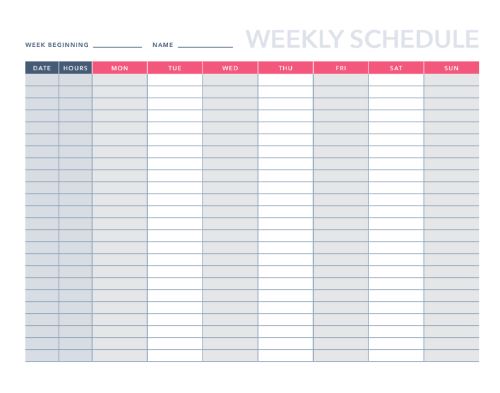
Weekly Schedule Template
Tracking employees’ work time and wages is easy with this free weekly schedule template.
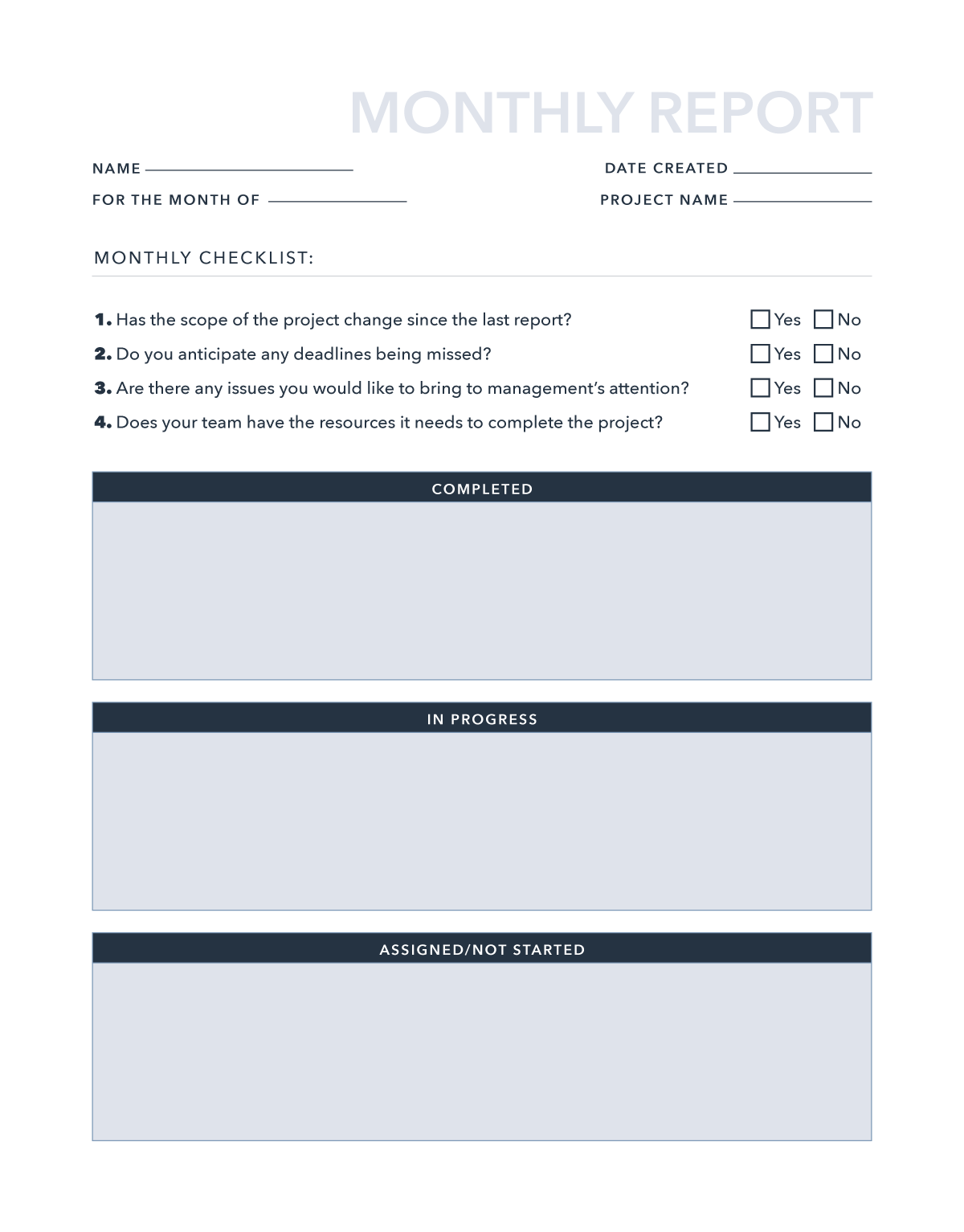
Monthly Report
Provide a professional, concise summary of project activities with this monthly report template.

One Page Business Plan
Need to write a business plan but don’t know where to begin? Download our free 1-page business plan ...
3 Free Agency | Business Plans | PDF Templates & Examples
All agency | business plans | pdf business templates..
Showing 1 - 3 of 3

Simple Business Plan Template
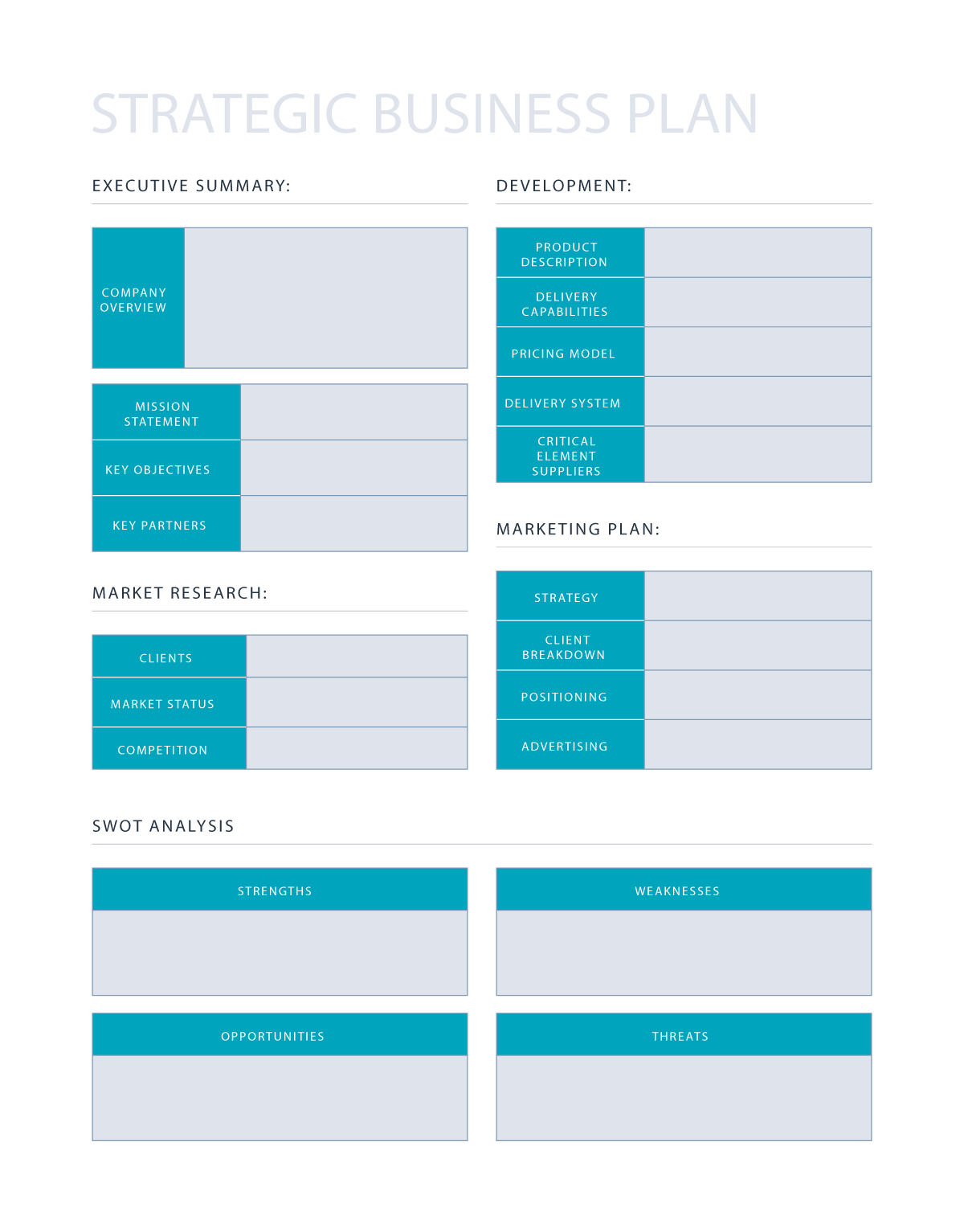
Strategic Planning
Explore template collections.

Customer Service

Spreadsheets

Get all Agency | Business Plans | PDF templates and more.
The Ultimate Guide to Pick the Perfect Presentation Design Agency For You

For companies and organizations all over the world, presentations are invaluable tools for better communicating with important stakeholders, and that’s precisely why many consider them a crucial investment.
But if you want truly outstanding results and to make it worth it, investing some time in searching for the right presentation design agency is a must . After all, it’s your name and your work that others will judge if those slides end up sloppy.

If you're thinking of hiring someone to tackle your presentation needs, here you’ll find a complete guide on how to pick the right agency for you . We’ll go point by point over all the things you should take into consideration when evaluating a presentation design service, like:
- How to determine your presentation design needs
- What types of presentation design services are there
- Where to find presentation design services
- What criteria you should consider when choosing a design agency
- How a good presentation design service looks like
By the end of this article, you’ll have all the necessary tools to pick the perfect presentation design agency and take your slides to the next level.

What presentation design service do YOU Need?
The first step in choosing the right presentation design agency is to understand your design needs . Things like the number of slides you’d need, your project scope, your design preferences, and your style; these are all key to picking the right agency for you.
Here are some of the aspects you should have a clear understanding of when it comes to your presentation design needs:
- Recurrence : Do you need one-time help with a high-impact presentation, or will it be a recurrent task? Knowing exactly what kind of support you’ll need will make it easier to define if you should hire a freelancer, splurge on a pitch-deck expert, or consider a design subscription package.
- Project type and scope : Presentation slides can be used for many things, like pitches, reports, or training. Determining what kind of presentations you’ll be working on will allow you to look for presentation design services with experience in that specific area.
- Turnaround times : Delivery dates can vary greatly depending on the type of presentation design services. Some design agencies will work on the design hand in hand with your team with month-long delivery dates for a single strategic presentation. Others will offer 24 hours to implement your branding into dozens of slides. Being honest with yourself about your turnaround time expectations is crucial to picking the right presentation design agency.
- Design Style and Brand Guidelines : Your presentations introduce people to your brand, so your slides must reflect your image, too. When picking a presentation design agency, look into the styles they’ve worked with before. Seeing if it’s a good fit from the style perspective will help you make a better decision.
- Data Security : If your presentations include sensitive information, you must consider what security measures each presentation design service offers when choosing the right one. Hiring one-time freelancers, for example, might not be the right choice for you.
- In-house team, workflow, and scope : How many people are involved in this project, and who will have a say in the presentation(s) needed? When choosing a design agency, it's crucial to pick one that can easily involve all the project stakeholders. Consider how each design service would integrate with your own workflow and team to guarantee you’re picking the best possible presentation design agency for your needs.
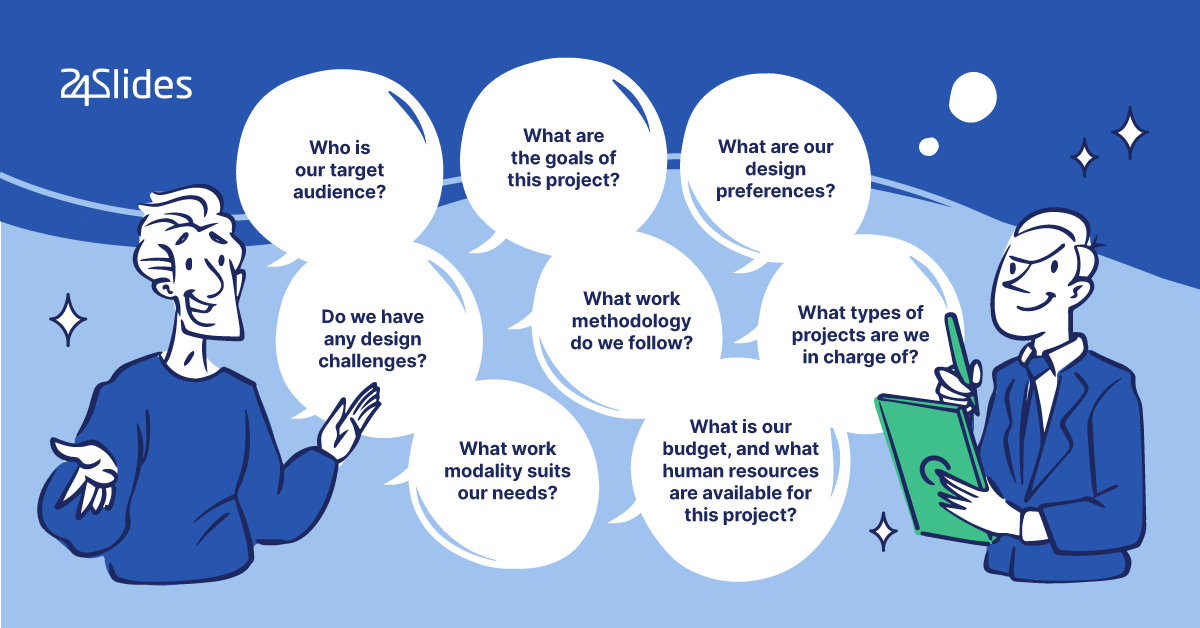
If you’re having trouble defining your design needs or need a more in-depth explanation, you might also want to consider these 8 Critical Questions to Ask Before Hiring a Presentation Design Agency .
Types of Presentation Design Services
Now that you have a comprehensive understanding of your needs, it’s time to evaluate what kind of service would work best for you.
There are several different options for anyone looking to get specialized presentation design support:
- In-house designers : This is a great option for those who want to have someone on payroll to work on presentations continuously. However, in-house designers come with some acute pros and cons . It might require a high investment in terms of recruiting and training, and if you don’t have a stable workload of presentations, you might end up juggling between an overworked employee and slow weeks or months. On the other hand, hiring an in-house designer is great for having more control over your brand and security measures.
- Freelancers : Freelancers are great for one-time presentation needs, as they’re easy to find, and you can find a wide variety of prices for all budgets. However, finding a good freelancer can be a bit of a trial-and-error process, and it can be a chore to find one that fits your design style and workflow. Freelancers might also not be the best pick if you have recurrent projects, as their availability might be limited.
- Presentation design agencies : Specialized agencies for presentation design are a great option for organizations that want to make the most out of their presentations. You can rely on their expertise and commitment, as they are often hired by big brands to tackle their slide demands. Just like freelancers, you’ll find a wide array of presentation design agencies , from ones that focus on expensive once-in-a-lifetime presentations to ones focused on quick delivery dates and brand implementation on a large scale.
- Subscription and credit packages : You might be surprised to know that you can also get professional presentation design as a subscription model! For those who work with big teams and need a constant flow of presentation slides, a presentation design subscription is the perfect way to ensure that all your team members are aligned on presentation design. Scalability is the name of the game, so look for design agencies that can provide you with packages or subscriptions that fit your slide workload and your team’s workflow to make a truly efficient partnership.
Now that you have a detailed understanding of your design needs and the options available, you should be able to determine which type of service would work best for you and begin looking for specific providers.
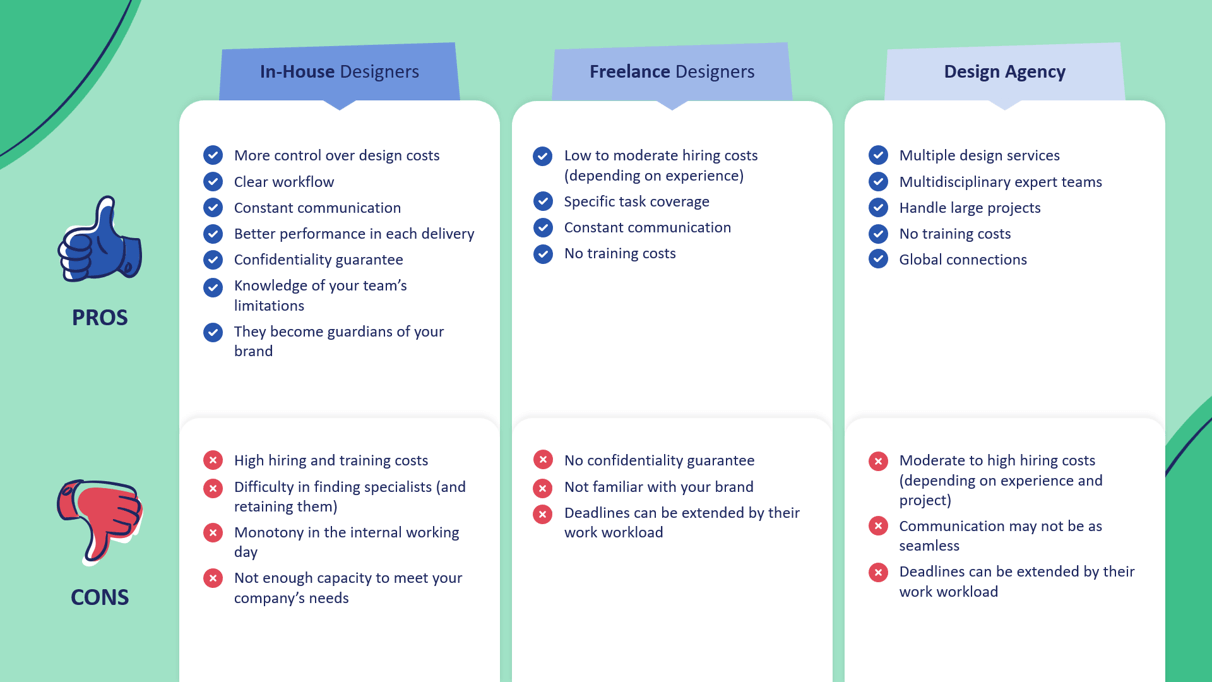
If you’re still indecisive, don’t worry! Give a look at our In-house Design Teams vs. Agency vs. Freelancer Overview to get all the detailed pros and cons of each type of service.
Where Can I Find Presentation Design Services and Agencies?
If you’re ready to start looking for presentation design providers but are unsure where to start, here are a couple of ideas.
- Freelancer presentation designers are easily available on sites like Fiverr or Upwork , where you can also see some of their works and reviews from previous clients.
- For hiring in-house presentation designers, you’ll probably need to do a deep scouting process to find the right designer who has the right skill set and is a good culture fit for your company. As not many designers choose to specialize in just presentation design, keep an open mind to other types of designers, but know that you’d probably need to build presentation design skills from the ground up.
- For presentation design agencies, review sites like G2 and Trustpilot are great starting points for looking for reliable slide design services.
- You can use social media to look for presentation designs that catch your eye, and you’ll probably find the artist behind those slides as well! Give a look around on Linkedin , Instagram , or even Pinterest for outstanding presentation design.
- Networking is also a great way to get a feel for what other companies are doing. Reach out to your industry contacts, and stay on the lookout for case studies and testimonials of brands and companies you like.
Looking for a place to begin your search for the perfect presentation design agency? Our detailed industry research led us to the Best 15 Design Agencies & Services of 2024 — complete with prices, customers, areas of expertise, and much more!
7 Crucial Criteria to Choose the Right Presentation Design Agency
Now that you’ve begun your research, you probably have at least a couple of options for covering your presentation design needs. The question now is, how to make sure you’re choosing the best possible option for you?
In our experience of 10+ years as the biggest presentation design provider worldwide, these are the criteria we’ve seen come the most into play when it comes to picking the perfect presentation design agency for you:
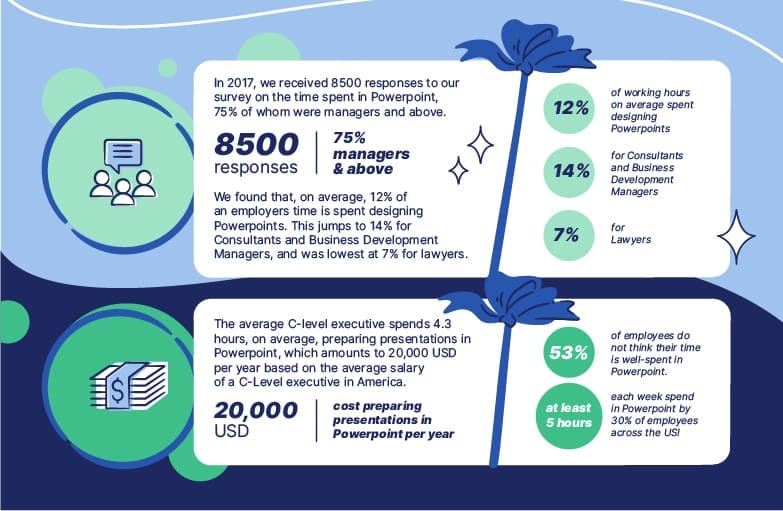
First of all, you must consider your budget . This is the very first criterion that will help you veto which design services you can realistically consider. The larger your budget, the more options you'll find for design services and personalized services.
But don’t worry! You’ll find great presentation design services for almost any budget. However, don’t pick the cheapest option just because. When considering which presentation design service to choose, the key is to look at the whole picture and focus on the best value-for-money option .
A good idea is to evaluate how much you’re currently spending on your presentation design. Even if you haven’t hired anyone to target presentation design, it’s still taking a toll on you and your team's time and resources .
With our handy PowerPoint hidden cost calculator , you can visualize how much you’re currently spending on your own in presentation design and contrast it with your current options to make a better decision in terms of pricing!
2. Confidentiality Policies
This is another criterion that will help you rule out some of your options. In this era of cyber-attacks and data breaches, you should only work with a provider that can prove its security—especially if your presentations contain internal or confidential information from your company.
In order to know if your data and files are in good hands, we recommend you ask for your provider’s security policy . You should consider them a viable presentation provider only if they are 100% safe to work with your data!
3. Turnaround Times
If your options all comply with your pricing and your security requirements, turnaround times are the next key aspect you should consider when picking the right presentation design agency.
In the world of presentations, leaving the design for the last minute is very common. A PowerPoint design agency with a speedy delivery can get you out of trouble. Also, receiving your presentation orders quickly gives you the chance to ask for edits if needed!
Ask yourself how quickly you’ll need your presentations delivered. Big concept agencies that polish their slides for months might be great for once-in-a-lifetime presentations, but not if you need new presentations every week!
4. Expertise
When researching different options on the market, you will find all types of presentation design agencies. That’s why another factor to evaluate is the agency's expertise, meaning the skills of the design team and the services available .
For example, there are agencies that specialize in creating pitch decks, while others have more experience creating eLearning solutions. Research previous customers carefully for each presentation design service, or talk directly with a salesperson to see if they will be able to keep up with your needs.
While this might seem like a bothersome task, it will help you filter through options and choose the ideal presentation design service.
5. Portfolio
If you’re on the fence with two or more presentation design agencies, looking at their portfolio might be the one thing that helps you define which one is a better pick.
Look at their previous works and projects to evaluate how well your style can fit with yours. Even if you don’t have a direct correlation to what you’re looking for, a portfolio will also allow you to gauge their versatility and adaptability to different projects and styles.
6. Customer Support
Customer support service plays a critical role when creating a presentation deck, and a good presentation design company will have clear communication channels that let you convey your vision clearly.
Sometimes, you can talk directly to the designers and other times; the contact is through an intermediary like a project manager. Whatever the case, it’s crucial that you confirm you’ll have someone available to resolve any concerns regarding your order.
7. Positive Reviews
Last but not least, checking their customer feedback is another way to verify the quality of the agency's service. While reviews are not always trustworthy, looking through them can still be a great way to look for reg flags and determine if they can regularly fulfill their expectations.
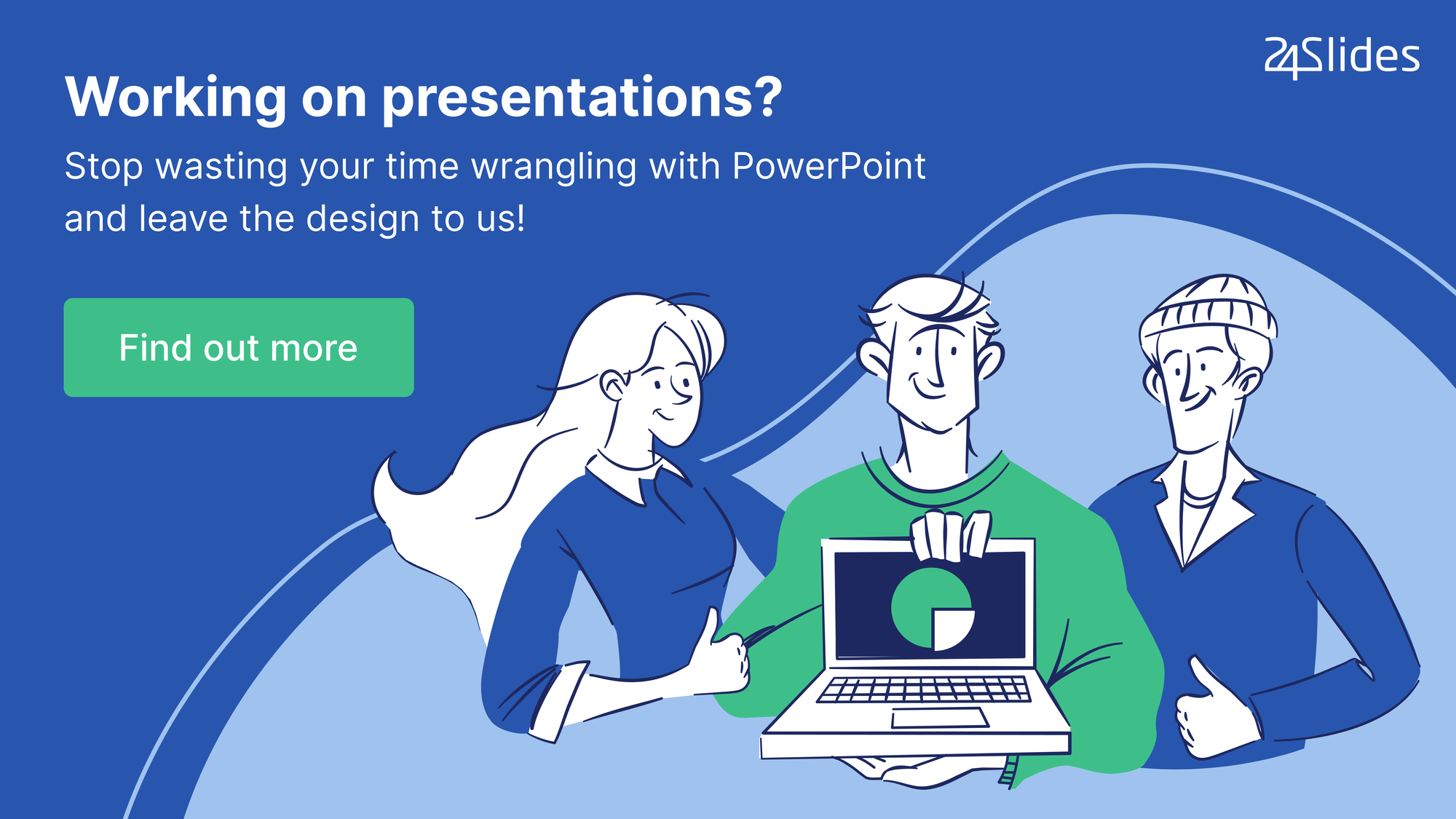
What Does Hiring a Presentation Design Agency Look Like?
If you’re close to making your final decision on which presentation design service to pick, you might be wondering, “So, how would it all work? Do I just send my slides their way? Sign a contract or an NDA? How can I ensure they follow my brand guidelines? Or keep to the budget?”
What a good presentation design service looks like depends on the type of service you choose. Freelancers will probably have more direct communication and will determine the project's scope and due dates beforehand, but their processes and reliability will change on a case-to-case basis.
On the other hand, presentation design agencies that are prepared to handle customers who require high amounts of slides on short notice should have standardized procedures to guarantee the satisfaction and compliance of every order .

In 24Slides, we work with a tight-knit team of customer support specialists who guarantee that clients have a customized solution that fits their needs and are satisfied with their deliverables.
With a team of over 200+ designers and customers all around the world, we’re committed to creating the best possible process to ensure that all projects are delivered on time and with a 100% satisfaction guarantee.
Subscription package customers are assigned a project manager to handle all account matters, like credit capacity, and a design manager, who works with a team of expert designers to learn everything about their brand and create presentation slides according to their requirements.
24Slides’ subscription services are also managed by a Customer Success Manager who ensures a detailed onboarding process and a seamless workflow with your team to help you make the most out of the partnership.
A good onboarding process and open channels of communication are the key things to take into account for presentation design services that aim to balance quality and speed!
Hopefully, this article has given you a better idea of what to look for when choosing the right presentation design agency for you.
In short, whatever presentation design service you decide on should be able to cover these crucial points:
- Within budget - if you can’t pay their service fee, it’s not a good option!
- Reliable - you should be able to trust they are going to deliver on the expected dates.
- Secure - you should have no doubts that your data is in safe hands.
- Quality proven - having a quality standard and expertise assurance will make you able to rely that you’ll get exactly what you need every time
- Easily contactable - in case of any eventuality of complication, effective communication channels are a must
Take it step-by-step and research your options to ensure you find the perfect partner for your presentation design needs.
Still worried about how it would work? For just $1, you can try 24Slides services and see how a presentation design agency can help you!

Looking for more? You might also like these articles:
- Discover the Top 15 Presentation Design Agencies & Services to Use in 2024
- 8 Questions to Ask Before Hiring a Presentation Design Agency
- The Complete Guide to Outsourcing Design Work
- In-house Design Teams vs. Agency vs. Freelancer: Choosing the Right Set-Up
- Final Review: Pros and Cons of Today’s In-house Design Teams
Create professional presentations online
Other people also read

How To Write Effective Emails That Will Improve Your Communi...

How to Make a Marketing Plan Presentation in PowerPoint

Alternative presentation styles: Takahashi


How to Start a Marketing Agency

Starting a marketing agency can be very profitable. With proper planning, execution and hard work, you can enjoy great success. Below you will learn the keys to launching a successful marketing agency.
Importantly, a critical step in starting a marketing agency is to complete your business plan. To help you out, you should download Growthink’s Ultimate Business Plan Template here .
Download our Ultimate Business Plan Template here
14 Steps To Start a Marketing Agency :
- Choose the Name for Your Marketing Agency
- Develop Your Marketing Agency Plan
- Choose the Legal Structure for Your Marketing Agency
- Secure Startup Funding for Your Marketing Agency (If Needed)
- Secure a Location for Your Business
- Register Your Marketing Agency with the IRS
- Open a Business Bank Account
- Get a Business Credit Card
- Get the Required Business Licenses and Permits
- Get Business Insurance for Your Marketing Agency
- Buy or Lease the Right Marketing Agency Equipment
- Develop Your Marketing Agency Marketing Materials
- Purchase and Setup the Software Needed to Run Your Marketing Agency
- Open for Business
1. Choose the Name for Your Marketing Agency
The first step to starting a marketing agency is to choose your business’ name.
This is a very important choice since your company name is your brand and will last for the lifetime of your business. Ideally you choose a name that is meaningful and memorable. Here are some tips for choosing a name for your marketing agency:
- Make sure the name is available . Check your desired name against trademark databases and your state’s list of registered business names to see if it’s available. Also check to see if a suitable domain name is available.
- Keep it simple . The best names are usually ones that are easy to remember, pronounce and spell.
- Think about marketing . Come up with a name that reflects the desired brand and/or focus of your own business.
2. Develop Your Marketing Agency Plan
One of the most important steps in starting a marketing agency is to develop your simple business plan template . The process of creating your plan ensures that you fully understand your market and your business strategy. The plan also provides you with a roadmap to follow and if needed, to present to funding sources to raise capital for your business.
Your business plan should include the following sections:
- Executive Summary – this section should summarize your entire business plan so readers can quickly understand the key details of your marketing business.
- Company Overview – this section tells the reader about the history of your marketing agency and what type of marketing agency you operate. For example, are you an advertising agency, a public relations firm, or an interactive agency?
- Industry Analysis – here you will document key information about the marketing industry. Conduct market research and document how big the industry is and what trends are affecting it.
- Customer Analysis – in this section, you will document who your ideal or target audience are and their demographics. For example, how old are they? Where do they live? What do they find important when purchasing services like the ones you will offer?
- Competitive Analysis – here you will document the key direct and indirect competitors you will face and how you will build competitive advantage.
- Marketing Plan – your marketing strategy should address the 4Ps: Product, Price, Promotions and Place.
- Product : Determine and document what products/services you will offer
- Prices : Document the prices of your products/services
- Place : Where will your business be located and how will that location help you increase sales?
- Promotions : What promotional methods will you use to attract customers to your own agency? For example, you might decide to use pay-per-click advertising, public relations, search engine optimization and/or social media marketing.
- Operations Plan – here you will determine the key processes you will need to run your day-to-day operations. You will also determine your staffing needs. Finally, in this section of your plan, you will create a projected growth timeline showing the milestones you hope to achieve in the coming years.
- Management Team – this section details the background of your company’s management team.
- Financial Plan – finally, the financial plan answers questions including the following:
- What startup costs will you incur?
- How will your marketing agency make money?
- What are your projected sales and expenses for the next five years?
- Do you need to raise funding to launch your business?
Finish Your Business Plan Today!
3. choose the legal structure for your marketing agency.
Next you need to choose a legal structure for your marketing agency and register it and your business name with the Secretary of State in each state where you operate your business.
Below are the five most common legal structures:
1) Sole proprietorship
A sole proprietorship is a business entity in which the owner of the marketing agency and the business are the same legal person. The owner of a sole proprietorship is responsible for all debts and obligations of the business. There are no formalities required to establish a sole proprietorship, and it is easy to set up and operate. The main advantage of a sole proprietorship is that it is simple and inexpensive to establish. The main disadvantage is that the owner is liable for all debts and obligations of the business.
2) Partnerships
A partnership is a legal structure that is popular among small businesses. It is an agreement between two or more people who want to start a marketing agency together. The partners share in the profits and losses of the business.
The advantages of a partnership are that it is easy to set up, and the partners share in the profits and losses of the business. The disadvantages of a partnership are that the partners are jointly liable for the debts of the business, and disagreements between partners can be difficult to resolve.
3) Limited Liability Company (LLC)
A limited liability company, or LLC, is a type of business entity that provides limited liability to its owners. This means that the owners of an LLC are not personally responsible for the debts and liabilities of the business. The advantages of an LLC for a marketing agency include flexibility in management, pass-through taxation (avoids double taxation as explained below), and limited personal liability. The disadvantages of an LLC include lack of availability in some states and self-employment taxes.
4) C Corporation
A C Corporation is a business entity that is separate from its owners. It has its own tax ID and can have shareholders. The main advantage of a C Corporation for a marketing agency is that it offers limited liability to its owners. This means that the owners are not personally responsible for the debts and liabilities of the business. The disadvantage is that C Corporations are subject to double taxation. This means that the corporation pays taxes on its profits, and the shareholders also pay taxes on their dividends.
5) S Corporation
An S Corporation is a type of corporation that provides its owners with limited liability protection and allows them to pass their business income through to their personal income tax returns, thus avoiding double taxation. There are several limitations on S Corporations including the number of shareholders they can have among others.
Once you register your marketing agency, your state will send you your official “Articles of Incorporation.” You will need this among other documentation when establishing your banking account (see below). We recommend that you consult an attorney in determining which legal structure is best suited for your company.
Incorporate Your Business at the Guaranteed Lowest Price
We are proud to have partnered with Business Rocket to help you incorporate your business at the lowest price, guaranteed.
Not only does BusinessRocket have a 4.9 out of 5 rating on TrustPilot (with over 1,000 reviews) because of their amazing quality…but they also guarantee the most affordable incorporation packages and the fastest processing time in the industry.
4. Secure Startup Funding for Your Marketing Agency (If Needed)
In developing your marketing agency plan, you might have determined that you need to raise funding to launch your business.
If so, the main sources of funding for a marketing agency to consider are personal savings, family and friends, credit card financing, bank loans, crowdfunding and angel investors. Angel investors are individuals who provide capital to early-stage businesses. Angel investors typically will invest in a marketing agency that they believe has high potential for growth.
5. Secure a Location for Your Business
When starting a marketing agency, there are numerous things you need to take into account. One of the most important is finding a location for your business. Here are a few tips on how to find the perfect spot for your new marketing firm:
- Decide what type of location you need.
Do you need an office in a trendy part of town, or will a more industrial area suffice? Do you need space for clients to come and meet with you, or is a remote office okay?
- Narrow down your search.
Once you know what type of location you need, start narrowing down your search. Consider the cost of rent, the availability of parking, and the proximity to potential clients.
- Tour the locations.
Once you’ve found a few promising locations, take the time to tour them. This will give you a better idea of what each space has to offer and whether it meets your needs.
- Consider your budget.
Renting office space can be expensive, so make sure you factor this into your decision-making process. If you’re on a tight budget, consider working from home or finding a space that’s shared with other businesses.
- Make a final decision.
When you’ve weighed all the pros and cons, make a final decision about where to locate your marketing agency. This is an important decision, so take your time and make sure you’re making the best choice for your business.
Use these tips to find the perfect spot for your business and get your new venture off the ground.
6. Register Your Marketing Agency with the IRS
Next, you need to register your business with the Internal Revenue Service (IRS) which will result in the IRS issuing you an Employer Identification Number (EIN).
Most banks will require you to have an EIN in order to open up an account. In addition, in order to hire employees, you will need an EIN since that is how the IRS tracks your payroll tax payments.
Note that if you are a sole proprietor without employees, you generally do not need to get an EIN. Rather, you would use your social security number (instead of your EIN) as your taxpayer identification number.
7. Open a Business Bank Account
It is important to establish a bank account in your marketing agency’s name. This process is fairly simple and involves the following steps:
- Identify and contact the bank you want to use
- Gather and present the required documents (generally include your company’s Articles of Incorporation, driver’s license or passport, and proof of address)
- Complete the bank’s application form and provide all relevant information
- Meet with a banker to discuss your business needs and establish a relationship with them
8. Get a Business Credit Card
You should get a business credit card for your marketing agency to help you separate personal and business expenses.
You can either apply for a business credit card through your bank or apply for one through a credit card company.
When you’re applying for a business credit card, you’ll need to provide some information about your business. This includes the name of your business, the address of your business, and the type of business you’re running. You’ll also need to provide some information about yourself, including your name, Social Security number, and date of birth.
Once you’ve been approved for a business credit card, you’ll be able to use it to make purchases for your business. You can also use it to build your credit history which could be very important in securing loans and getting credit lines for your business in the future.
9. Get the Required Business Licenses and Permits
In order to start a marketing agency, you will need a business license and a permit to operate as a marketing agency. You may also need to register your business with the state, county, or city. Reach out to your local government office for more information on what licenses and permits you will need to start your marketing agency.
10. Get Business Insurance for Your Marketing Agency
The type of insurance you need to operate a marketing agency will depend on the type of business you are running.
Some business insurance policies you should consider for your marketing agency include:
- General liability insurance : This covers accidents and injuries that occur on your property. It also covers damages caused by your employees or products.
- Auto insurance : If a vehicle is used in your business, this type of insurance will cover if a vehicle is damaged or stolen.
- Workers’ compensation insurance : If you have employees, this type of policy works with your general liability policy to protect against workplace injuries and accidents. It also covers medical expenses and lost wages.
- Commercial property insurance : This covers damage to your property caused by fire, theft, or vandalism.
- Business interruption insurance : This covers lost income and expenses if your business is forced to close due to a covered event.
- Professional liability insurance : This protects your business against claims of professional negligence.
Find an insurance agent, tell them about your business and its needs, and they will recommend policies that fit those needs.
11. Buy or Lease the Right Marketing Agency Equipment
The equipment you need to run your marketing agency will depend on the services you offer. However, there are some basics that you will need:
– A computer
– A phone
– A mailing address
– Some tables and chairs for meeting with clients and employees
– Basic office supplies like pens, paper, and printer
12. Develop Your Marketing Agency Marketing Materials
Marketing materials will be required to attract and retain customers to your marketing agency.
The key marketing materials you will need are as follows:
- Logo : Spend some time developing a good logo for your marketing agency. Your logo will be printed on company stationery, business cards, marketing materials and so forth. The right logo can increase customer trust and awareness of your brand.
- Website : Likewise, a professional marketing agency website provides prospective clients with information about the services you offer, your company’s history, and contact information. Importantly, remember that the look and feel of your website will affect how customers perceive you.
- Social Media Accounts : establish social media accounts in your company’s name. Accounts on Facebook, Twitter, LinkedIn and/or other social media networks will help customers and others find and interact with your marketing agency.
13. Purchase and Setup the Software Needed to Run Your Marketing Agency
The software that is needed to run a marketing agency is:
-Email marketing software
-Social media management software
-Customer relationship management (CRM) System
-Website builder
-Google AdWords and analytics tools
14. Open for Business
You are now ready to open your marketing agency. If you followed the steps above, you should be in a great position to build a successful business. Below are answers to frequently asked questions that might further help you.
Additional Resources
Marketing Agency Mavericks
How to Finish Your Ultimate Business Plan in 1 Day!
Don’t you wish there was a faster, easier way to finish your marketing agency business plan?
With Growthink’s Ultimate Business Plan Template you can finish your plan in just 8 hours or less!
How to Start a Marketing Agency FAQs
Is it hard to start a marketing agency.
There is no one-size-fits-all answer to this question, as the ease or difficulty of starting a marketing agency will vary depending on your skills, experience, and resources.
However, if you follow the steps above, you should be able to start your marketing agency without too much difficulty.
How can I start a marketing agency with no experience?
If you're looking to start a marketing company with no experience there are a few key things to consider. First, you'll need to come up with a business plan and strategy for your agency. This will help you outline your goals and objectives, as well as how you plan on achieving them. You'll also need to create a branding strategy for your agency, and make sure you have a strong online presence. Additionally, it's important to build a team of talented marketing professionals to help you to achieve your goals. By following these tips, you can start a successful marketing agency with no experience.
What type of marketing agency is most profitable?
There is no one-size-fits-all answer to this question, as the most profitable type of marketing agency will vary depending on your specific goals and needs. However, a full-service agency that can offer a comprehensive range of services is often the most successful option. Such an agency can provide everything from branding and advertising to website design and search engine optimization (SEO). By contrast, a niche marketing agency that specializes in a single type of service to generate leads (such as social media marketing) may not be as profitable, as it will not be able to offer a comprehensive suite of services.
How much does it cost to start a marketing agency?
Starting your own marketing agency typically costs between $10,000 and $50,000, depending on the size and scope of your business. However, if you're willing to bootstrap your agency (i.e., start without any outside investment), you can get started for as little as $1,000.
The startup costs for a marketing agency include:
-Domain name and website hosting
-Marketing materials (e.g., business cards, letterhead, signage)
-Office space and equipment
-Software licenses and subscriptions
-Professional services (e.g., legal, accounting, marketing)
-Employee salaries
What are the ongoing expenses for a marketing agency?
There are a few main ongoing expenses for a marketing agency. One of the most substantial expenses will be your employees' salaries. Marketing materials are another significant expense. Agencies need to constantly produce new content and designs to stay visible in the market. Technology expenses are also a typical cost for agencies. They need to have up-to-date software and hardware to be effective. Finally, agencies need to pay for office space and other overhead costs. These expenses can add up quickly, so agencies need to stay mindful of their spending.
How does a marketing agency make money?
Marketing agencies make money by developing and implementing marketing strategies to help businesses grow. They provide planning, advertising, branding, consulting, content marketing , digital marketing , research, and analytics services. Another way marketing businesses make money is through additional fees associated with their services. For example, an agency may charge a business a percentage of the total marketing budget for planning and implementation services. Finally, some agencies earn commissions by referring clients to other service providers, such as web design firms or printing companies.
Is owning a marketing agency profitable?
There are a few reasons owning a marketing agency can be profitable. First, agencies typically have low overhead costs, as they often work from home or remotely. Additionally, agencies tend to have a large pool of potential clients, as almost every business needs marketing services at some point. Finally, agencies can be very flexible in terms of the services they offer, which allows them to cater to a wide range of clients. This flexibility also means that agencies can grow or shrink their services as needed, which helps them stay profitable even in tough economic times. Altogether, these factors contribute to making a marketing agency a lucrative business venture.
Why do marketing agencies fail?
Some marketing agencies fail because of poor business models . They are often staffed with people who have never worked in marketing before. This can lead to risky decisions and failure.
Another reason marketing agencies fail is because they are overpromising and not able to deliver. This can be due to lack of experience, lack of resources, or both.
Third, many marketing agencies focus on acquiring new clients rather than nurturing the ones they have. This can lead to a loss in business once the new clients realize that the agency isn't actually meeting their needs.
Lastly, marketing agencies may fail when they are run by people who are more interested in making money than in providing quality services. This can lead to a lot of wasted time and resources, and can eventually spell doom for the business.
Other Helpful Business Plan Articles & Templates

Money blog: What will happen to tax and interest rates under Labour – and how will benefits change? | Join our live Q&A
Business presenter Ian King answered your questions on what a Labour government means for your personal finances, here in the Money blog.
Monday 8 July 2024 18:35, UK
- Ian King answered your questions on what a Labour government means for your personal finances in a live Q&A earlier - scroll through his answers below
- Publicans hit out at Co-op for 'disgraceful' TV advert
- 'Price war well and truly on' as two major lenders announce mortgage rate cuts
- Protesters soak tourists with water guns in Barcelona
- UK's best holiday parks named - with Pontins and Butlins named as two of worst
Money blog essential reads
- Best deals on school uniform ahead of new academic year
- Money Problem: 'I booked holiday but might not renew my current travel insurance before I go - will it still cover this holiday?'
- Savings Guide: Savers have a rare opportunity - but it might be the last hurrah
- Cheap Eats : Two Michelin-starred chef reveals his favourites in Birmingham
- Best of the Money blog - an archive
Ask a question or make a comment
Thanks for all your questions - and for following Ian King's responses on the likely changes we can expect under the new Labour government.
If you could not join us in time, do not worry - you can scroll through the answers below at your leisure.
Dad of Swifties:
Why don't the government remove VAT on concert tickets like in other countries and announce stronger regulation on sites like Ticketmaster? Prices are a joke
Here's what Ian King , our business presenter, says on this one...
Labour promised not to increase the rate of VAT during the election campaign.
That is very different from cutting it or making some products and services tax free.
I'd be surprised if it happened. The government needs to raise money, not give it away.
That said, I note that US Congress has recently been talking about tougher regulation of businesses like Ticketmaster, so doubtless parliamentarians on this side of the Atlantic will be watching closely.
May I ask who is likely to be eligible for the proposed new housing as outlined today? I have a son of 43 and his wife living with us as they can't afford a mortgage, and aren't eligible for social housing. Not everyone in Britain wants the responsibility of owning a house.
Ian King , Sky News business presenter, says...
Labour is aiming for increasing housing availability across the board with a mix of both public/social housing and also private sector accommodation – while also looking to stimulate the "build to rent" sector.
It's not a case of eligibility, as such.
They're seeking to increase supply in the first instance – get that right and demand will be met.
Haven't we heard all this before with housebuilding targets - what's different this time?
Good question – which reminds me that one of the most dangerous phrases in investment and business is "it's different this time".
What genuinely appears to be different is that Labour seem totally committed to sweeping away the planning rules and regulations that stand in the way of more homes being built.
If they can pull this off then, all other things being equal, they will have a fighting chance of completing 1.5 million new homes over the life of this parliament.
The other thing I would say is that this is a hugely ambitious target and so Labour, by making it public, have confidence it can be done.
You can rest assured that Labour will be asked about it a lot towards the next general election.
The political graveyards are littered with those politicians – Harold Macmillan, Conservative prime minister from 1957-1963, is a good example – who made promises on housebuilding they failed to keep.
The last government promised an end to no-fault evictions... is this legislation still alive?
Another short answer from our business presenter Ian King ...
The legislation died with the last government but, yes, the expectation is that Labour will abolish no-fault evictions.
What will Labour do with dividend tax? And what about corporation tax?
Rachel Reeves is already committed to keeping corporation tax unchanged for the life of this parliament.
But no such commitments have been forthcoming on the taxation of dividends.
And some people fear the worst because Labour has form here - Gordon Brown took away tax relief on the dividends that pension funds received on their investments in 1997 - which contributed to the near extinction of gold-plated "defined benefit" or "final salary" pension schemes in the private sector.
In fairness, Labour can point out that the Conservatives also stripped away protections enjoyed by savers on their dividends.
You can now only receive dividends of £500 on shares or investment funds held outside an ISA. The allowance stood at 10 times that just seven years ago.
The moral of the story is clear – if you hold shares or investment funds which pay dividends, protect them in an ISA, which ensures the payouts will be tax-free.
If memory serves me correctly weren't the railways an unmitigated disaster last time they were in public ownership? How is renationalising meant to help anyone?
Here's what Ian King , our business presenter, says to this...
Labour argues that, in state ownership, the rail network can be more coherent with one "fat controller" type figure in charge to oversee timetables and ticketing.
Bear in mind most of the railways more or less have been renationalised already – the exception being the rolling stock companies, which will remain privately owned.
You are right to point out the shortcomings of the nationalised model – as I did in this article for Sky News back in 2017 .
The nationalised model is not a silver bullet – as English and Scottish football supporters to have used Germany's nationalised rail service during the Euros will testify.
We heard nothing in the campaign about how growth would be achieved - how much convincing detail did we get from Reeves?
The UK's sclerotic planning rules have been a major drag on growth over the last decade.
If Labour has found a way of obviating those rules then it should generate growth. But bear in mind this is going to cause huge rows as Whitehall orders local planning managers what to do and rides roughshod over them when they don't co-operate.
Not everyone will like it and especially those who find their views interrupted by, for example, new homes. The same applies to tearing up the rules banning more onshore wind farms.
All other things being equal, it should also be positive for growth, but those who have views of open countryside blighted by new wind turbines may disagree.
Croydon Ajay:
Can anything be done to scrap the disparities in stamp duty which means young buyers in London have to pay when the same people in the North East don't pay a penny?
Stamp duty is a rotten tax and, if you want to promote growth, scrapping it would certainly be a good way of doing so. But given that Stamp Duty Land Tax brought in £11.6bn in the last financial year, the government is likely to want to keep it in place.
The differing tax takes to which you refer reflect the fact that house prices are cheaper in the North East than in London.
SDLT is very much a London tax – the capital accounted for 36% of all SDLT paid in 2021-22, the latest year for which figures are available.
Homebuyers in the London borough of Westminster alone paid more SDLT than the whole of the North West of England. I doubt those disparities to which you refer will change unless house prices in London collapse and house prices rocket elsewhere.
You are right to point out the pernicious effects of this.
In some London boroughs, primary schools are starting to close, because parents find they cannot live in the capital and raise a family. They're moving out – reducing demand for London school places in some areas.
Disgruntled:
Ian can you give us an idea of how much scrapping the two-child benefit cap would cost and why is this not achievable with a windfall tax on oil and gas companies raking it in? Starmer is a Tory with a red rosette
The Resolution Foundation has estimated that the two-child benefit cap will save the government £2.5bn during the current financial year – which would rise to £3.6bn if applied to all families claiming universal credit.
Labour is committed to raising the levy on North Sea oil and gas producers from the current 75% to 78% - and has earmarked the money raised will go towards funding its wider plans for energy and, in particular, decarbonisation.
It would be ill-advised to raise taxes further. The decisions it has made have already had an impact on investment in the North Sea, as I report here .
And don't forget, the cap is not just about saving money. It's also about avoiding awkward newspaper headlines and stories about big families being paid a small fortune in benefits of the kind that embarrassed the last Labour government and angered so many of its traditional working-class supporters in particular.
Be the first to get Breaking News
Install the Sky News app for free


IMAGES
VIDEO
COMMENTS
Traditionally, a marketing plan includes the four P's: Product, Price, Place, and Promotion. For a advertising agency business plan, your marketing plan should include the following: Product: In the product section, you should reiterate the type of advertising agency company that you documented in your Company Analysis.
Download Template. Create a Business Plan. Advertising is an art form and if you are a talented ad artist, there is no better time than today to start your own advertising agency. Be it in digital form or traditional print media form—Ads make an impact. Be it in a storytelling video, copywriting, or carousel form—Ads reign the hold.
Three months of overhead expenses (payroll, rent, utilities): $150,000. Marketing costs: $10,000. Working capital: $10,000. Easily complete your Advertising Agency business plan! Download the Advertising Agency business plan template (including a customizable financial model) to your computer here <-.
Your operations plan should have two distinct sections as follows. Everyday short-term processes include all of the tasks involved in running your digital marketing agency business, including client communication, planning and scheduling advertisement campaigns, staff meetings, billing clients, etc.
Follow these tips to quickly develop a working business plan from this sample. 1. Don't worry about finding an exact match. We have over 550 sample business plan templates. So, make sure the plan is a close match, but don't get hung up on the details. Your business is unique and will differ from any example or template you come across.
Introduction. Starting an advertising agency is an exciting venture, but success requires careful planning. A comprehensive business plan is the foundation of your agency's growth and profitability. In this blog post, we will guide you through the process of creating a well-structured advertising agency business plan that aligns with your goals.
Choose the name of your advertising agency. Mention the type of agency you want to open. Develop a business plan. Choose the location. Register your business. Choose your pricing model. Open a business bank account & get a credit card. Get all required business permits and licenses. Acquire business insurance.
1.1 Mission. Promerit Advertising will offer its customers the best methods and tools in planning and implementing a successful email campaign. Our campaigns will cut through the mumbo jumbo of mass marketing, increase sales, and enhance customer satisfaction with the company. Promerit Advertising email campaigns will grab readers immediately ...
Once you've decided to start your own ad agency, follow these steps. 2. Create a business plan for your advertising agency. Before you can get up and running, you'll need to create a detailed business plan to guide your growth and internal strategy. The three main purposes of a business plan are to establish your business focus, secure ...
A business plan has 2 main parts: a financial forecast outlining the funding requirements of your advertising agency and the expected growth, profits and cash flows for the next 3 to 5 years; and a written part which gives the reader the information needed to decide if they believe the forecast is achievable.
A marketing agency business plan can help you assess the viability of your business idea, set realistic goals, and develop a strategy for achieving them. It can also be a valuable tool for attracting investors and partners. 3. A well-crafted business plan can give you a roadmap to success and help you avoid common pitfalls.
Crafting a comprehensive advertising agency business plan involves several key steps: Concisely summarizes the entire business plan. Highlights key objectives, strategies, and financial ...
All you need is a digital marketing agency business plan to help you get going. Industry Overview. The global digital marketing industry stood at a whopping value of 49.43 billion US dollars in 2020, and with the rapid growth of social media and online business promotions, ...
This funding will cover the purchase of Vihaan Advertising, marketing, purchase of extra software, and hardware. Projected revenues for 1999 to 2001 are $200,000, $1.5 million, and $2.2 million, respectively. Our target is to be the most popular advertisement To unlock help try Upmetrics! .
Step 3: Brainstorm an Advertising Agency Name. Here are some ideas for brainstorming your business name: Short, unique, and catchy names tend to stand out. Names that are easy to say and spell tend to do better. Name should be relevant to your product or service offerings.
First, you'll want to gain experience. As a marketing agency CEO with virtually no marketing experience, you'd be hard-pressed to make insightful recommendations to your clients. The most common ...
The first step in launching a new digital marketing agency is to write a plan. In this guide, we'll cover two of the more traditional ways to define a business plan document with handy downloadable templates: Digital Marketing Agency Business Plan Document (DOCX & PDF) Template. Creative Agency Business Plan Deck (PPTX) Template.
1. Choose the Name for Your Advertising Agency. The first step to starting an advertising agency is to choose your business' name. This is a very important choice since your company name is your brand and will last for the lifetime of your business. Ideally you choose a name that is meaningful and memorable.
Writing an Effective Marketing Agency Business Plan. The following are the key components of a successful marketing agency business plan:. Executive Summary. The executive summary of a marketing agency business plan is a one to two page overview of your entire business plan. It should summarize the main points, which will be presented in full in the rest of your business plan.
A Sample Digital Advertising Agency Business Plan Template. 1. Industry Overview. A standard Advertising agency create advertising campaigns for periodicals, newspapers, radio, TV and other media platforms such as social media. Through internal capabilities or delegating, ad agencies provide advice, creative services, account management ...
The Digital Marketing Agency industry in the United States is valued at over $50 billion, reflecting the critical role of digital marketing in today's business landscape. With a projected compound annual growth rate of 10% over the next five years, the industry is on a steady trajectory of growth, driven by the widespread adoption of digital ...
Sales software. Free and premium plans. Service Hub. Customer service software. Free and premium plans. Content Hub. Content marketing software. Free and premium plans. A collection of professionally designed Agency | Business Plans templates available for PDF. Download, customize, and send in minutes.
Ask yourself how quickly you'll need your presentations delivered. Big concept agencies that polish their slides for months might be great for once-in-a-lifetime presentations, but not if you need new presentations every week! 4. Expertise. When researching different options on the market, you will find all types of presentation design agencies.
The plan falls under the city's new "tiny house" ordinance, which allows units as small as 150 square feet.The Huangs' will be similar to apartments in size. The 24 one-bedroom units will ...
14 Steps To Start a Marketing Agency: Choose the Name for Your Marketing Agency. Develop Your Marketing Agency Plan. Choose the Legal Structure for Your Marketing Agency. Secure Startup Funding for Your Marketing Agency (If Needed) Secure a Location for Your Business. Register Your Marketing Agency with the IRS.
A safety charity has warned England fans against buying cheap electronics online amid a "blitz" of advertising. Electrical Safety First is urging fans bombarded with ads for discounted goods "don ...